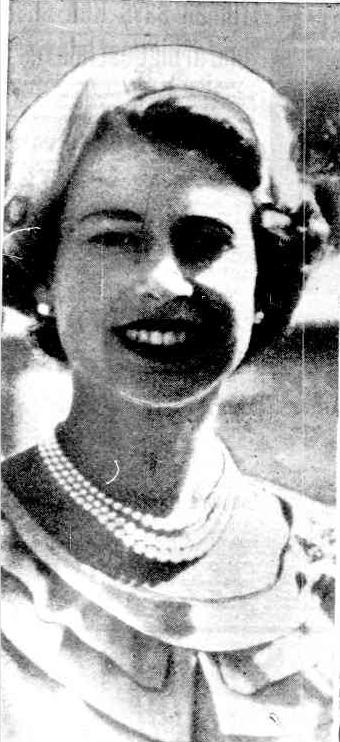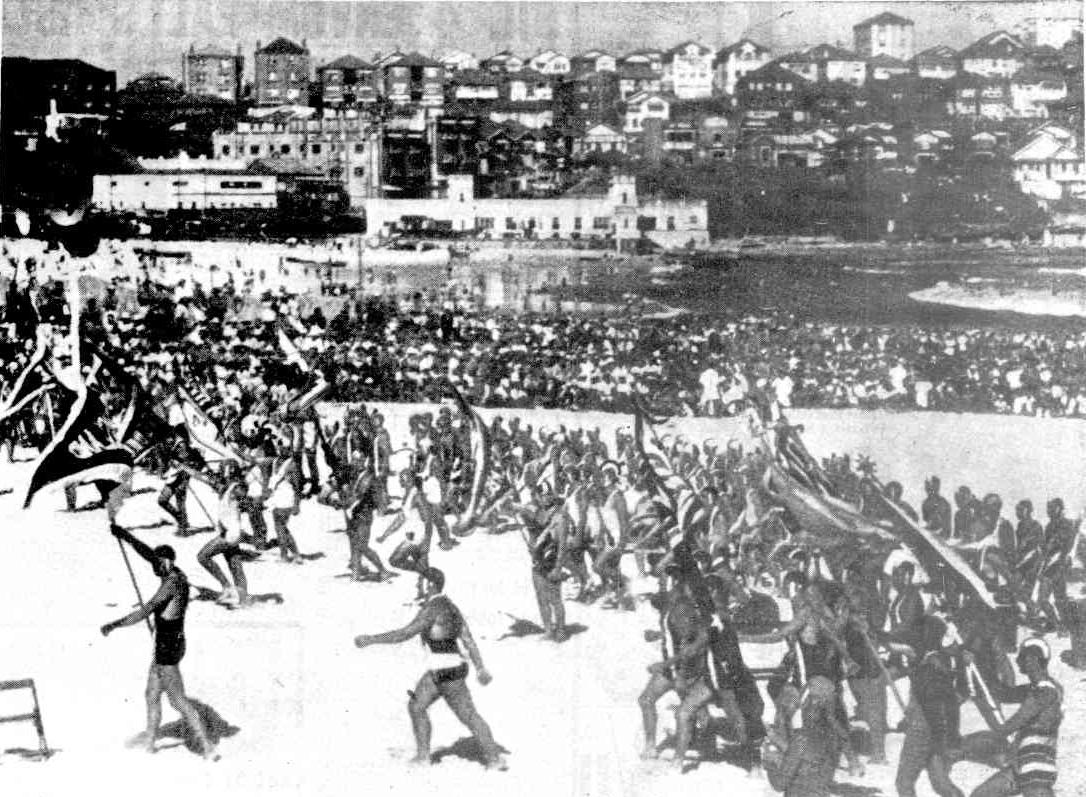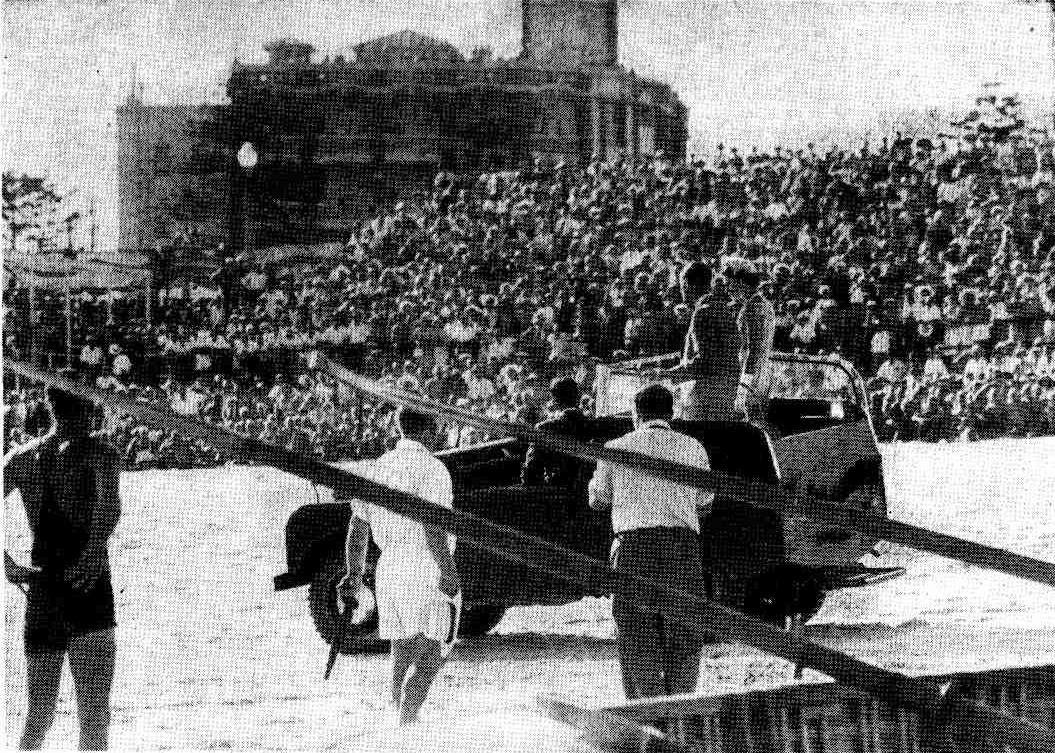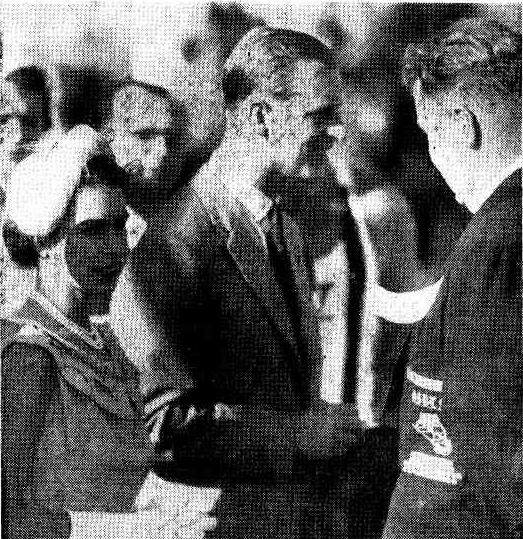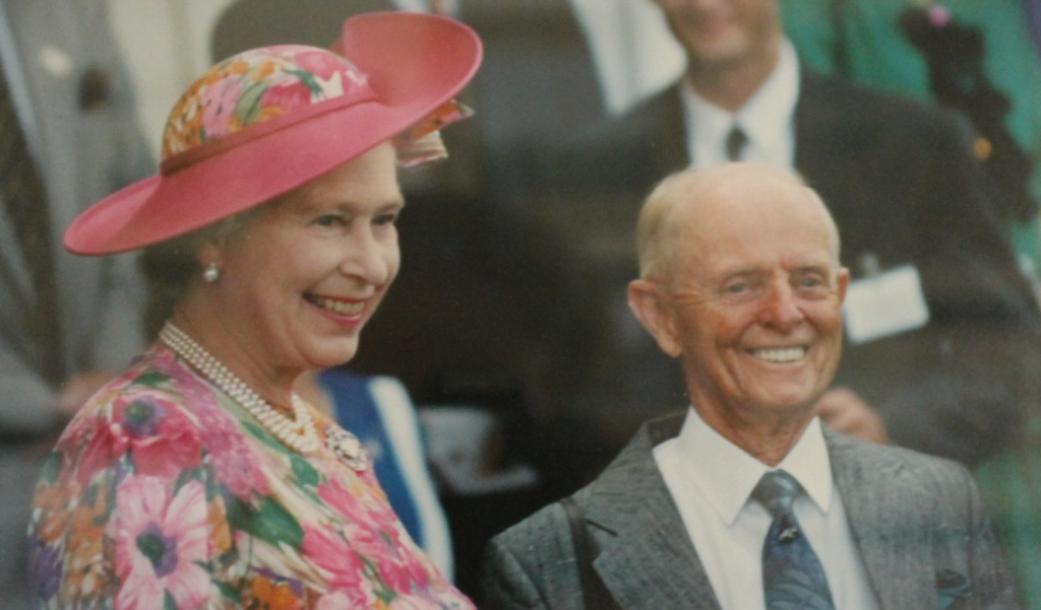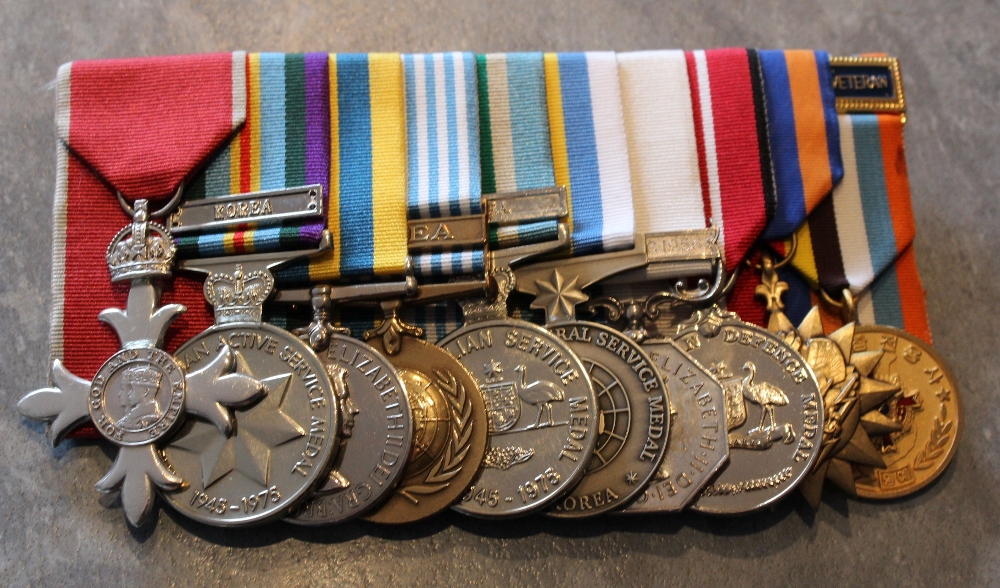her majesty queen elizabeth II - A tribute of local connections
.jpg?timestamp=1662710125935)
Her Majesty during the Queen Elizabeth's Royal Tour - Sydney 1954. Photo: NSW State Records and Archives.
Queen Elizabeth II
1926 - 2022
The Queen died peacefully at Balmoral this afternoon.
The King and The Queen Consort will remain at Balmoral this evening and will return to London tomorrow.
Thursday, 8 September 2022. From: www.royal.ukAn hour later:
A STATEMENT FROM HIS MAJESTY THE KING
AT THE TIME OF THE QUEEN’S DEATH
The death of my beloved Mother, Her Majesty The Queen, is a moment of the greatest sadness for me and all members of my family.
We mourn profoundly the passing of a cherished Sovereign and a much-loved Mother. I know her loss will be deeply felt throughout the country, the Realms and the Commonwealth, and by countless people around the world.
During this period of mourning and change, my family and I will be comforted and sustained by our knowledge of the respect and deep affection in which The Queen was so widely held.
Thursday, 8 September 2022
His Majesty The King’s address to the Nation and the Commonwealth
Published September 9, 2022, U.K. time
Queen Elizabeth was a life well lived; a promise with destiny kept and she is mourned most deeply in her passing. That promise of lifelong service I renew to you all today.
I speak to you today with feelings of profound sorrow. Throughout her life, Her Majesty The Queen – my beloved Mother – was an inspiration and example to me and to all my family, and we owe her the most heartfelt debt any family can owe to their mother; for her love, affection, guidance, understanding and example. Queen Elizabeth was a life well lived; a promise with destiny kept and she is mourned most deeply in her passing. That promise of lifelong service I renew to you all today.
Alongside the personal grief that all my family are feeling, we also share with so many of you in the United Kingdom, in all the countries where The Queen was Head of State, in the Commonwealth and across the world, a deep sense of gratitude for the more than seventy years in which my Mother, as Queen, served the people of so many nations. In 1947, on her twenty-first birthday, she pledged in a broadcast from Cape Town to the Commonwealth to devote her life, whether it be short or long, to the service of her peoples. That was more than a promise: it was a profound personal commitment which defined her whole life. She made sacrifices for duty. Her dedication and devotion as Sovereign never waivered, through times of change and progress, through times of joy and celebration, and through times of sadness and loss. In her life of service we saw that abiding love of tradition, together with that fearless embrace of progress, which make us great as Nations. The affection, admiration and respect she inspired became the hallmark of her reign. And, as every member of my family can testify, she combined these qualities with warmth, humour and an unerring ability always to see the best in people. I pay tribute to my Mother’s memory and I honour her life of service. I know that her death brings great sadness to so many of you and I share that sense of loss, beyond measure, with you all.
The role and the duties of Monarchy also remain, as does the Sovereign’s particular relationship and responsibility towards the Church of England – the Church in which my own faith is so deeply rooted. In that faith, and the values it inspires, I have been brought up to cherish a sense of duty to others, and to hold in the greatest respect the precious traditions, freedoms and responsibilities of our unique history and our system of parliamentary government. As The Queen herself did with such unswerving devotion, I too now solemnly pledge myself, throughout the remaining time God grants me, to uphold the Constitutional principles at the heart of our nation. And wherever you may live in the United Kingdom, or in the Realms and territories across the world, and whatever may be your background or beliefs, I shall endeavour to serve you with loyalty, respect and love, as I have throughout my life.
My life will of course change as I take up my new responsibilities. It will no longer be possible for me to give so much of my time and energies to the charities and issues for which I care so deeply. But I know this important work will go on in the trusted hands of others.
This is also a time of change for my family. I count on the loving help of my darling wife, Camilla. In recognition of her own loyal public service since our marriage seventeen years ago, she becomes my Queen Consort. I know she will bring to the demands of her new role the steadfast devotion to duty on which I have come to rely so much. As my Heir, William now assumes the Scottish titles which have meant so much to me. He succeeds me as Duke of Cornwall and takes on the responsibilities for the Duchy of Cornwall which I have undertaken for more than five decades. Today, I am proud to create him Prince of Wales, Tywysog Cymru, the country whose title I have been so greatly privileged to bear during so much of my life and duty. With Catherine beside him, our new Prince and Princess of Wales will, I know, continue to inspire and lead our national conversations, helping to bring the marginal to the centre ground where vital help can be given. I want also to express my love for Harry and Meghan as they continue to build their lives overseas.
In a little over a week’s time we will come together as a nation, as a Commonwealth and indeed a global community, to lay my beloved mother to rest. In our sorrow, let us remember and draw strength from the light of her example. On behalf of all my family, I can only offer the most sincere and heartfelt thanks for your condolences and support. They mean more to me than I can ever possibly express. And to my darling Mama, as you begin your last great journey to join my dear late Papa, I want simply to say this: thank you. Thank you for your love and devotion to our family and to the family of nations you have served so diligently all these years. May “flights of Angels sing thee to thy rest”.

Our own State and Federal representatives have also paid tribute:
The Hon. Dominic Francis PERROTTET, LLB, BCOM MP, Premier of NSW:
Vale Her Majesty Queen Elizabeth II
On behalf of the people of New South Wales, I extend my deepest sympathies to all members of the Royal family, following the death of Her Majesty Queen Elizabeth II, who has passed away at the age of 96.
Today we reflect on the remarkable life of Her Majesty Queen Elizabeth II.
The young Princess Elizabeth became Queen of England at the age of 25 after the death of her adored father, King George VI, in 1952. Her Coronation took place in Westminster Abbey on 2 June 1953.
Her official title was Her Majesty Elizabeth the Second, by the Grace of God, Queen of Australia and Her other Realms and Territories, Head of the Commonwealth.
Queen Elizabeth II went on to become the longest-reigning British monarch, Australian sovereign and leader of the Commonwealth of Nations, which she navigated for seven decades - with dignity, courage and commitment.
She has been an inspiration to the global community and here in New South Wales, visiting our State 12 times.
As the first reigning monarch to visit our nation, Queen Elizabeth set foot for the first time on Australian soil in 1954 at Farm Cove in Sydney Harbour where an unprecedented crowd of more than one million people greeted her.
The public’s overwhelming jubilation and enthusiasm at seeing the young monarch was the beginning of the state’s long-held joy in her frequent visits.
Her Late Majesty will forever be connected to pivotal moments in our State’s history.
She officially opened the Parliament of New South Wales in 1954, Sydney Opera House in 1973, Parramatta Stadium in 1986, and Darling Harbour in 1988.
She also visited NSW regional areas including Newcastle, Lismore, Orange, Dubbo, Armidale, Tamworth and Wagga Wagga, drawing huge crowds of well-wishers.
While we mourn her passing, it is the occasion for the people of NSW to offer thanks for a lifetime of public duty to the Crown, the Commonwealth, and to millions of people across the globe.
Vale Queen Elizabeth II (1926-2022)
Statement from Dr Sophie Scamps MP:
I join millions of people around the world today in mourning the loss of Queen Elizabeth II.
For over 70 years, Her Majesty provided steadfast leadership that comforted many during periods of extraordinary global upheaval – from wars to pandemics and recessions. The Queen’s grace, good humour and unwavering leadership was an inspiration to many.
Her dedication to service was evident this week as she swore in her 15th Prime Minister just days before her passing. Recently, Her Majesty also led by example throughout the pandemic and her reassuring, pragmatic and inspiring words gave heart to many millions that together we would get through Covid-19.
Her Majesty dedicated her life to service, to her country and to her family, and on behalf of the people of Mackellar, I express my condolences to her family and the many people around the world who are grieving her loss.
Elizabeth II (Elizabeth Alexandra Mary; April 21 1926 – September 8 2022) was Queen of the United Kingdom and of 14 other sovereign countries from 6 February 1952 until her passing in 2022.
Elizabeth was born in Mayfair, London, as the first child of the Duke and Duchess of York (later King George VI and Queen Elizabeth). Her father acceded to the throne in 1936 upon the abdication of his brother, King Edward VIII, making Elizabeth the heir presumptive. She was educated privately at home and began to undertake public duties during the Second World War, serving in the Auxiliary Territorial Service.
In November 1947, she married Philip Mountbatten, a former prince of Greece and Denmark, and their marriage lasted 73 years until his death in April 2021. They had four children together: Charles, Prince of Wales; Anne, Princess Royal; Prince Andrew, Duke of York; and Prince Edward, Earl of Wessex.
When her father died in February 1952, Elizabeth—then 25 years old—became queen regnant of seven independent Commonwealth countries: the United Kingdom, Canada, Australia, New Zealand, South Africa, Pakistan, and Ceylon (known today as Sri Lanka), as well as Head of the Commonwealth.
Her Majesty is the longest-lived and longest-reigning British monarch, the oldest and longest-serving incumbent head of state, and the second-longest verifiable reigning sovereign monarch in world history. The year 2022 marked her Platinum jubilee and 70 years of serving as our Queen.
Pittwater has many connections with the British Royal Family; the Royal Prince Alfred Yacht Club was named for the first member of the Royal family to visit Australia, Prince Alfred, when the club members still sailed on Sydney Harbour and to Pittwater. His ‘picnic’ at Clontarf to support the Sailors Home, an assassination attempt by a very recent arrival, and the outrage of citizens afterwards, begins a long and enduring romance with and for succeeding generations of our Royal family.
The second Royal visitors to our shores, Princes Albert and George, grandfather of Her Majesty Queen Elizabeth II, came here in 1883 for a visit, boarding a steamer at Newport Wharf for a tour along the Hawkesbury River. They travelled overland in a coach they boarded at Manly – their relative’s experience not deterring a chance to see the beauty of this place. Newport Wharf, the first version - which was then called 'Victoria Wharf' after these young princes grandmother - Queen Victoria, had just been completed, partly in anticipation of having these princes as guests and being able to take them on a scenic cruise around Pittwater and up the famed Hawkesbury aboard a steamer called the 'Pelican' - owned by the gentleman who had also built the wharf and the first version of the Newport Hotel.
The newspapers of then tells us they visited our area on Monday August 1st, 1881 - so around this time of year, but 141 years ago. That bit from that report reads:
Yesterday morning a party from Government House and the Detached Squadron made an excursion up the Hawkesbury, and fortunately the weather was so fine that every lovely scene on the river appeared to the best advantage.
The Royal Princes were of the party. At an early hour those engaging in the excursion left Man-o'-war Stairs, and proceeded in the steam launch Nea to Manly, whence they were conveyed by Mr. Boulton's coaches to Newport. There they were received by Mr. Jeannerett on board the steam launch Pelican. Barrenjoey was passed about 11 o'clock. At Barrenjoey Mr. A. T. Black and friends were invited on board the Pelican and the boat then proceeded up the river.
The day being beautifully clear, the scenery of the Hawkesbury was, seen to the best advantage, and was very much admired. Wiseman's Ferry was reached about 3 o'clock in the afternoon. The Pelican stopped at the wharf for a few minutes, and on the Princes appearing the residents assembled, and an address of royal welcome was read and presented to them by the master of the Public school, on behalf of the inhabitants of the village. The school children sang the " National Anthem," and those assembled then gave three hearty cheers for the Queen and the Princes. Prince Edward acknowledged the, compliment in a few appropriate words. The arrangements made by Mr. Jeannerett for the comfort and convenience of the party appeared to give great satisfaction. The Pelican resumed her journey, and we. up the river as far as Sackville Roach, at which spot the party disembarked, and drove thence to Windsor, returning from Windsor to Sydney by special train at night.
The Princes slept at Government House, and will probably remain guests of Lord Augustus Loftus for a few days, after which they will rejoin their old ship the Bacchante, which has now finished her coaling and provisioning.. THE DETACHED SQUADRON. (1881, August 2). The Sydney Morning Herald (NSW : 1842 - 1954), p. 5. Retrieved from http://nla.gov.au/nla.news-article13491533
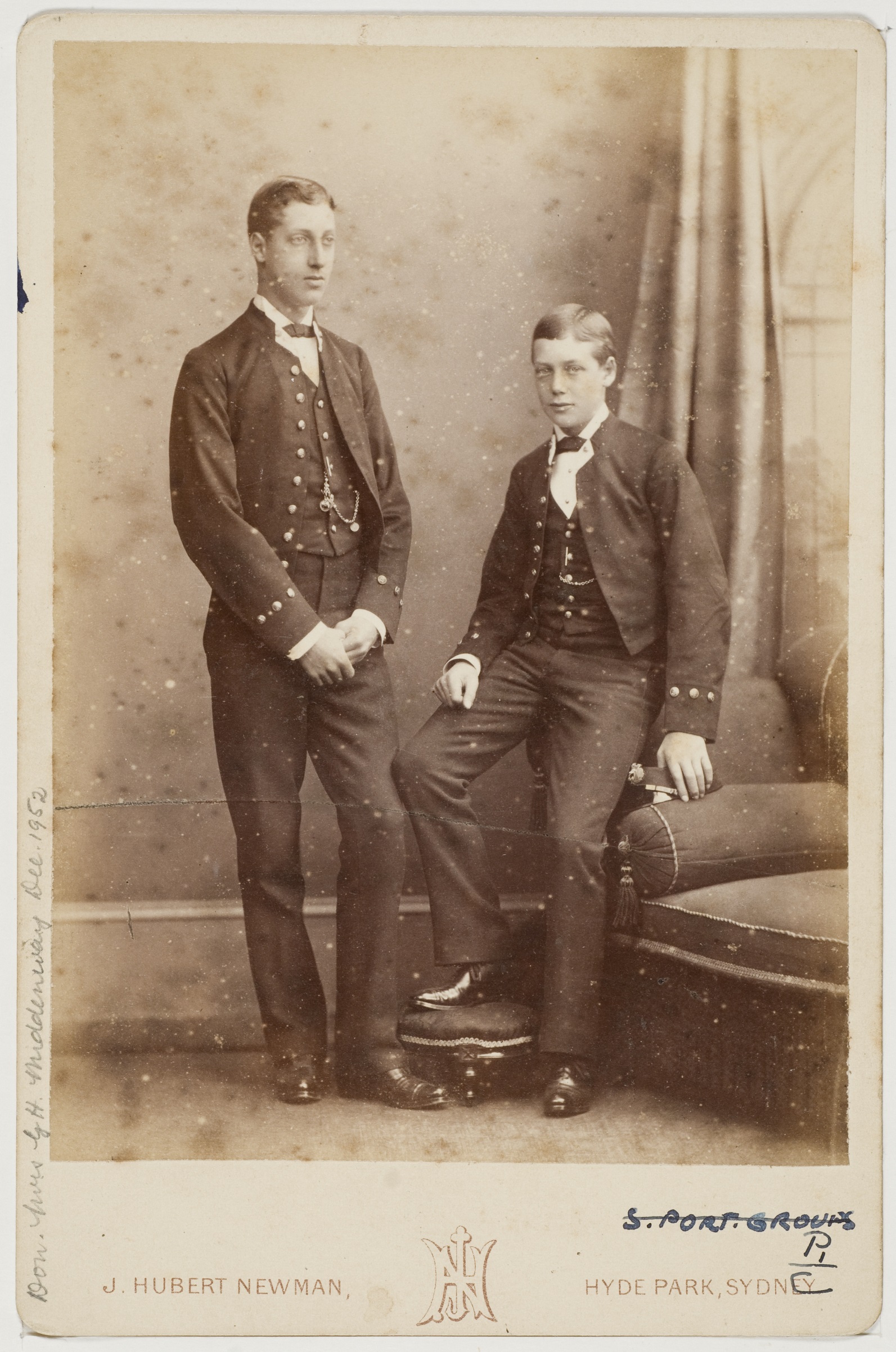
HRH Prince Albert Victor Christian Edward, Duke of Clarence, and HRH Prince George Frederick Ernest Albert of Wales as midshipmen in the Royal Navy, 1881 / photographer J. Hubert Newman, Sydney - photo courtesy of the State Library of NSW
In 1901 the Duke and Duchess of Cornwall and York also spent a restful time on the Hawkesbury, mooring adjacent to our estuary in Cowan Creek, after their official duties in opening the first Parliament of Australia in the year of our Federation.
In 1945, Prince Henry, Duke of Gloucester, KG, KT, KP, GCB, GCMG, GCVO, GCStJ, PC, ADC, the third son and fourth child of King George V and Queen Mary, and brother to visited. He served as Governor-General of Australia from 1945 to 1947, the only member of the British royal family to hold the post:
DUKE HAS SWIM AT WHALE BEACH - SYDNEY.-In contrast to Saturday when he chose North Bondi for his first swim in the surf since his arrival in Australia the Duke of Gloucester chose a secluded spot for a dip yesterday. It was Whale Beach, which lies' off the main highway between Newport and Palm Beach. There were only a few swimmers there when the Duke arrived with his police escort, but two of them recognised him. DUKE HAS SWIM AT WHALE BEACH. (1945, March 13).Barrier Miner (Broken Hill, NSW : 1888 - 1954), p. 1. Retrieved from http://nla.gov.au/nla.news-article49996831

The Duke and Duchess of Gloucester are seen off on their departure for Australia by the King and Queen, 1945. Photo: National Library of Australia.
At few years after this 'dip', in the United Kingdom, Avalon Beach gentleman Edgar Britt would become the Royal jockey for King George VI, “an excellent owner who believed in leaving his trainer to give the riding instructions, but who knew the form closely”.
Some of Edgar’s favourite memories involve the present Queen, who he first met when she was the young heir to the throne.
In a 2013 interview with local journalist Steve Meacham on the verge of his 100th birthday, Edgar shared some memories:
Once in 1948 Princess Elizabeth and her sister, Princess Margaret, walked into mounting enclosure at Hurst Park. “She’d always say hello,” he remembers. “You could always have a conversation with her, especially if it was about horses or how the race would be run.
“She would have been about 18 or 19. It was one of my first rides for the Royal family and they seemed to have a soft spot for Avila, the horse I was riding that day.
“She said ‘Will she win?' And I said ‘I think so, but I might have to give her a bit of smack with the whip.’”
“Dead silence followed. I’d said the wrong thing. I’d forgotten the Royal family didn’t like to see their horses being whipped.
“Anyway, the call came to ‘jockey up’, and the Princesses said they’d go but see me after the race. Then as she was leaving, Princess Margaret raised her hand, made a whipping motion and said ‘If she needs a whipping, give her one’.”
Did he need to? “No, she won easily.”
Her Majesty Queen Elizabeth II and Mr Edgar Britt.
Other officials attending the Royal Family have also taken part in Pittwater times either informally or formally – a lovely example resounds from October 5th 1958, when Admiral H.J. Buchanan, C.B.E./D.S.O., aide-de-camp to both King George VI and Queen Elizabeth II, officially opened the Avalon Sailing Club.
Brian Friend OAM, related being privileged in his days as a member of the Water Police of Pittwater to be part of the crew that gained a day off for, and a visit to where so many relatives had been before them, in showing Prince Charles and Lady Diana around our superlative estuary and her waters.
Time has shown His Majesty King Charles III was already in love with someone else, had been for years, and that marriage deteriorated.
In 2013 Prince Harry was part of the International Fleet Review salute at Bradley’s Head, within cooee of the Sydney's northern beaches.
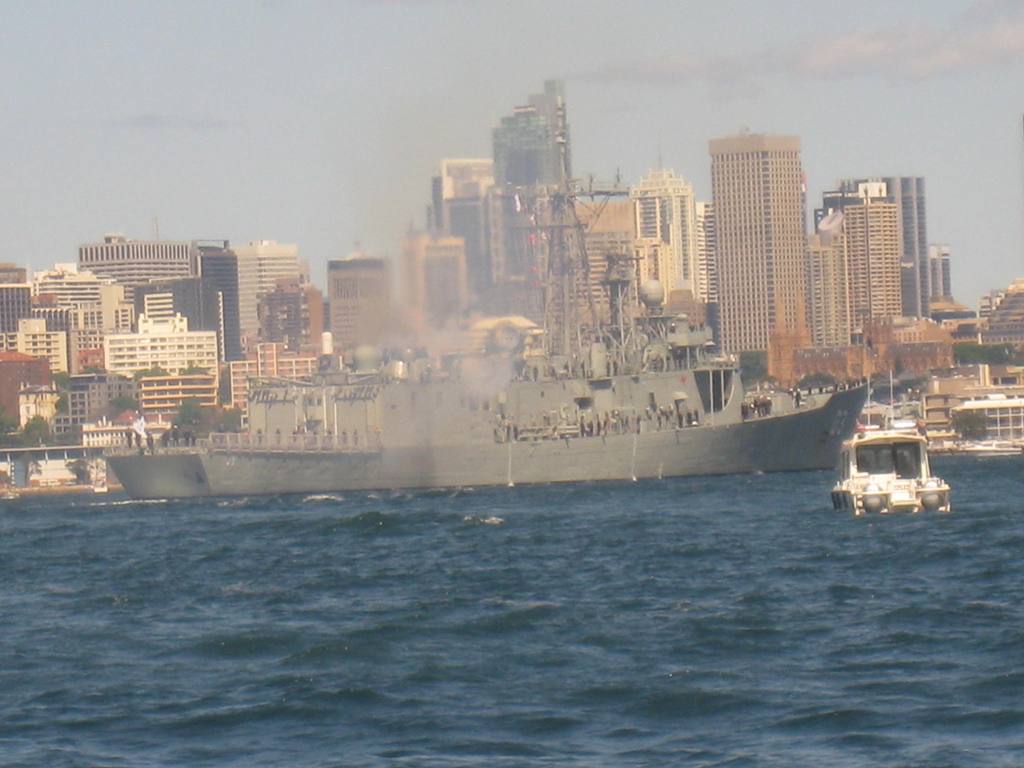
The HMAS Sydney giving a 21 gun salute to Bradleys Head where the mast head of the original HMAS Sydney is displayed. Photo: Brian Friend OAM
Prince Harry returned as host for the 2018 Invictus Games in Sydney. Training for the Invictus Games Sydney 2018 sailing team was held at the Royal Prince Alfred Yacht Club in Newport, between May 4th and 6th, 2018. The Australian Invictus Games 2018 team converged on the Sydney Academy of Sport and Recreation, Narrabeen, in mid-August for the final staging camp before the Games. The teams had their final briefings, medical assessments and were given their coveted green and gold uniforms.
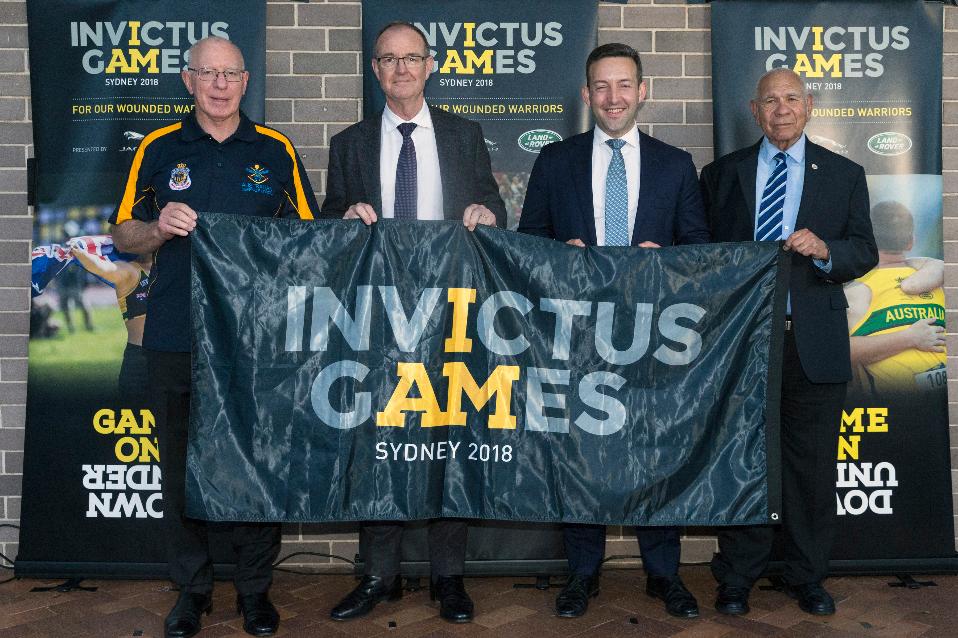
L to R: New South Wales Governor, His Excellency General the Honourable David Hurley AC, DSC, (Ret’d); Commander Joint Capabilities Air Vice Marshal Warren McDonald, AM, CSC; President of the Returned and Services League - New South Wales, James Brown; and Indigenous Elder, Uncle Roy Mundine, OAM; hold up an Invictus Games flag at the Sydney Academy of Sports and Recreation, Narrabeen. © Commonwealth of Australia, Department of Defence. Photographer SGT W. Guthrie. © Commonwealth of Australia, Department of Defence.
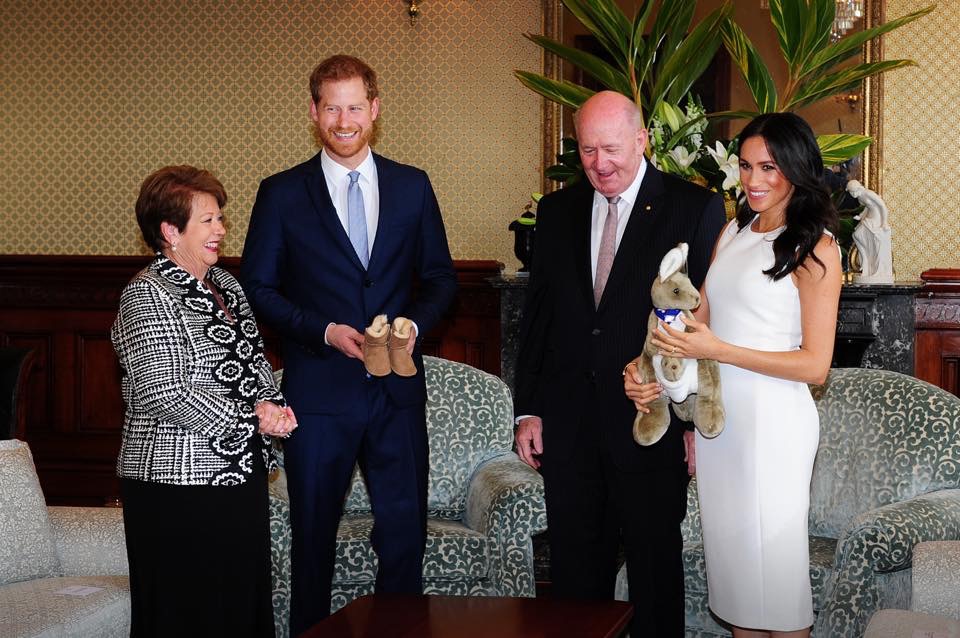
The Governor-General of the Commonwealth of Australia, His Excellency General the Honourable Sir Peter Cosgrove AK MC (Retd), and Lady Cosgrove, welcomed Their Royal Highnesses The Duke and Duchess of Sussex as they officially commenced their visit to Australia and presented them with their first baby gifts. The Duke and Duchess of Sussex announced on Monday that The Duchess of Sussex is expecting a baby in the U.K. Spring of 2019. Photo © 2018, Commonwealth of Australia
Prince William and Duchess of Cambridge, Kate, made sure Manly and a Surf Life Saving Carnival was part of their first tour here together in 2014.

Many Royal family members have served as members of the Royal Navy, and arrived in Sydney Harbour on ships, so visiting Pittwater or other places on Sydney's northern beaches would allow them an insight or a day off in an environment they love as well as getting to experience eponymous Australian events and lifestyle. The affection remains mutual in a place that welcomes all and celebrates what is known locally as ‘democracy on the sand and water’.
However, it is our love for Her Majesty that has persisted. So many have had some form of contact with Queen Elizabeth, a lady who really made an effort to meet and greet as many of her people as possible and in doing so changed forever the role of the Royals in our lives, whose declaration from her accession to the throne to 'serve us' did not cease even when a great-grandmother, that her revolution of what royalty is and does will stay with us.
Queen Elizabeth may have had superlative frocks and matching hats that dazzled, gowns that sparkled and tiaras that winked even without sun, but we saw her in her muddy gumboots too - we saw her serving alongside us - we witnessed her serving us.
This Issue we'd like to share some of those memories that have come through the interviews and experience of those who had the privilege to meet or serve this wonderful lady.
In September 1939, as Britain entered the Second World War, Lord Hailsham suggested that Princesses Elizabeth and Margaret should be evacuated to Canada to avoid the frequent aerial bombings of London by the Luftwaffe. This was rejected by their mother, who declared, "The children won't go without me. I won't leave without the King. And the King will never leave."
The princesses stayed at Balmoral Castle, Scotland, until Christmas 1939, when they moved to Sandringham House, Norfolk. From February to May 1940, they lived at Royal Lodge, Windsor, until moving to Windsor Castle, where they lived for most of the next five years. At Windsor, the princesses staged pantomimes at Christmas in aid of the Queen's Wool Fund, which bought yarn to knit into military garments.
In 1940, the 14-year-old Elizabeth made her first radio broadcast during the BBC's Children's Hour, addressing other children who had been evacuated from the cities. Princess Elizabeth stated: "We are trying to do all we can to help our gallant sailors, soldiers, and airmen, and we are trying, too, to bear our own share of the danger and sadness of war. We know, every one of us, that in the end all will be well."
In 1943, Elizabeth undertook her first solo public appearance on a visit to the Grenadier Guards, of which she had been appointed colonel the previous year. As she approached her 18th birthday, parliament changed the law so she could act as one of five Counsellors of State in the event of her father's incapacity or absence abroad, such as his visit to Italy in July 1944.
In February 1945, Princess Elizabeth was appointed as an honorary second subaltern in the Auxiliary Territorial Service with the service number of 230873. Her Majesty trained as a driver and mechanic and was given the rank of honorary junior commander (female equivalent of captain at the time) five months later.

In Auxiliary Territorial Service uniform, April 1945. Photo: Ministry of Information official photographer.
At the end of the war in Europe, on Victory in Europe Day, Elizabeth and Margaret mingled incognito with the celebrating crowds in the streets of London. Elizabeth later said in a rare interview, "We asked my parents if we could go out and see for ourselves. I remember we were terrified of being recognised ... I remember lines of unknown people linking arms and walking down Whitehall, all of us just swept along on a tide of happiness and relief."
A Royal Night Out, the 2015 British romantic comedy-drama film, recounts this 'night out'.
Princess Elizabeth met her future husband, Prince Philip of Greece and Denmark, in 1934 and again in 1937. After meeting for the third time at the Royal Naval College in Dartmouth in July 1939, Elizabeth—though only 13 years old—said she fell in love with Philip, and they began to exchange letters. Elizabeth was 21 when their engagement was officially announced on July 9th 1947.
Elizabeth and Philip were married on November 20th 1947 at Westminster Abbey. They received 2,500 wedding gifts from around the world. Elizabeth required ration coupons to buy the material for her gown (which was designed by Norman Hartnell) because Britain had not yet completely recovered from the devastation of the war. In post-war Britain, it was not acceptable for Philip's German relations, including his three surviving sisters, to be invited to the wedding. Neither was an invitation extended to the Duke of Windsor, formerly King Edward VIII.

This is the official wedding picture of Princess Elizabeth and her new husband Prince Philip, Duke of Edinburgh, made after their return to Buckingham Palace after their marriage in Westminster Abbey, Nov. 20, 1947.
Elizabeth gave birth to her first child, Prince Charles, on November 14th 1948. Their daughter and second child, Princess Anne, was born August 15th, 1950.
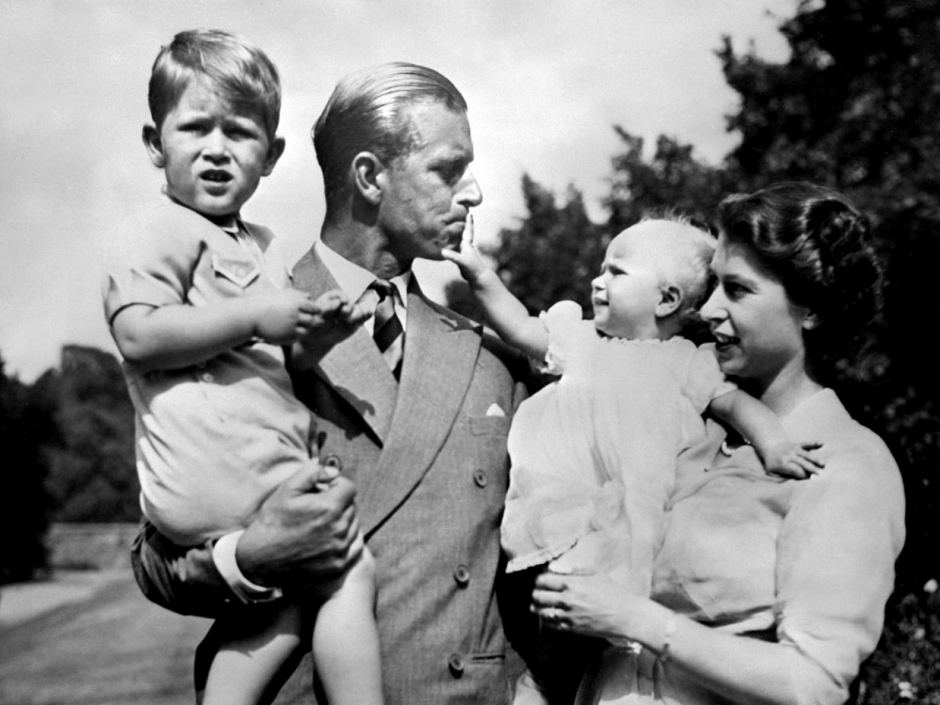
On February 3rd, 1954 the then 27 year old and her husband finally sailed into Sydney Harbour. Her arrival at Farm Cove attracted an estimated 1 million onlookers in a city with a population of 1,863,161 (1954 ABS Census).
Warriewood SLSC member Allan Collins recalled being a part of Queen Elizabeth’s first visit as a Naval Cadet and formed part of the Colour Guard for Her Majesty. Allan stated during the interview for his Profile:
''I was called up for National Service in 1954 – I did six months in the Navy through the Naval base at Balmoral beach, the HMAS Penguin – we went to sea on the cruiser HMAS Australia. I loved it – I was in the Reserves for five years after I came out of that.
We NASHO’s, formed part of Queen Elizabeth’s Colour Guard during her 1954 tour here – escorting her wherever she went – there were 42 of us. Those on this duty had to be over 6 ½ feet tall and we were under strict instructions to be inconspicuous – dressed in white uniforms with chrome bayonets and epaulets mind you. The Australian Fleet escorted the SS Gothic up and down the coast for the whole of her tour here then and I recall being on duty right at her elbow.''
Allan’s Date of Intake was 4/1/1954, his service number is 4141 NS.

HMAS Australia's ship's company on the occasion of a visit from Her Majesty Queen Elizabeth II and His Royal Highness The Duke of Edinburgh, March 1954. Photo: RAN
In February and March 1954 Queen Elizabeth II and her husband, Prince Philip, Duke of Edinburgh toured Australia. This was her first visit to Australia since her coronation and the first by a reigning monarch.
On February 3rd, 1954 HMAS AUSTRALIA, (cruiser), moored at Garden Island Naval Base, fired 1000 rockets to welcome Her Majesty, Queen Elizabeth II, to Sydney.
In the final year of her career, Australia (II) was awarded the Duke of Gloucester’s Cup and carried out both Royal and Vice Regal duties. When Her Majesty Queen Elizabeth II and His Royal Highness The Duke Of Edinburgh visited Australia in February and March 1954, Australia (II) formed part of the naval escort for the Royal Yacht Gothic and HMNZS Black Prince. During the Royal Visit to North Queensland, Her Majesty and His Royal Highness visited Australia (II) for an hour. After all officers were presented, the ship’s company marched past in single file and the Royal Party inspected and talked to 20 selected senior and 20 junior ratings.
Palm Beach SLSC founding member and ‘the Father of Surf Life Saving’, Adrian Curlewis, along with his wife Betty Curlewis, were gracious hosts of Queen Elizabeth II and the Duke of Edinburgh at the Bondi Royal Surf Carnival of 1954.
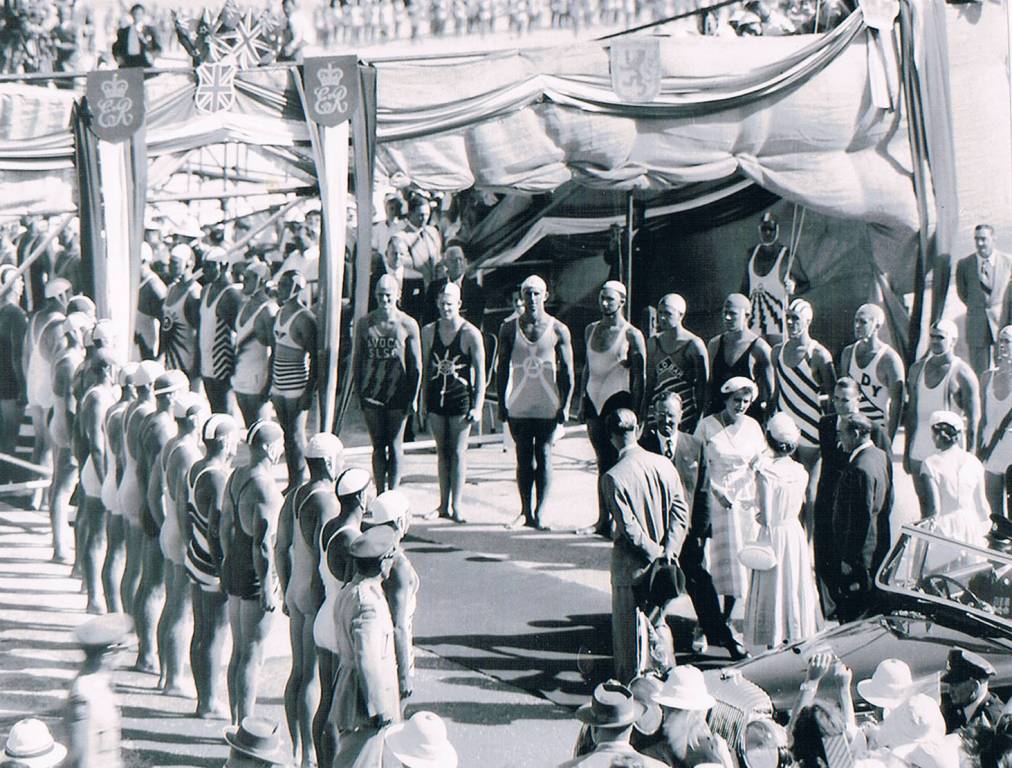
There were, of course, many local surf lifesaving club members who took part in this:
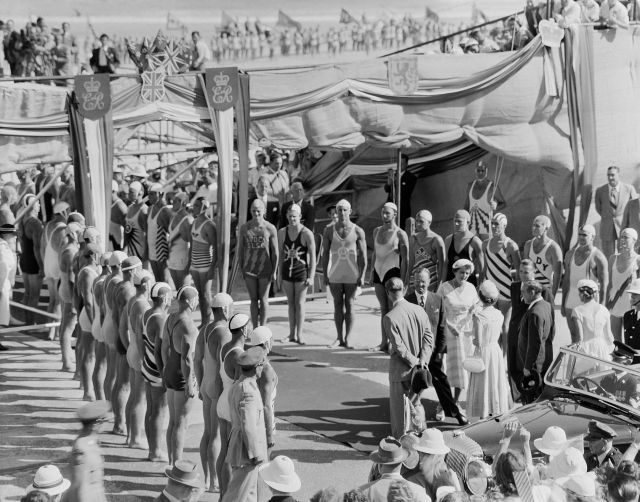

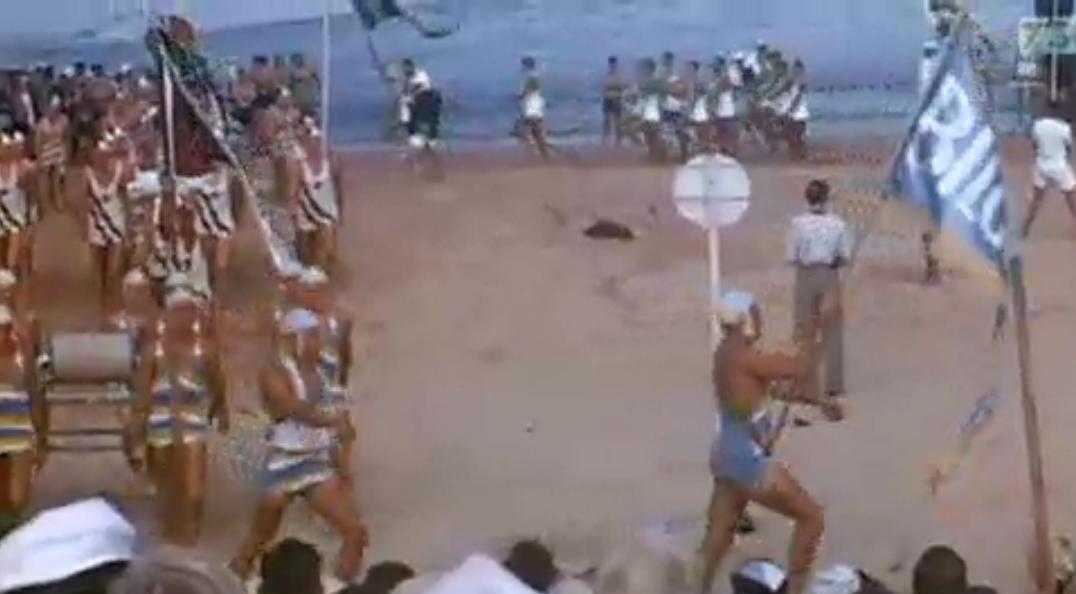
Bruce explained during interviews for his Profile:
How did you become involved with Taronga Zoo and then become Chairman?Through politics. I did take an active interest in the Liberal Party and was president of the St. Ives Branch so that brought to my attention what was going on in the Northern suburbs. We lived at St. Ives then, a beautiful spot, lovely and green.Tim Moore, who was the Member for Gordon, had seen me working in the Liberal Party and he approached me to see if I’d be interested in taking on a few other roles. At that point in time this wasn’t a fulltime job, just works undertaken to support what Taronga was trying to do. I went on and in the fullness of time I was appointed Chairman. I went on from there and took on the role of being a Trustee of the Royal Botanic Gardens in Sydney as well.Weren’t you also instrumental in creating the Coastal walkway?Yes; I was very keen on that. I think Sydney is the most fortunate city in the world in having these areas and to provide a walkway that allows people to have access to them is something that allows everyone to benefit from this.What projects were occurring at Taronga while you were Chairman?We had building projects, improving the setup as well as bringing in new animals. At that stage Dubbo was being expanded too – so we got Dubbo established, and we were successful in raising 7 million dollars to bring in Rhinos and establish that species saving program as well as a compound for them.This was also the second time I came into contact with Queen Elizabeth II, who visited on a tour here in 1992.Queen Elizabeth II visited the Western Plains Zoo on February 21, 1992. The region demonstrated its affection for the Queen with 25,000 spectators lining the streets to cheer and wave as she passed through town. About 4000 school children from across the region gathered at the Western Plains Zoo during the 1992 visit to greet the Queen as her motorcade passed through the facility. The zoo put on its best face for the Queen with feeding times rescheduled to coincide with the royal tour, to ensure all the animals were at the front of their enclosures as her Royal Highness passed by.
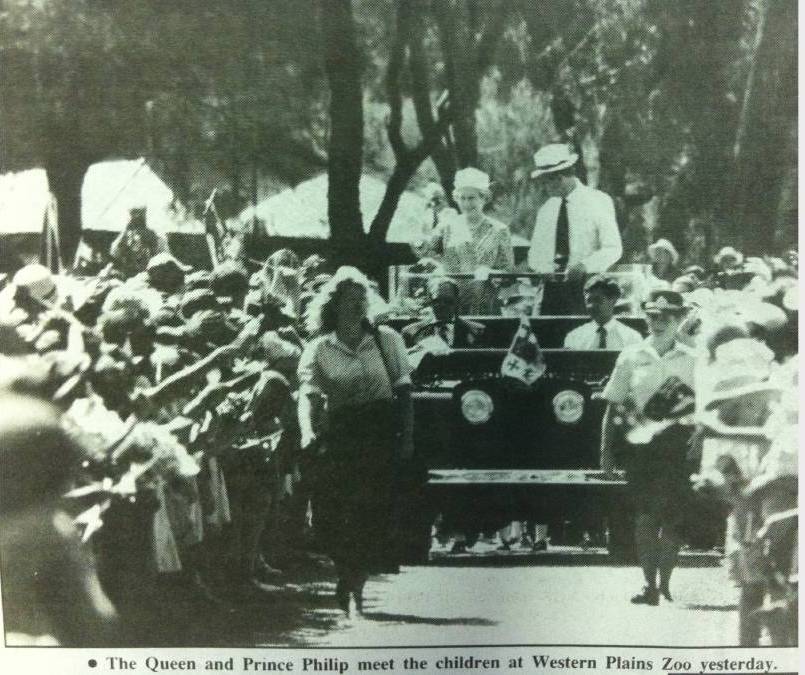
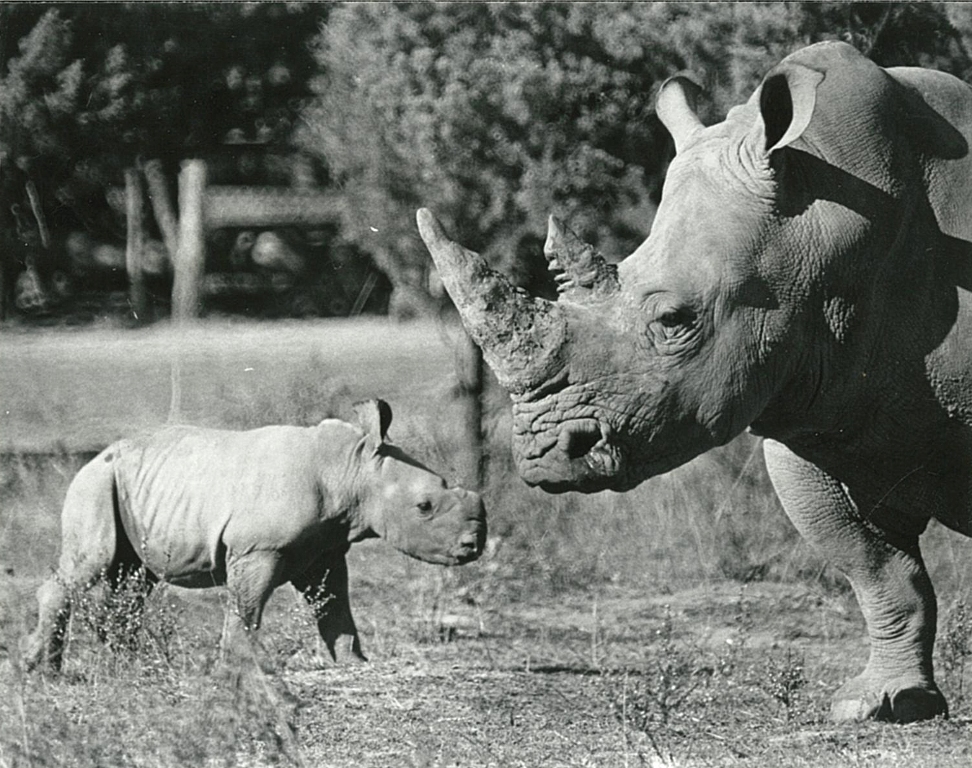
Getting back to Surf Life saving – being Flag Bearer for Bilgola at the 1954 Bondi Surf Carnival which Queen Elizabeth II attended– what was that like?Wonderful. What was equally exciting was the size of the surf that day. It was monstrous.I can remember one wave it took us three strokes to get over the wave. We didn’t get pounded there, but we did get pounded many other times.
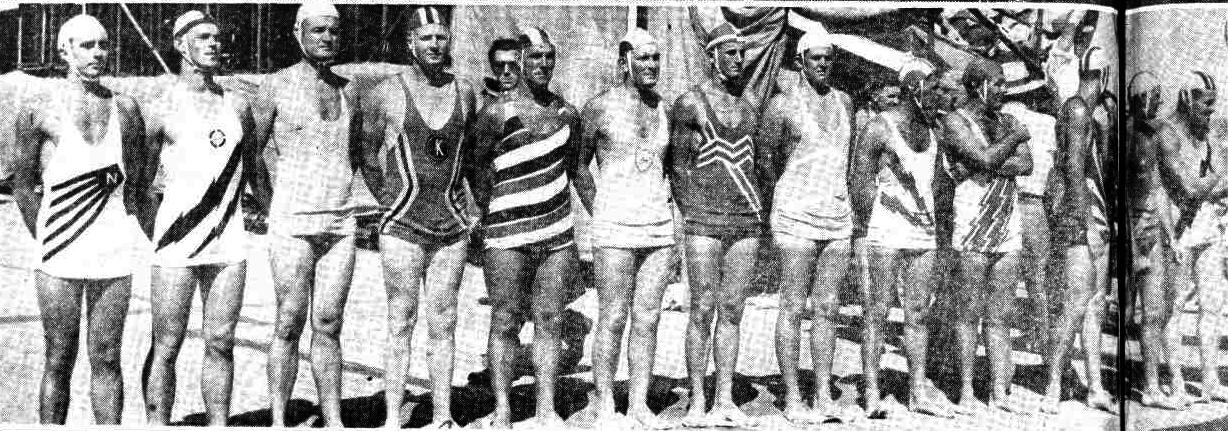

Her Majesty Queen Elizabeth with judge A. Curlewis, President NSW Surf Life Saving Assoc. arrives at Bondi Beach, Sydney, to witness exhibitions by the Surf Life Saving Association, 1954. Item: c15568_0086_h, from and courtesy the collections of the State Library of New South Wales.
During the 1954 Royal Tour Her Majesty’s ladies-in-waiting caused some to think the Queen was water skiing on Narrabeen Lagoon or lunching at Elanora Heights and having afternoon tea at Palm Beach until who was whom was clarified. Some are still certain Queen Elizabeth did have a few days off at Palm Beach which reports from that year can neither confirm nor deny.
On Sunday February 7th, and reported the next day, it was stated:
Ladies-in-waiting Confuse Crowds
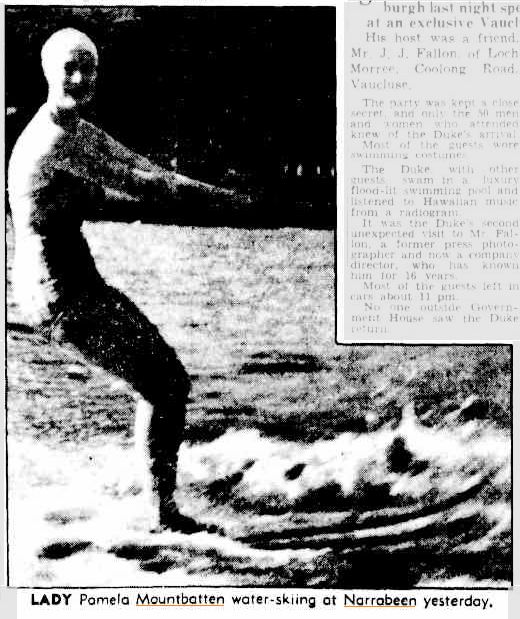
Cars containing the Queen's Ladies-in-Waiting confused crowds yesterday who rushed to see the Queen pass. The people thought the Queen would be in the cars.
The Ladies-in-Waiting are Lady Pamela Mountbatten and Lady Alice Egerton.
Both went driving-Lady Pamela to Narrabeen Lake to water-ski, and Lady Alice to Palm Beach.
Hundreds thought Lady Pamela was the. Queen when they saw her driving to Narrabeen Lake. She drove to the lake in a Royal tour Daimler.
Two men went with her to the lake, and also Miss Elizabeth Northcott, daughter of the Governor of N.S.W., Sir John Northcott.
ARMY DRIVERS
The party used two cars driven by Army personnel. Crowds rushed to the road-side, waving flags and cheering when they saw the two cars approaching.
Both cars were black and both bore silver crowns.
About 150 people were waiting outside Dalwood Homes, in Wakehurst Park-way in case the Queen passed. They groaned with disap-pointment when they saw that neither the Queen nor the Duke of Edinburgh was in the cars.
Groups of people further along the road caught only a glimpse of the occupants, and thought they had seen the Queen. When told they had not seen the Queen they decided to wait in case she also passed.
Mr. W. Ledsan, president of the Dolphin Water Ski Club, met the party at the lake.
Lady Mountbatten then changed from a light cotton-print frock into a white swimming costume and she and Miss Northcott climbed into a motor boat.
Mr. Ledsan drove the motor boat to the end of the lake, where the water was calm.
Half an hour later the boat returned towing Lady Pamela on water-skis.
Water-ski experts, among a crowd of 200 who watched, said Lady Pamela was a proficient water-skier.
She was on the lake for nearly an hour.
PALM BEACH TRIP
Lady Alice Egerton, mean-while, was in a party of two Royal cars that went to Palm Beach. With her were the Queens secretary, Sir Michael Aderne, her assistant secretary, Colonel Martin Charteris, the Mini-ster in charge of the Royal tour, Mr. Eric Harrison, and the Commonwealth Director, Lieutenant-C olonel F. H. Berryman.
Crowds cheered, waved, and tooted motor horns as the cars passed them on the way to Palm Beach.
When they saw the Queen was not in the cars they also decided to wait for the Queen. A rumour spread that the Queen's car would come next.
At Palm Beach the party went to the home of Mr. Sam Walder. All the party surfed later except Lady Alice, who sat on the beach. Mr. Walder's home is near the home of Mr. J. Carroll, where it was rumoured last week that the Queen and Duke would rest. Ladies-in-waiting Confuse Crowds. (1954, February 8). The Sydney Morning Herald (NSW : 1842 - 1954), p. 4. Retrieved from http://nla.gov.au/nla.news-article18408639
Roads jammed in "mystery hunt"
CARS PURSUE RUMORS
Fruitless wait to see Queen
More than 200,000 people jammed roads in and outside Sydney yesterday in the rain hope of seeing the Queen. Thousands of motorists drove to places in the suburbs and the country after hearing rumors that the Queen would be out sightseeing. Stayed at Govt. House
But all returned home disappointed. All the rumors were "furphies," and the only time the Queen and the Duke of Edinburgh appeared outside Government House yesterday was when they drove to and from St Andrew's Cathedral for the morning service. The Queen spent the „ afternoon and night at Government House. After a late dinner the Queen saw newsreel films of the Royal tour.
About 150,000 people lined the 30-mile route from the city to Palm Beach hoping to see the Queen. Thousands of cars, in almost unbroken lines, drove along along the road at low speeds.
Police sent more than 50 extra men to the North Shore to control the heavy traffic and crowds. Hopes - of seeing the Queen soared. when a fleet of gleaming black cars, each with a- crown on the door, drove by. -' But these cars carried members of the Royal household staff going to Palm Beach.
Wild rumors sped through the crowd that the Queen was hiding in one of the cars. From early morning, thousands of people waited along the road between Spit Bridge and Palm Beach. They had read reports during the week that the Royal couple, would visit Villa d'Este, the Palm Beach luxury residence of Mr. and Mrs. J. T. Carroll.
Police estimated that at 3 p.m. 40,000 people waited between Mona Vale, and Palm Beach.
Early in the evening at Palm Beach scores of people and cars waited along the approach to Villa d'Este.
In Mona Vale's main street people lined the pavement for 100 yards. The policemen told them the Queen was still at Government House.
At 8 p.m. parked cars still lined the approaches to the Carroll residence, which were in darkness.
Members of the Royal Household who went to Palm Beach lunched at Elanora Country club. With them were the Federal member in charge of .the Royal tour (Mr. E. J. Harrison) and the Minister for Navy and Air (Mr. W.McMahon).
Members of the party included the Queen's private secretary (Sir Michael Adeane).
After lunch the party visited the Palm Beach home of Mr. Sam Walder, son of the late Sir Samuel Walder. Lady Walder assisted her son to entertain the guests. Roads jammed in "mystery hunt" (1954, February 8). The Daily Telegraph (Sydney, NSW : 1931 - 1954), p. 2. Retrieved from http://nla.gov.au/nla.news-article248770377
Gwyneth Sneesby, a long-term Mona Vale resident and a young lady then, recalled in her Profile interview;
I was very happy later on when the Queen came in 1954. She came out to Palm Beach and we were watching and I can remember still telling my daughter how naughty she was; she had her head in a suitcase or something, looking for something in her bag, and she missed it. We still reprimand her for that.
Sir Samuel Robert Walder (1879-1946), businessman and politician, enjoyed golf, yachting and motoring, and held membership of the Tattersall's, the New South Wales, Millions, Australian and Elanora Country clubs.
They Danced In Cotton By The Sea
MOST people who were staying at Palm Beach, Newport, and CoUaroy converged for a time at least last night upon the New Year's Eve parties held at Elanora Golf Club or at the Pacific Club at Palm Beach. The gaiety of the celebrations was reflected in the brightness of the patterned cotton evening gowns that were almost uniform among the women and which looked at their best in the informal atmosphere of the country and beach clubs.

MISS JOAN HOWES, MRS. DENNIS ROWE and MRS. JOHN HUMAN at the Palm Beach home of Mr. Sam Walder, where they are staying for the holiday season, before leaving for the New Year's Eve dance at Elanora last night. Miss Howes wore a green and mauve shot taffeta short evening gown toith a short matching jacket. Mrs. Rowe, chose a patterned yellow off-the shoulder cotton gown. They Danced In Cotton By The Sea (1950, January 1). The Sunday Herald (Sydney, NSW : 1949 - 1953), p. 10. Retrieved from http://nla.gov.au/nla.news-article18474075
Villa d'Este is still in Northview Road Palm Beach. In 2013 the landmark 1933 Villa d'Este estate at Palm Beach sold for around $7.5 million by Terry Tobin, QC, and his wife, Bernadette, who owned the property since 1983. The 2,626 square metre property had been their family holiday home since bought for $700,000 from Guy Dawson. NSW HLRV Land title records record it changed hands in 1933 to Elizabeth Bay estate agent Morris Leventhal and his wife, Orissa when the 1927 mortgagee, the Bank of New Zealand secured a £310 sale. The departing mortgagor was Samuel Hood Hammond who bought Lots 12 and 13 (Vol. 3709-Folio223) on March 17th, 1923. It then became the weekender of the Carroll family.
Of course, all these rumours came from somewhere:
Queen, Duke At Church
The Queen and the Duke of Edinburgh will attend Divine Ser-vice at St. Andrew's Cathedral, this morning. This is their only official engagement on to-day's programme.
They will leave Government House at 10.50 a.m. and arrive at the cathedral at 10.58 a.m.
They will drive along Macquarie Street, Martin Place and George Streets.
Duke To Read The Lesson
The Archbishop of Sydney, the Most Reverend H. W. K. Mowll, will meet the Royal couple and present them to the Dean of Sydney, the Very Rev. E. A. Pitt, and the Lay Canon.
The Archbishop will pre-cede her Majesty and the Duke past the choir, which will form two lines at the entrance, and usher them to the Royal pew.
During the service, the Duke will read the Lesson.
The return journey to Government House will be along George Street, Martin Place and Macquarie Street.
Rumour On Palm Beach visit
It is understood the Queen and the Duke may visit Palm Beach this afternoon. If so, they may travel up the Pacific Highway, and then through St. Ives along Pittwater Road.
On the other hand they may go through Manly.
A number of influential people have been trying to get them to visit Manly, which is not on the official itinerary. It has been suggested the Queen may visit the Far West Home at Manly, and the Duke may go sailing at Pittwater.
To-morrow will be the first free day for the Royal couple.
On Tuesday they will leave Central Station on the Royal train at 10.15 a.m. for Newcastle. Queen, Duke At Church (1954, February 7). The Sun-Herald (Sydney, NSW : 1953 - 1954), p. 4. Retrieved from http://nla.gov.au/nla.news-article28659280
A few reports from then on the road to Palm Beach as witnessed on Sunday February 7th, 1954
THOUSANDS WAIT IN VAIN TO SEE THE QUEEN
Royal Visit Rumours Sweep Sydney
More than 100,000 people waited along main roads on the North Shore yesterday hoping to see the Queen after rumour had swept Sydney that she would be visiting Palm Beach.
Other rumours concerning the Queen's plans - that she and the Duke of Edinburgh would spend her two-day rest period at "Hillview," near Moss Vale, and that the Royal couple would visit Ingleburn military camp - drew scores of thousands of others to positions along roads leading to those points.
But all the rumours were false. After returning from Divine Service at St. Andrew's Cathedral, the Queen did not leave Government House for the remainder of the day.
However, the Duke went sailing in the afternoon and to a party at Vaucluse at night. A tour official said last night:
"The Duke of Edinburgh went sailing during the afternoon. The Queen did not leave Government House."
The official would give no further details.
A broadcast in the early afternoon supporting the rumour that the Queen would go to Palm Beach was responsible for the disappointment of many of those who gathered along the highways.
When Royal tour authorities learned of the rumours about 4 p.m., a spokesman announced: "The Queen has not gone out this afternoon from Government House and her Majesty won't be going out to-night."
This information was conveyed by police to many of the assembled groups. But they were generally disbelieved. Some, who could not be persuaded that the Queen would not pass their way, maintained their vigil until nightfall.
QUEEN, DUKE AT CATHEDRAL
The Queen's only official engagement yesterday was Divine Service at St. Andrew's Cathedral, the oldest cathedral in Australia.
The Queen smiled as she stepped from her open car, accompanied by the Duke of Edinburgh.
But she looked a little tired and seemed glad to leave the glare of the sun and enter the cool cathedral, which was beautifully decorated with bowls of pink and white gladioli and dahlias.
DIVINE SERVICE AT ST. ANDREWS

The Queen looked solemn as she left St. Andrew's Cathedral yesterday after attending Divine Service. She is accompanied by the Primate of Australia, Archbishop H. W. K. Mowll. The service was conducted by the Dean of Sydney, the Very Rev. E. A. Pitt.
15,000 CHEER
A crowd of 15,000, many of whom had waited several hours in hot sunshine, cheered the Queen and the Duke as they arrived.
The Archbishop of Sydney, Dr. H. K. Mowll, preached the sermon and the service, the simple form of Anglican Morning Prayer was conducted by the Dean of Sydney, the Very Rev. E. A Pitt.
A feature of the service was its link with the first Christian church service held in Australia 166 years ago - under a tree at Farm Cove on February 3, 1788.
The Bible and the Prayer Book used yesterday were those used by the Rev. Richard Johnson, Chaplain to the First Fleet, at that faraway service.
The Duke of Edinburgh, in a firm, well-modulated voice that filled every corner of the cathedral, read the second lesson. The Governor, Lt.-General Sir John Northcott, had read the first.
After dinner at Government House last night several films were screened including some of the Queen and the Duke landing at Farm Cove on Wednesday and several short cartoons.
GIVEN CHOICE
In his announcement that the Queen would not be leaving Government House that day the Royal tour authorities spokesman said:
"That is not an official announcement that the Queen won't, but at the moment there is no intention of her going out. She has said that she won't be.
"Her Majesty never had any intention of going on a car ride.
"That is only newspaper speculation, but if she had wished to go, the State had arranged a number of alternatives, so that she could have taken a pick of going to one of a number of places if she had wished."
The spokesman would not say what the "alternative" visiting spots were.
A crowd of 20,000 lined Barrenjoey Road to Palm Beach.
MISLED BY CARS
The crowd pitched canvas shelters by the side of the road to keep out of the sun, ate picnic lunches, decorated trees, lampposts, and their cars with bunting and signs and waited hopefully for the car which never came.
Householders along the route decorated their homes and at Mona Vale a gigantic calico sign was stretched across the roadway, reading "Mona Vale Welcomes You - Please Drive Slowly."
Rumours that the Queen would visit Palm Beach were heightened when two Royal tour Daimlers, with a police motor cycle escort, drove towards Palm Beach, arriving shortly after 3 p.m.
Lady Alice Egerton, one of the Queen's ladies-in-waiting, was in one of them. The cars went to the home of Mr. and Mrs. Sam Walder at Palm Beach.
The crowds cheered, waved, and tooted motor horns as the cars passed. Rumour had it that the Queen would come next.
A minor traffic jam developed in the road leading to Mr. Walder's home.
Many people living on the Pacific Highway brought chairs and lounges out to the footpath and sat reading newspapers and books while waiting for a chance to see the Queen.
GORDON HOPES
More than 400 people were bitterly disappointed when the Queen did not visit the Lady Gowrie Red Cross Convalescent Home in Edward Street, Gordon.
They had waited for more than four hours in the streets and in the grounds of the home.
Visitors to patients and two crippled children (one in a wheel chair) were allowed to come into the grounds. They waited patiently beside the drive-way.
The hopes of the large crowd were finally dashed at 4.50 p.m. when it was made known that the Royal couple would not be visiting the home.
WOULD NOT BE CONVINCED
A police sergeant at a northern seaside suburb said: "People got the idea that the Queen would visit Palm Beach and nothing we could say could convince them that she wouldn't.
'They seemed to think we were trying to talk them out of seeing the Queen.
"Carloads of people waited at main road corners hoping that the Queen would travel along either road.
"Hundreds also congregated near the Far West Children's Home and Stewart House Preventorium."
A Newport resident said that during the afternoon there were thousands of them waiting along the road from Newport to Palm Beach.
"None of them seemed to know where the rumour started, but all were quite convinced the Queen would pass," he added
QUEEN'S MESSAGE
Ten minutes later, police told the crowd that the Queen had personally requested that the people should be informed that she would not leave Government House.
They said she did not want the children to wait in the hot sunshine and be disappointed.
But, like thousands of adults, the children did not believe the police. They waited and waited.
Some people claimed they had been "tipped" that the Queen would make a secret visit to the seaside. Others, given the Queen's message, said: "The Queen's human. She may change her mind."
Large crowds gathered at the gates of Government House last night in the hope that the Queen might drive out.
Police kept the gates closed but at 10 o'clock more than 100 people still stood near them.
A big crowd went to St. Jude's Church of England, Randwick, last night, when rumours circulated that the Queen would attend Divine service there.
Many people waited out-side the church for more than an hour, before they were convinced that the Queen was not coming after all. THOUSANDS WAIT IN VAIN TO SEE THE QUEEN (1954, February 8). The Sydney Morning Herald (NSW : 1842 - 1954), p. 1. Retrieved from http://nla.gov.au/nla.news-article18408545
Traffic Jam 27 Miles Long
The worst traffic jam ever seen in the district occurred when thousands of cars tried to return from Palm Beach and other northern beaches last night.
Police said that at one stage cars were packed bumper to bumper from Palm Beach to the Harbour Bridge, a distance of 27 miles.
They said that other jams occurred on the Mona Vale Road and the Roseville Road as motorists tried to escape the jam on the main highway.
Cars began leaving Palm Beach and other northern beaches about 4.30 p.m. Two hours later the traffic jam was at its peak.
Police reinforcements were called and concentrated on the Roseville and the Spit Bridges.
ROYAL RUMOURS
A resident of Newport said that traffic was still "hopelessly jammed" at 8.30 p.m. He said he walked along the road for more than a mile without being passed by a car, and car headlights illuminated the cliffs at beaches from Palm Beach to Collaroy.
Rumours that the Queen and the Duke of Edinburgh would visit Palm Beach caused thousands of motorists to travel to northern seaside resorts.
Last night many people were still gathered at Mona Vale and other northern beaches.
Many groups had tea at the side of the road.
150,000 IN CITY
Police estimated that 150,000 were in the city at 8 o'clock last night, looking at the decorations.
They said the city was choked with the heaviest traffic they had known for a Sunday night.
Between 6.30 and 9.30 p.m. main city streets were blocked and cars were bumper to bumper.
The heaviest concentration of traffic was between Macquarie Street, Clarence Street, Circular Quay, and Liverpool Street.
Cars took up to three-quarters of an hour to travel along Macquarie Street, and half an hour to get through Queen's Square. Trams and buses were thrown hopelessly off schedule.
Traffic was also very heavy at King's Cross and down William Street. Traffic Jam 27 Miles Long (1954, February 8). The Sydney Morning Herald (NSW : 1842 - 1954), p. 1. Retrieved from http://nla.gov.au/nla.news-article18408547
Duke Goes To A Vaucluse Party
The Duke of Edinburgh attended a party at a Vaucluse home last night. It was his second visit to his friend, Mr. J. J. Fallon, company director, of Loch Maree, Coolong Road, Vaucluse.
About 50 guests at the party spent the evening swimming in a floodlit bathing pool and listening to a gramophone playing Hawaiian music.
STRICT SECRET
Another gramophone played soft music inside Mr. Fallon's house, situated about 20 yards from the bathing pool and overlooking a picturesque cove.
The Duke's visit was kept a strict secret. No one outside Government House saw him leave or return.
It is understood he arrived at the party in a launch about 8 p.m. and left in a hire car shortly after 10 p.m.
Most of the guests left in cars about 11 p.m.
UNEXPECTED VISIT
Mr. Fallon has known the Duke for 16 years. Last Thursday the Duke visited him unexpectedly, travelling to Vaucluse in a small car.
They had met last in 1946, when the Duke was in Sydney as a naval officer. Duke Goes To A Vaucluse Party (1954, February 8). The Sydney Morning Herald (NSW : 1842 - 1954), p. 1. Retrieved from http://nla.gov.au/nla.news-article18408548
Joseph James Fallon was a society cameraman/journalist when the Duke of Edinburgh was out here towards the end of World War II. Joseph met Lieutenant Prince Philip of Greece, here with the Royal Navy.

The palatial harborside residence Loch Maree at Vaucluse. Why Judy wasn't home when the Duke called (1954, March 7). Truth (Sydney, NSW : 1894 - 1954), p. 9. Retrieved from http://nla.gov.au/nla.news-article172054249
Public Asked To Ignore Tour Rumours
The Federal Minister in Charge of the Royal Tour, Mr. Eric J. Harrison, last night appealed to the public to ignore rumours about where the Queen and Duke might be going at unscheduled times.
Mr. Harrison said that if people took notice only of the Royal couple's official programme, they would "have every oppor-tunity of seeing her Majesty and the Duke."
Mr. Harrison said: "I have been out myself to-day and saw the many people who were waiting in the sun to see the Queen and the Duke of Edinburgh.
"It reflects tremendous credit upon the people for the enthusiasm they have shown, but the enthusiasm must be misplaced if they cannot give vent to it by the Royal visitors' presence.
"Her Majesty must have a certain amount of leisure time in which she must re-cover from the arduous duties that have been imposed upon her, and the need to carry out the various official duties that are part of the itinerary.
"LEISURE DAYS"
"The public should try to understand the need for observing the period of leisure time that the Queen has from the various functions, and the rumours that are circulated as to her movements should be entirely ignored.
"Members of the public would save themselves a lot of unnecessary inconvenience if they took notice only of the official programme that is pub-lished, because quite obviously any statement as to the Queen's and Duke's movements on their leisure days would defeat the object of the days that we had planned for their complete relaxation.
"I appeal to the public to take note only of the official programme, because it is only within the bounds of the official programme that they will have any opportunity of seeing her Majesty.
"The rumours that have been circulated are entirely unfounded and must have caused the people a lot of in-convenience," Mr. Harrison added.
The Reverend Gordon Powell last night appealed to people not to crowd in on the Royal car.
"People may not realise what injuries could come from flags, umbrellas, sticks, or anything else they may be waving," he said.
"It would be a terrible blot on Australia if either the Queen or the Duke suffered facial injuries caused by the people's enthusiasm."
FREE DAY TO-DAY
The Queen has no official engagements to-day.
To-morrow the Queen and the Duke will visit Newcastle. To-morrow night they will fly to Lismore, and on Wed-nesday will visit Lismore, Casino and Dubbo.
Their movements in Sydney to-morrow are:
10 a.m.: The Queen and the Duke of Edinburgh will leave Government House for Central Railway Station.
Route: Macquarie and College Streets, Wentworth Avenue, Hay Street, Railway ramp.
10.06 a.m.: The Royal party will arrive at the station opposite the entrance to No. 1 Platform. The Premier Mr. J. J. Cahill, will present the Minister for Transport, Mr. E. Wetherell, and others.
Mr. Cahill will conduct the Royal couple to their carriage.
10.15 a.m. The Royal train will leave for Newcastle. Public Asked To Ignore Tour Rumours (1954, February 8). The Sydney Morning Herald (NSW : 1842 - 1954), p. 1. Retrieved from http://nla.gov.au/nla.news-article18408541
The Duke of Edinburgh's sailing foray, according to the papers of the day, occurred on Sydney Harbour. At first it was rumoured he sailed aboard the yacht Ada, later discounted, however, she did sail down the harbour to greet the Royal couple on their arrival:
LUXURY YACHT TO MEET GOTHIC
Australia's largest, most luxurious schooner, the 64ft. Ada, which has been undergoing an extensive overhaul for some months, appeared on the Harbor yesterday afternoon, carrying brand new sails and flying the Blue Ensign.
Ada, which is owned by Mr. W. J. Stuart, is to lead the yachts in when the liner Gothic arrives with the Queen and the Duke of Edinburgh on Wednesday week. Ada presented a magnificent spectacle in her trials, and will take part in this morning's Royal landing rehearsal. The big yacht has been reconverted from a gaff-rigged schooner to a staysail schooner, and is carrying some of the most expensive sails seen on Port Jackson. The yacht has been completely refurnished at heavy expense, and will probably see duty in other official capacities. LUXURY YACHT TO MEET GOTHIC (1954, January 24). Truth (Sydney, NSW : 1894 - 1954), p. 56. Retrieved from http://nla.gov.au/nla.news-article172056810


The Royal Barge flanked by an avenue of boats to mark the arrival of the Queen and Prince Phillip (City of Sydney Archives, Graeme Andrews ‘Working Harbour’ Collection: 80251)

The Royal Barge flanked by an avenue of boats to mark the arrival of the Queen and Prince Phillip (City of Sydney Archives, Graeme Andrews ‘Working Harbour’ Collection: 80251)
Soon after their arrival he did go across the harbour to present trophies for the Dragon-class yachts:
THE DUKE PRESENTS HIS OWN CUP
Olympic yachtie earned it, too
THIS afternoon, at Royal Sydney Yacht Squadron, Kirribilli, the Duke of Edinburgh will present trophies won this week on the harbor in the Australian sailing championships. The main trophy will be the Prince Philip Cup, a handsome 200 - guinea piece of silverware, which the Duke personally gave for the 29ft Dragon class yacht series. His Royal Highness will hand the cup to Victorian Jock Sturrock, who dominated the five faces sailed in his boat Kamulla. Kamulla won three of the events, finished second in another and was fourth in the final race.
The Duke, better than most of the yachtsmen present, will understand the merit of Sturrock's performance, because he owns and races a Dragon himself — against the hottest of British competition. His boat is Bluebottle, in which the Queen often sails. Bluebottle hasn't set any of the English waterways afire yet, but she's always among the leaders and the Duke has proved himself a smart helmsman in this sport, where there are no beg pardons and no social distinctions. Whether you're an earl or a baker, you obey the inflexible rules of yacht racing and you earn your wins only with skill and judgment. So Sturrock, when he listens to the amiable speech of congratulation that will accompany the trophy, will know that this is no princely gesture of condescension, but frank admiration by one yachtsman of another. And you can be certain, too, that if the Duke can escape for a couple of hours from the formidable schedule set him on this tour he'll be in a pair of shorts and a slicker, slithering around the harbor at the helm of Kamulla, comparing her paces with those of his own boat.
Chances in Olympics
Apart from the honor of Sturrock's presentation to Royalty, his performances this week and those of the helmsmen who won titles in other classes of boats means that Australia will be right up close in the Olympic Games sailing competitions in 1956. Organisation, control, and the standard of sailing was equal to the best internationally and in many ways superior to that provided by the Finns at the Helsinki Olympic Games in 1952. Australia's Olympic sailing events will be held on bouncy Port Phillip Bay, Victoria, where the wild, open water breeds yacht crews more suitable to ocean racing than smooth, tactical battles...THE DUKE PRESENTS HIS OWN CUP Olympic yachtie earned it, too (1954, February 5). The Sun (Sydney, NSW : 1910 - 1954), p. 14 (LATE FINAL EXTRA). Retrieved from http://nla.gov.au/nla.news-article230871169
PRINCESS ELIZABETH GOES SAILING

Princess Elizabeth, with the Duke of Edinburgh at the helm, sailing in her yacht Bluebottle on Beaulieu River, Hampshire. PRINCESS ELIZABETH GOES SAILING (1949, August 12). Newcastle Morning Herald and Miners' Advocate (NSW : 1876 - 1954), p. 4. Retrieved from http://nla.gov.au/nla.news-article134465459
Under Sail
The Duke of Edinburgh has hinted of a return visit to Australia. At Friday's Royal Visit Regatta trophy presentation, the Duke said: "I hope to compete against Australian yachtsmen in the future."
He said this when presenting the Prince Philip Cup to Victorian Jock Sturrock for his win in the Dragon class, national title. The presentation ceremony was one of the most spectacular and colorful seen, at the famous Royal Sydney Yacht Squadron. Under sail (1954, February 7). The Daily Telegraph (Sydney, NSW : 1931 - 1954), p. 39. Retrieved from http://nla.gov.au/nla.news-article248771797
Then just turned 13 schoolgirl at Mosman and local founder of the Pittwater Natural Heritage Association Marita Macrae recalls seeing the Queen during this visit. Marita was one of thousands of local school children assembled to greet the Queen on Thursday February 18th during her visit to Balmoral Naval Depot, H.M.A.S. Penguin:
2,400 SOLDIERS TO LINE ROYAL ROUTE
Plans For Rousing City Farewell To Queen
A contingent of 2,400 troops will line the Royal route from Government House to Circular Quay this afternoon. The Queen, the Duke of Edinburgh and their party will leave Government House at 5.30 p.m. and will drive to the Quay via Bridge and Pitt Streets. The Queen and the Duke will board the Royal yacht Gothic at No. 5 Wharf at 5.35 p.m. and will sail for Hobart at 6 p.m.
An Army spokesman said last night that the troops lining the route to the Quay would stand a yard apart and link hands if there was an attempted breakthrough by the watching crowd, which is expected to give the Royal couple a rousing farewell.
The Metropolitan Police Superintendent, Mr. G. Smith, said that city workers who wished to catch their usual ferries home would be allowed through road blocks until a few minutes before the Royal procession was due at the Quay.
Ferries will attempt to keep to their ordinary timetables until 5.45 p.m. A special ferry will leave No. 5 Circular Quay at 5.15 p.m. to farewell Gothic at the Heads.
Mr. Smith said that as far as possible this afternoon, motorists should avoid Bridge, Pitt and Macquarie Streets and Fig Tree Avenue in the Domain.
"Traffic for northern or eastern suburbs should use Park, George, York and Clar-ence Streets." he said.
"To avoid congestion those who can should go to the Mrs. Macquarie's Chair area to watch the Royal liner's departure."
TIMETABLE
Here are details of to-day's Royal programme:—
11.30 a.m.: The Queen and the Duke of Edinburgh will arrive at Mascot from Canberra and the Premier, Mr. Cahill will greet them.
The Royal party will leave immediately for Balmoral Naval Depot via Old Botany Road, O'Riordan Street, Bourke Street, Taylor Square, Oxford Street, College Street, Park Street, Druitt Street, Clarence Street, Bradfield Highway, Pacific Highway, Miller Street, St. Leonards Park, Falcon Street, Military Road, and Middle Head Road.
At St. Leonards Park the Queen will drive slowly through an assembly of 48,000 schoolchildren.
Beyond the city the Queen's car will proceed at speed except at specific assembly points which police barriers will mark. These include:—
North Sydney. — Miller Street, between Victoria Cross and Berry Street.
Neutral Bay. — Between Young Street and Waters Road.
Cremorne Junction.—Be-tween Spencer Road and Belmont Road.
Spit Junction.—Between Cowles Road and Mandalong Road.
Mosman.—Between Belmont Road and the Buena Vista Hotel.
12.20 p.m.: The Queen will arrive at the Balmoral Naval Depot, H.M.A.S. Penguin. The Minister for the Navy, Mr. W. McMahon, will welcome her and will present the Chief of the Naval Staff, Vice-Admiral Sir John Collins, and the Flag-Officer in Charge of Eastern Area, Rear-Admiral H. A. Showers.
MARCH PAST
After a Royal salute the Queen and the Duke will inspect a guard of honour and will review a march past of members of the R.A.N.
Later the Queen and the Duke will meet patients at the Naval Hospital.
The Federal member for Warringah, Professor F. A. Bland, and Miss Bland, the State member for Mosman, Mr. P. H. Morton, and Mrs. Morton, and Naval officers of captain's rank and their wives will be presented to the Royal visitors in the wardroom.
1.05: The Queen and the Duke are due to leave Balmoral in the Royal barge, but if choppy seas are likely to make the journey uncomfortable they will drive from Balmoral to Taronga Park jetty and embark there in the barge.
1.25: The Royal party will arrive at Man o' War Steps and proceed to Government House.
1.30: Government House gates will be opened for a garden party to which 8,000 guests have been invited. No one will be admitted to the garden party without an entree card. Guests have been asked not to crowd on the eastern lawns. Guests who arrive in private cars should park them on the lawn outside the western boundary of Government House.
AFTERNOON TEA
Those who use taxis or hire cars should alight at the western gate to Government House, just off Macquarie Street. Guests in cars not carrying official "G" stickers should have their entree cards ready to show to police on point duty.
3.30: The Queen will move among the guests.
4.15: The Queen will take afternoon tea on the verandah of Government House.
Guests will be served with afternoon tea from marquees between 4 o'clock and 5 o'clock.
5.0: Official farewells.
5.30: The Queen and the Duke will leave by car for West Circular Quay.
The Premier, Mr. Cahill, Mrs. Cahill, and the State Royal Tour Director, Mr. P. H. Roper, will farewell the Queen and Duke before they board the Gothic.
21-GUN ROYAL SALUTE
Tugs will help Gothic to clear the wharf, but after she is turned Gothic will proceed under her own power, fol-lowed by H.M.A.S. Australia and H.M.A.S. Anzac.
As the bow of Gothic passes between the north pylon of the Harbour Bridge and Bennelong Point beacon, a battery at Milson's Point will fire a 21-gun Royal salute.
Simultaneously a flight of R.A.A.F., aircraft will dip in salute overhead.
The port of Sydney will be closed to shipping and sea-plane traffic from 4 45 p.m. until Gothic and the escorting warships have cleared the Heads.
A prohibited area will operate from 5.30 p.m. It is bounded on the north by an imaginary line joining Dawes Point, Kirribilli Point, a point about 500 feet south of Bradley's Head, and Cannae Point (North Head).
On the southern side the area is bounded by an imaginary line joining Bennelong Point (Fort Macquarie), the northern end of Garden Is-land, the west channel pile beacon, the Junction Buoy, and inner South Head.
PATROL LAUNCHES
Launches carrying the sign 'Patrol" will patrol the prohibited area. Failure to observe the Sydney Harbour (Royal Visit) Regulations or to carry out the directions of a patrol officer will render offenders liable to a penalty of up to £100.
As the Gothic and escort proceed down the harbour patrol launches will allow craft to take up positions alongside and astern of the Royal liner and follow her as she moves to sea.
However, no vessel will be allowed to approach closer than 150 feet to the Royal Yacht or to go ahead of her.
Ferries will be allowed to operate in or out of the Circular Quay area until 5.45 p.m. After the Gothic departs they will resume services as soon as practicable.
Three R.A.N. frigates will meet the Gothic well down the New South Wales coast and members of the crew lining the decks will cheer the Royal party on its way.
The Chief of the Police Traffic Branch, Superintendent W. E. Salmon, last night appealed for the co-operation of motorists during to-day's Royal progress.
Superintendent Salmon said: "We would like motorists to study carefully the route of the Royal progress.
"We appeal particularly to firms along the route to make sure their vehicles are out of the area well before the time of the progress.
"Parking is prohibited all along the route.
"If any vehicles are left on the route we shall have to tow them away and we don't want to have to do that.
"We ask for the co-operation of everyone."
CROWD ESTIMATE
Police expect crowds total-ling three-quarters of a million to line the routes the Royal party will take. The police said that city crowds would be swelled by workers from many suburban industrial establishments which were giving their staffs a half-day off.
Police reinforcements have been drawn from outer suburbs and near country stations. The Commissioner for Government Transport, Mr. A. A. Shoebridge, said that many diversions and some slight suspensions of tram and bus services would be necessary.
Between 4 p.m. and 6.30 p.m. Elizabeth Street trams will terminate at Hunter Street, Castlereagh Street trams in Spring Street at Pitt Street, and George Street trams at the intersection of Market Street.
Other changes in the services will include:
Trams: Wynyard-Spit trams will be diverted via Crow's Nest from 9 a.m. to 2.30 p.m. The Mosman Bay, Spit-Mosman Junction and tram services operating in Military Road between Crow's Nest and Middle Head Road, will be suspended from 11.30 a.m. to 12.30 p.m.
Cremorne Point trams will terminate in Spofforth Street and the Athol-Balmoral service will be suspended between Balmoral and King Max Street from 11.30 a.m. to 12.30 p.m. Watson's Bay trams will ter-minate in Boomerang Street if necessary.
BUS CHANGES
Buses: All buses normally terminating in Macquarie Street will terminate at Queen's Square, Haig Avenue or St. Mary's Road between 10 a.m. and 6 p.m. If traffic congestion becomes heavy all bus services will be diverted to St. Mary's Road or Haig Avenue.
Buses on Route 311 (Eliza-beth Bay) will be diverted via College, Park and George Streets between 10 a.m. and 6 p.m., and on Route 316 (King's Cross) buses will be diverted via William, Park and George Streets from 10 a.m. to 6 p.m.
On Route 392 (Woolloomooloo-Pyrmont) buses will be diverted via College, Park and George Streets from 10 a.m. to 4 p.m., and via College, Park, George, Gros-venor, Lang, York and George Streets from 4 p.m. to 6.30 p.m. Buses on Route 400-4 (Ryde), 406 (Ingham Avenue), 411 (Chiswick), and 413 (Pyrmont) will terminate at York Street, Queen Victoria Markets, from 4 p.m. to 6.30 p.m.
Buses operating on Routes 170-190 (Wynyard, Palm Beach-Narrabeen) and 144 (St. Leonards-Manly Wharf) will be diverted from Military Road between 9 a.m. and 2.30 p.m. and will proceed via Ourimbah Road, Macpherson, Gerard and Belgrave Streets, Ben Boyd Road and Ernest, West, Falcon Streets and Pacific Highway.
Thousands of people flocked to the city last night to view Royal tour illuminations. Cars carrying families jammed city streets between 7.30 and 9 p.m.
Extra traffic police were on duty at most street corners.
The secretary of the Retail Traders' Association of N.S.W., Mr. J. B. Griffin, said last night that city stores would illuminate their decorations again tonight and that the illuminations probably would continue over the week-end. 2,400 SOLDIERS TO LINE ROYAL ROUTE (1954, February 18). The Sydney Morning Herald (NSW : 1842 - 1954), p. 7. Retrieved from http://nla.gov.au/nla.news-article18410615
There were other Mosman connections too - one being a lady who was nursemaid to the Queen's mother and had been looking forward to the 1949 visit by her father and mother that never occurred, the first Sydney woman to swear allegiance to the new Queen Elizabeth II, and another in a very Australian poem:
QUEEN'S OLD NURSE AWAITS VISIT
By A Staff Reporter
In a tiny Mosman bed-sitting-room, I talked with a white-haired Frenchwoman who nursed Queen Elizabeth. She is Mrs. Emilie Cato, of Avenue Road, who became nursery governess with the Queen's family, the Bowes-Lyons in Hertfordshire, in 1900. She is anxiously awaiting the Royal visit.
Mrs. Cato, who married an Englishman and came to Australia some years ago, I tenderly brought out a be-ribboned box of letters from the Queen and her family. Above the mantelpiece hangs a large picture of the King and Queen sent to Mrs. Cato on the death of her husband. Other pictures of the Royal Family, Elizabeth and Philip, Duke and Dutchess of Gloucester and many more of the Queen's family, crowd the little sitting-room.
Mrs. Cato was astonished I didn't know the Queen had nine brothers and sisters. "The younger generation doesn't take the same interest in royalty as we do," she said sadly. She showed me a recent letter from the Queen, saying how glad she would be to see her. "I've been very sick lately," Mrs. Cato said, "but I'll certainly keep well until they arrive." As I was leaving, Mrs. Cato showed me her most precious possession — an old-fashioned photograph of a 10-year-old girl holding a rose — the simple inscription on the minature in childish writing — "Elizabeth Lyons." QUEEN'S OLD NURSE AWAITS VISIT (1948, August 26). The Sun (Sydney, NSW : 1910 - 1954), p. 2 (LATE FINAL EXTRA). Retrieved from http://nla.gov.au/nla.news-article229011870
First woman to take oath of allegiance to Queen

Mrs. Phyllis Burke, of Mosman, made history today when she became the first Sydney woman to take the oath of allegiance to Queen Elizabeth II in the presence of the Governor Sir John Northcott.
With four other members of the Housing Commission, Mrs. Burke took the oath at a ceremony at Government House this morning. The only woman on the Commission, Mrs. Burke has been a member for seven years. She is the first and only woman to hold membership. Other members who took the oath were the chairman, E. R. C. Gallop, and Messrs. A. L. Rigby, T. J. D. Kelly, and F. W. Turner.
MRS. PHYLLIS BURKE and chairman of the Housing Commission, MR. E. R. C. GALLOP, after taking the oath to the new Queen with other Commission members at Government House, today. First woman to take oath of allegiance to Queen (1952, February 27). The Sun (Sydney, NSW : 1910 - 1954), p. 18 (LATE FINAL EXTRA). Retrieved from http://nla.gov.au/nla.news-article231018008
ELIZABETH AND PHILLIP- WELCOME!
Welcome to this land of Wattle,
Silver Birch and tall Gum Trees,
Boronia pink and fragrant,
Waratahs red in bushlands green.
Perfumed Pine and Cedarwood.
Welcome to our young Australia,
Welcome to this land which beams
With loyalty and true devotion
To our most gracious Queen
And our charming Consort.
With hearty cheers and loud applause,
Acknowledge we the Crown because
In jubilant grace a Queen so rare
Has come to honour our nation fair,
'Twas God's will this be done.
May the benign influence of thy reign
Be followed by all Sovereigns and remain
An example to posterity in history,
Guiding our nation to peaceful victory
Now and in years to come.
Bright flags fly high and banners wave,
There's great rejoicing on this day,
In streets and homes, o'er hill and dale.
"Elizabeth and Phillip" we'll hear all say,
All wish thee health and happiness.
With everlasting pride and joy,
Our praise ne'er shall cease to flow;
While the spirit presence of thy being
Lives tenderly in this, Our Home,
A symbol of remembrance.
—By HELEN SIDER. ''The Daily" Mosman.
ELIZABETH AND PHILLIP WELCOME! (1954, February 3). To Ethnico Vema = Greek National Tribune (Arncliffe, NSW : 1931 - 1954), p. 4. Retrieved from http://nla.gov.au/nla.news-article259821352
Of course Queen Elizabeth II did see Barrenjoey Arts Commune dancer Moira Claux during this 1954 tour.
Sydney girl will dance barefoot before the Queen
.jpg?timestamp=1648497487259)
Moira CLAUX, a young Australian who once cleaned telephones for a living, will dance in a Royal Command performance in Sydney next February.
Moira will be on stage -for four and a half minutes before Queen Elizabeth and the Duke of Edinburgh. She will dance the solo role of the Rain Goddess in John Antill's Australian ballet "Corroboree," at the Tivoli Theatre on February 6. Moira dances in bare feet, and prefers choreographed dances to improvising. "But not too strictly choreographed," she said yesterday. "I like to be free enough to interpret the music and put personality into a dance." In intervals when Sydney's limited opportunities for dancing seasons have dried up, Moira has earned money modelling for artists, waiting on tables, working in a frock shop, and in a paper goods factory.
French father
She is a lithe 22-year-old, a modern expressive dancer whose French father, Kleber Claux, brought her up as a nudist. Thickset, blue-eyed Kleber, who has a vast grey beard and wears a shirt and shorts while he runs a nut-stall in Liverpool Street, says that a parent's first duty is to care for a child's physical and mental welfare. Kleber says: "Nudism has kept Moira healthy since she was a baby, and so it has her Honking."
Of Moira's coming appearance before Royalty, he comments: "I don't mind, not a bit. / "It might help her to get other jobs afterwards, and I'm very pleased she is a good dancer."
Moira's London-born mother, who was a dancer herself, took her to a recital by pupils of Madame Bodenweiser when she was nine years old. The following week Moira had her first dancing lesson with Madame Bodenwieser.
"When I was 14 I gave it up because I had a click in my ankle," Moira said. "I tripped over a stone at school one day, and sprained my ankle. "Ever since, the joint clicks quite loudly when I rise on the ball of my foot. "I used to be embarrassed about it, but Madame Bodenwieser persuaded me to take up lessons again. "Now it doesn't worry me much, because an audience can't hear it above the music."
She left Dover Heights Home Science School ("where I took purely academic subjects — I'm not a" domestic type,", she says) in 1947, and became a professional dancer with the Bodenwieser Ballet soon afterwards. Moira has danced around South Africa and India with the Bodenwieser group and twice around New South Wales for the Arts Council, in the past four years. She spends most of her free time on tour sightseeing, because her tour contracts say she cannot "endanger her limbs" by sports such as swimming, climbing or horse-riding. She wants to combine acting with her present stage career, and would like to go abroad. She says she will take marriage "when it comes." "My ideal man must be easy-going congenial and understanding, with artistic appreciation," she says. Sydney girl will dance bare-footed before the Queen (1953, November 15). The Daily Telegraph (Sydney, NSW : 1931 - 1954), p. 29. Retrieved from http://nla.gov.au/nla.news-article248728063
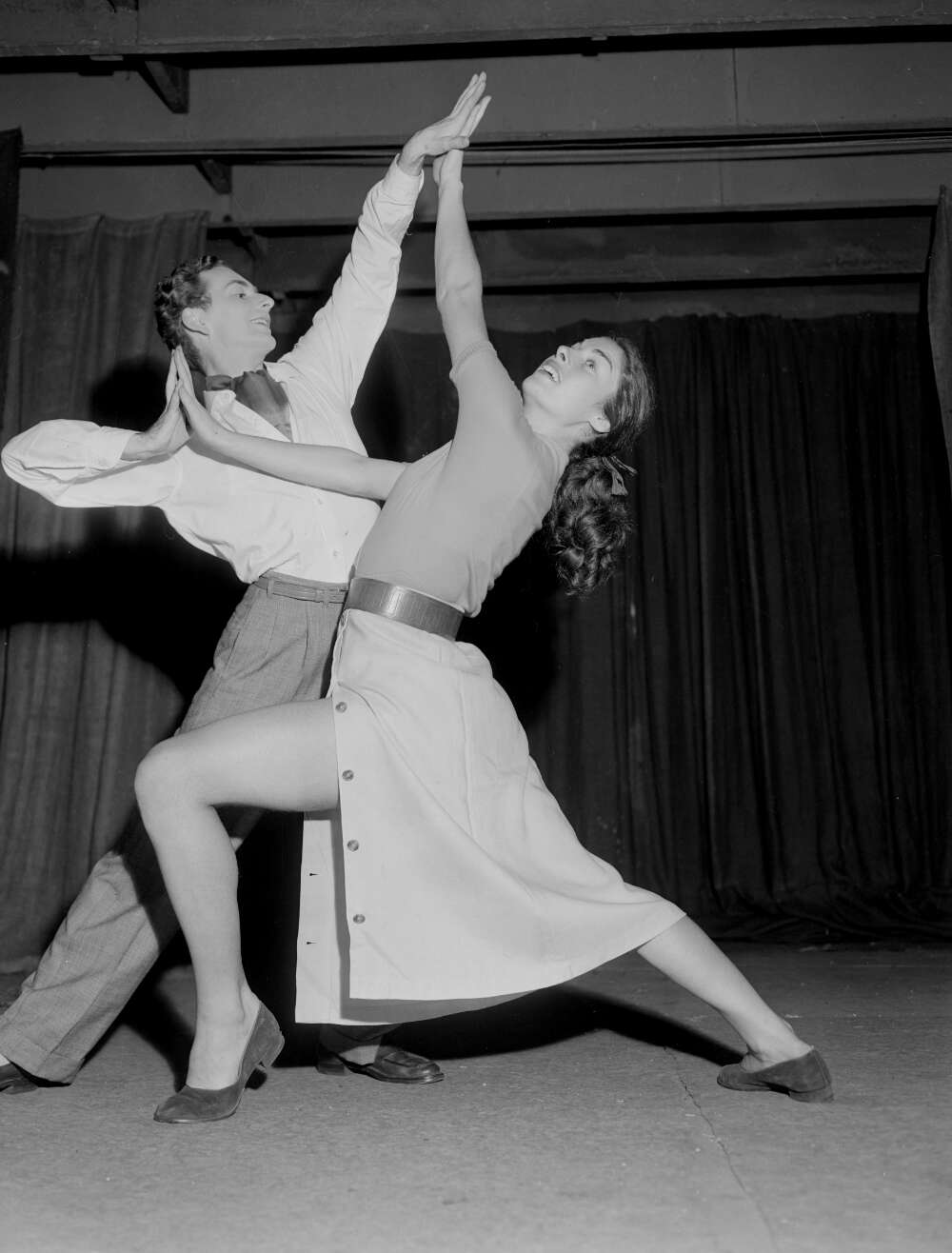
Brindle, Bill & Australian Information Service. (1952). Basil Pattison and Moira Claux in Basil Pattison's 'Modern America', Bodenwieser Ballet Retrieved, from http://nla.gov.au/nla.obj-136992959
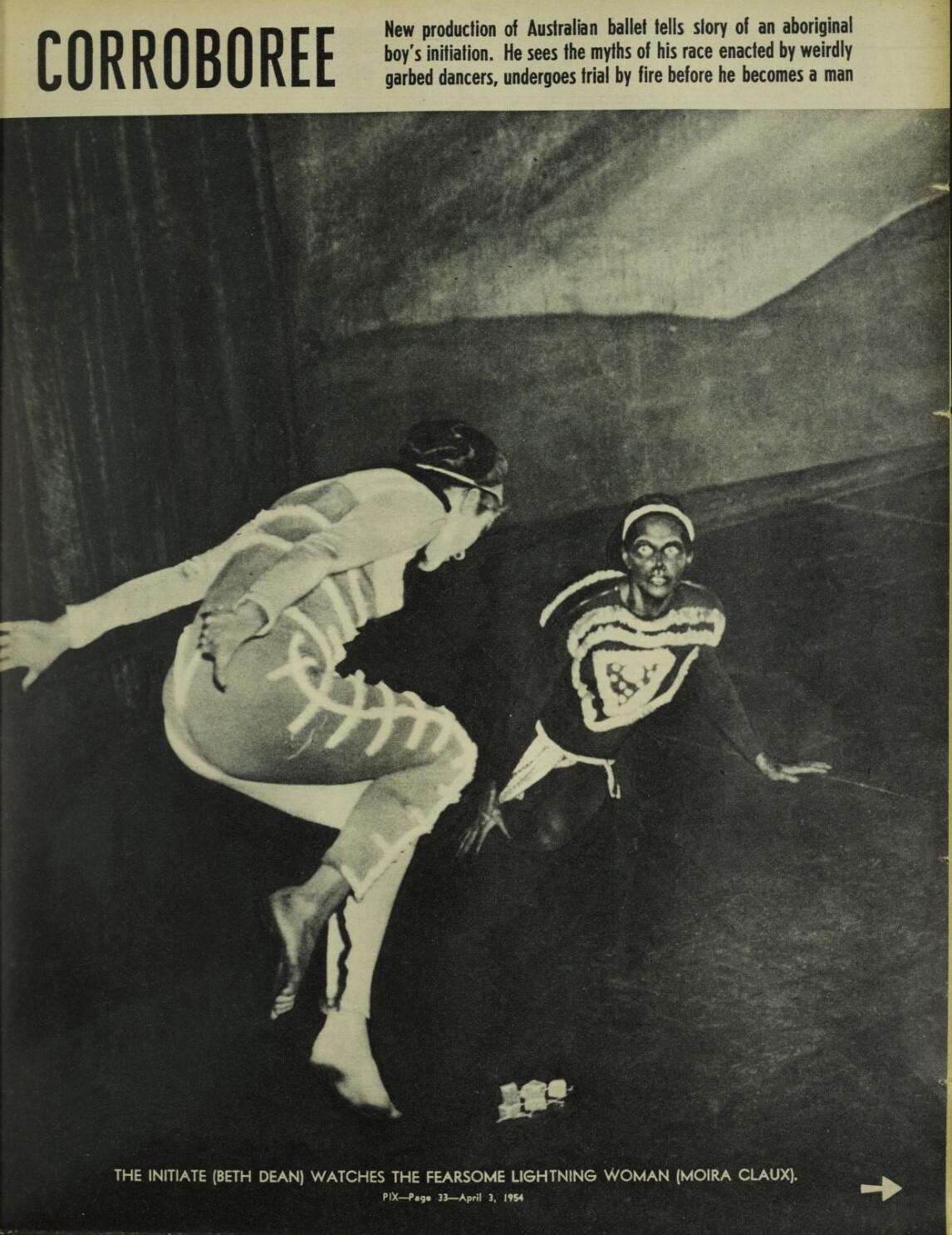
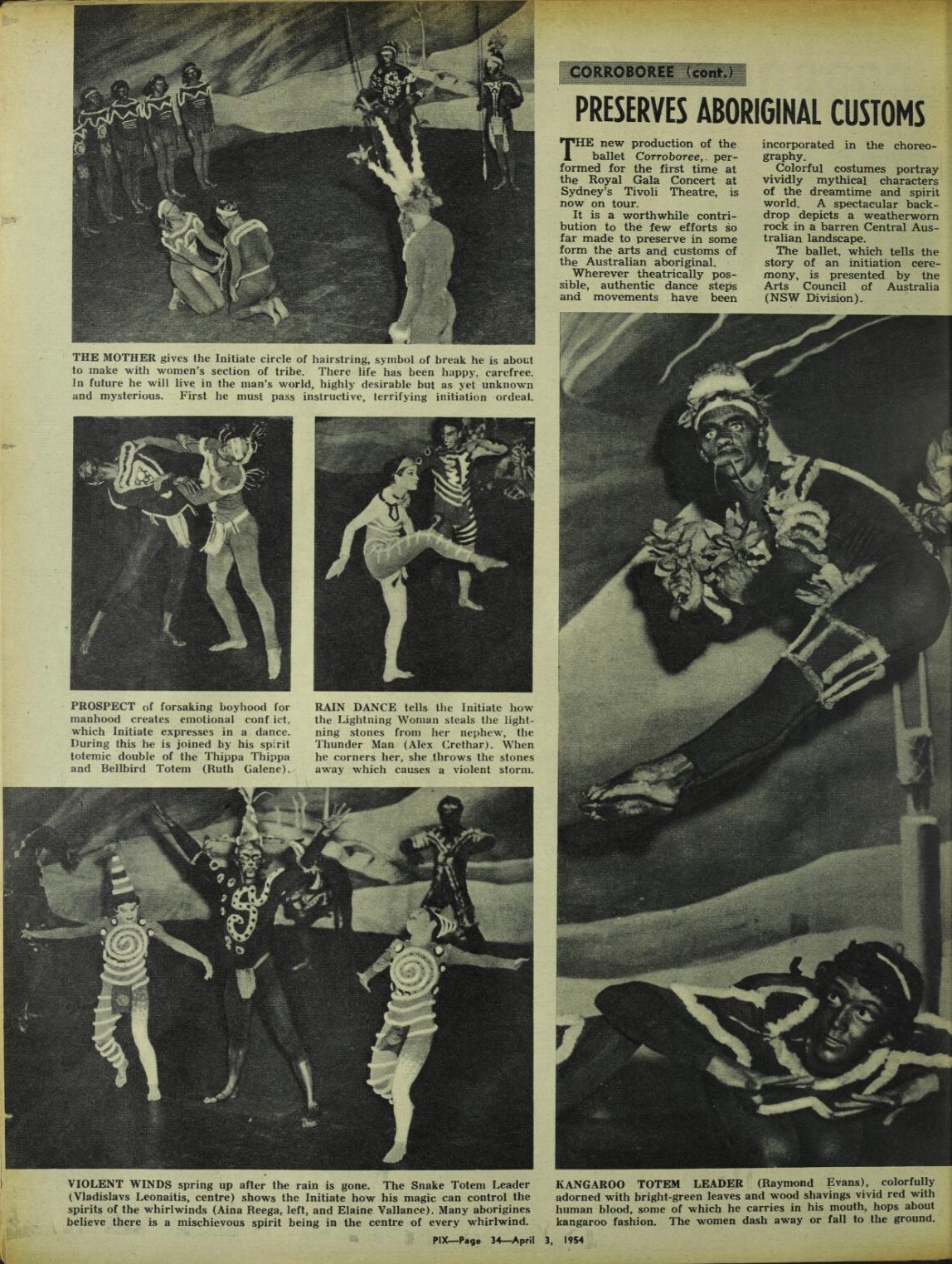
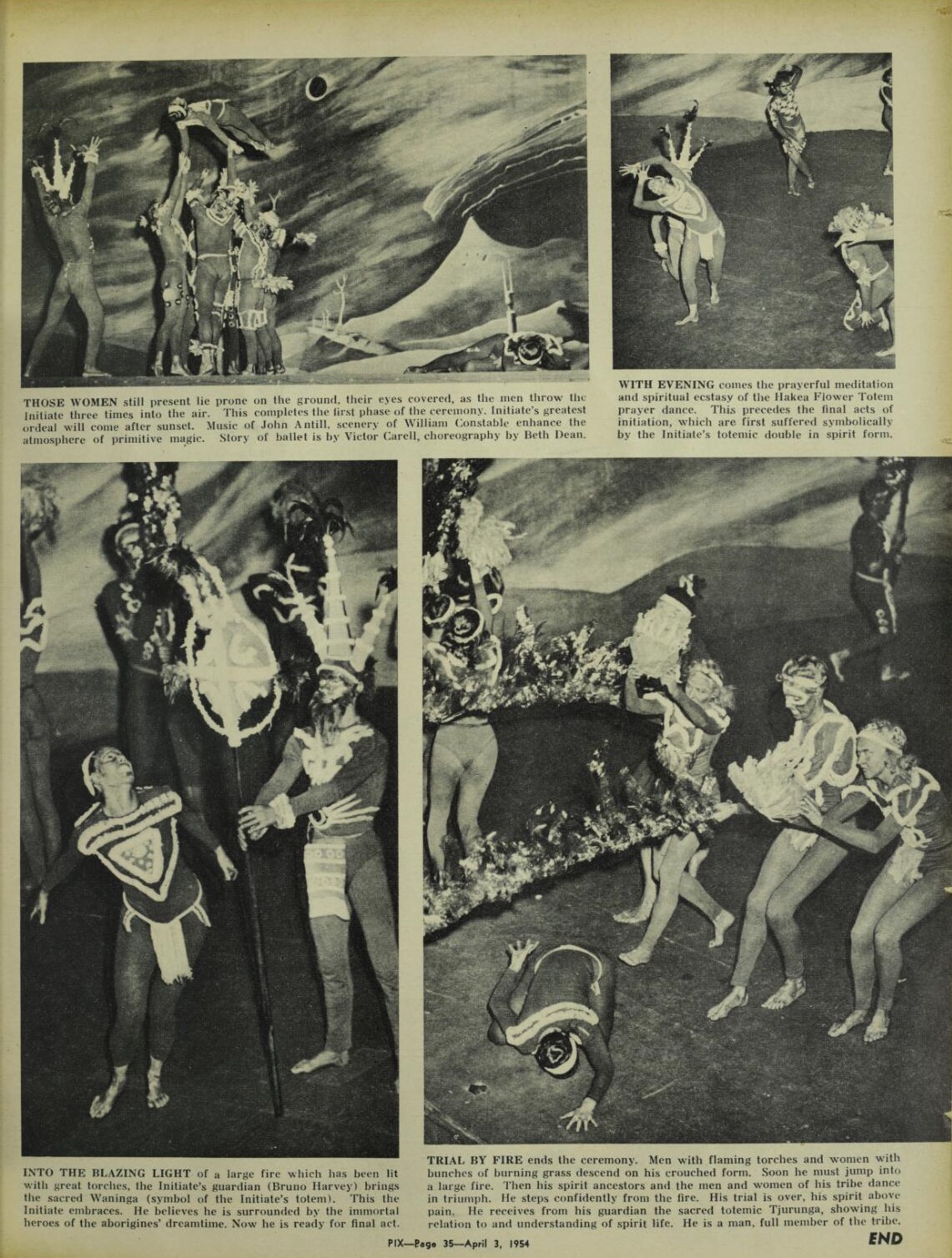
Corroboree': Direct from Royal gala performance before HM Queen Elizabeth and Duke of Edinburgh, Tivoli Theatre, Sydney, 1954 1954 Arts Council of Australia – NSW Division Production of Corrobboree : Pix Vol. 33 No. 4 (3 April 1954) Retrieved from http://nla.gov.au/nla.obj-475772479

Her Majesty Queen Elizabeth with New South Wales Premier The Hon. J. Cahill arrives at the Tivoli Theatre, Sydney, to attend the Royal Gala Performance of "Corrobboree". February 6, 1954. Item c15568_0091_h, from and courtesy
One more tentative connection persists through the then owners of Waiwera - Hopton Lodge, Bayview, Roy and Gweldoline Patricia Camille McCaughey, including speculation that it was here the Royal couple visited during that 'day off' on Monday February 8th, 1954. The McCaughey's had been scheduled to host the royal couple on the tour that was cancelled when the Queen's father passed away and subsequently went to the coronation of Her Majesty. Before the 1954 tour this item appeared:
Station hoists prepare for Royal guests
Elizabeth and Philip will relax in beautiful old Riverina homestead
By JOYCE BOWDEN
One of the four private homes in which Princess Elizabeth and the Duke of Edinburgh will stay in Australia is "Coonong," N.S.W., the home of Mr. and Mrs. Roy McCaughey.
The Royal visit will revive the splendor of past hospitality at "Coonong" where, at the turn of the century, its previous owner, the late Sir Samuel McCaughey, often entertained important overseas visitors.
AMONG the plans which Mr. and Mrs. McCaughey will suggest for the Royal visitors' I entertainment will be a bush picnic, complete with billy tea.
Irish born Mrs. McCaughey has lived in Australia for 10 years, but she told me that the bush picnic had never lost its novelty and appeal for her. She is sure that anyone coming from overseas would enjoy it as much as she does.
"My husband and I want to make the Royal couple's stay with us as restful and as happy as possible so that they can relax from their arduous official duties," Mrs. McCaughey told me.
No other guests have been invited to "Coonong" during the Royal visit there.
Princess Elizabeth and her husband will be able to see whatever they wish of the surrounding country and the various features of life on a sheep nation.
"I hope they'll be interested in seeing the whole performance of shearing from the sheci iack to the wool bale," said Mr McCaughey.
There will be a full moon on one of the nights the Royal party will be at "Coonong."
Moonlit lake
"ITS gardens and lake look lovely by moonlight, so I’m delighted," said Mrs. Mc Caughey.
"Very often when we go out on to the plains we see brolgas, or native companions.
I’m hoping they won't be shy at the sight of Royalty, and that Princess Elizabeth will be able to see the birds in their natural setting and 'dancing' their ballets. They are really more graceful than any prima ballerina."
The visit to "Coonong" will give Princess Elizabeth and the Prince an opportunity of seeing Riverina merino country.
The old homestead will remain unaltered for the Royal visit but Mrs. McCaughey is redecorating the suite which Princess Elizabeth and her husband will occupy.
The suite will comprise two bedrooms, one of which will be a dressing-room for the Duke, a private sitting-room, sun Porch, and bathroom.
Keeping in mind Princess Elizabeth's taste for pastels, Mrs. McCaughey has chosen a delicate pearl-green for the walls. The French lacquered furniture will be in the same shade, and so will the padded bedhead which is to be appliqued with white glazed chintz lilies. The bedspread will match the bedhead and will have a border of the white lilies.
The curtains will be in pearl-green silk damask and the chaise longue will be buttoned in orchid-pink. Princess Elizabeth's dressing table will be draped with the same material as the curtains and will have a mirror top. The bed-lamps will have white velvet shades lined with orchid-pink. Lustre lamp bases on the dressing-table will be fitted with white velvet shades lined with the palest orchid-pink.
The built-in wardrobe will be lined with orchid-pink georgette, and the dressing table drawers will be lined with sachets in the same shade. The carpet in the bedroom will be just off-white. Over the white marble fireplace will be an old mirror with a gold leaf frame which has been at "Coonong" since the house was built in 1877.
Crystal brackets will be on either side of the mirror. The bathroom will be cream with pale peach plastic curtains. Pearl-green walls will be used also for the Duke's dressing-room. The carpet there will be off-white. The curtains will have a cinnamon and oyster-green regency stripe. This will tone with two period wing chairs upholstered in dull antique copper-peach satin. Lamp bases will be limegreen and bronze with pale yellow shades.
The sitting-room walls will be the palest yellow. A limegreen carpet will cover the floor and the curtains are to be lime-green spotted silk.
The settee is to be covered in olive-green floral glazed chintz which has a design of cameos of deer and a border of pale yellow and copper-peach flowers.
The romantic story of Samuel McCaughey, who came to Australia to make his name and fortune far away from his Irish homeland, will no doubt interest Elizabeth and Philip.
In 1856, at the age of 21, Samuel, uncle of Mr. Roy McCaughey, came from Ballymena, in the North of Ireland, where he had a small property. With two partners he purchased "Coonong," Narrandera, which was then a cattle property. He turned it into a sheep property and later bought out his partners.
Samuel was financed by an uncle, Sir Samuel Wilson, who had come from Ireland and had properties in Victoria.
Samuel's brothers John and David came out to Australia from Ireland after the death of their mother. David was Mr. Roy McCaughey's father. There were also eight sisters at home in Ireland, but only one of them, Mrs. Chesney, migrated to Australia.
Later Samuel bought "Singorimba," "Goolgumble," "Coree," and "Yarrabee," all in the Riverina.
When these stations were running successfully Samuel went to the Darling, where he purchased "Dunlop," "Tooralie," and later "Nocholcche."
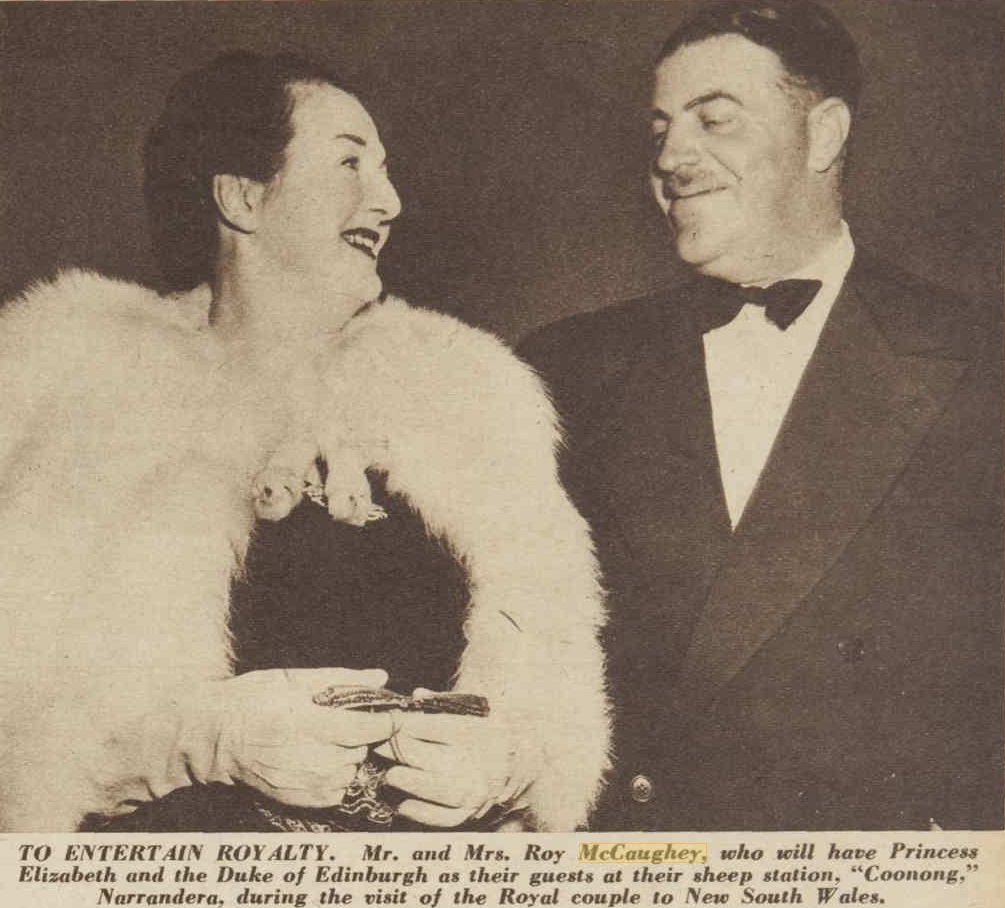
TO ENTERTAIN ROYALTY. Mr. and Mrs. Roy McCaughey, who will have Princess Elizabeth and the Duke of Edinburgh as their guests at their sheep station. "Coonong." Narrandera, during the visit of the Royal couple to New South Wales.
There were three million acres in these three properties alone, and in a good season a quarter of a million sheep were shorn.
In their early days David and John looked after the Darling interests. When Samuel sold out of these properties David took over "Coree," where Mr. Roy McCaughey was born, and John took up "Yarrabee."
Mr. McCaughey's father bought "Coree," Jerilderie, in the middle of the eighties. He married Blanche Gell, daughter of the Hon. Hoskins Gell, of Tasmania.
Huge bequests
SAMUEL, who was knighted in June, 1905, for his philanthropy, remained a bachelor. There were four children, two girls and two boys, in the David McCaughey family; Mr. Samuel McCaughey, named after his uncle, who has now retired; Mr. Roy McCaughey; Mrs. Tom Grantham, of Victoria; and Mrs. Ted Dermer, of Melbourne.
Mr. John McCaughey, who died in the mid-1920's, was twice married. His daughter, Miss Mona McCaughey, lives in Melbourne. His second wife lives in Sydney.
Sir Samuel, who died in July, 1919, was a staunch Presbyterian. He left part of his huge fortune to the Presbyterian Church. Among the many other beneficiaries were Sydney and Queensland Universities, the Burnside Homes, and Scots College. He also left sufficient money to educate 28,000 children of deceased and incapacitated servicemen of World War I. Seven of these children later became Rhodes Scholars.
One of the first irrigation schemes in New South Wales was established on one of Sir Samuel's properties, North Yanco, and the town of Leeton was built on part of it. Now Leeton is one of the biggest fruit and vegetable canning centres in Australian Leeton is also the largest rice-producing area in the Commonwealth. The former homestead has become the North Yanco High School.
In 1942 a charming Irish woman came to Australia from Singapore as an evacuee. She was Mrs. H. North Hunt, who before her marriage was Patricia Phelan, daughter of the late Mr. and Mrs. Walter Phelan, of Cork and Kilkenny.
A few months after her arrival here she and Mr. Roy McCaughey, then a bachelor, were introduced by mutual friends. At that time Mrs. North Hunt had not heard the fate of her husband, whom she had had to leave behind in Singapore.
"I received news at the beginning of 1944 that my husband had been killed, and I decided to return to England to make my home there," said Mrs. McCaughey. "It never occurred to me to think of marriage.
"I was discussing my plans for my return to England at a dinner-party one night and afterwards Roy suggested I remain in Australia and marry him," she added.
They were married on March 28, 1944.
"I think I must have been attracted to the Irish in him," said Mrs. McCaughey with a twinkle in her Irish blue eyes when she told me the story of their romance.
"When I think of Princess Elizabeth and Prince Philip coming to 'Coonong' I think of the first time I went there. I had never travelled such a distance over the Australian countryside before. I was amazed at the great expanse of empty plains and the 'oasis' of the old homestead when we reached it."
Mr. McCaughey bought "Coonong" in June, 1919, on his return from England after World War I.
"Coonong" shears 20,000 merino sheep, all of which are studs.
However, most of the time he and his wife live at another of their properties, Boramboli Park, Wagga.
Here Mrs. McCaughey has her famous Borambola Stud of Scottish beef Shorthorns. My hubsand and I are rivals, but friendly ones, as I have to depend on him for pasture lands!" she said.
.jpg?timestamp=1557017130912)
PRINCESS ELIZARETH and her husband will relax at thin beautiful old homestead, "Coonong," Narrandera, during their visit to New South Wales. Here they will have every opportunity of seeing alt phases of life on a big sheep station. Station hosts prepare for Royal guests (1952, February 13). The Australian Women's Weekly (1933 - 1982), p. 17. Retrieved from http://nla.gov.au/nla.news-article44552612
Australian Book For Queen
A presentation copy of Lady Harrison's book, "Me, Too," will be flown to London for presentation to .Her Majesty, Queen Elizabeth, next week. It is in ivory vellum with the title inscribed in gold lettering.
Special copies are also being prepared for the Governor-General, Sir William Slim, the Prime Minister, Mr. R. G. Menzies, and Mr. D. R. McCaughey, who guaranteed the cost of the second edition.
The book, which, is Lady Harrison's personal account of the Royal Tour, is in the second edition, the first being sold out. It proved very popular in London-the first 100 copies on sale at Australia House being sold in a week. All proceeds from the sale of the books in each State of the Commonwealth will raise funds for crippled children.
The second edition is on sale at all booksellers and at the head office of the N.S.W. Society for Crippled Children, 13 Chalmers' Street, Sydney, at 15/-. Australian Book For Queen (1956, March 10). The Canberra Times (ACT : 1926 - 1995), p. 2. Retrieved from http://nla.gov.au/nla.news-article138120517
From A Special Correspondent in London
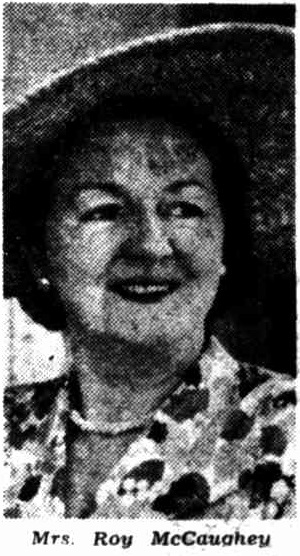 THE Queen has invited Mr. and Mrs. Roy McCaughey, of Narrandera and Darling Point, N.S.W., to a completely private Buckingham Palace reception on June 12 at which the Queen and the Duke of Edinburgh plan to entertain personal friends all over the world. The function is one of the very few non-official non-State parties given by the Queen over the Coronation period and the only private Royal party with an- international yet. non-political flavour.
THE Queen has invited Mr. and Mrs. Roy McCaughey, of Narrandera and Darling Point, N.S.W., to a completely private Buckingham Palace reception on June 12 at which the Queen and the Duke of Edinburgh plan to entertain personal friends all over the world. The function is one of the very few non-official non-State parties given by the Queen over the Coronation period and the only private Royal party with an- international yet. non-political flavour.
When as Princess Elizabeth she planned to tour Australia early last year, the Queen intended to break her heavy New South Wales programme by a quiet three-day rest visit with the Mc-Caugheys, on their Narrandera property.
Mrs. McCaughey will wear to the reception, which will be held at night, a magnificent floor-length gown in chalk-white peau de sole cut on princess lines and embroidered all over with a flower design worked in silver beads. The bustle-like back has a huge stiffened bow across the hips. Australians to be Queen's private guests (1953, May 28). Brisbane Telegraph (Qld. : 1948 - 1954), p. 18 (CITY FINAL). Retrieved from http://nla.gov.au/nla.news-article217137351
Queen invites NSW. couple to private party
From Hazel Fully
LONDON, Thursday.— The Queen has invited Mr. and Mrs. Roy McCaughey, of Narrandera and Darling Point, to a completely private : Buckingham Palate reception on June 12 where she and the Duke of Edinburgh plan to entertain personal friends from, all over the world' '"
This will be one of the very few non-official, non-State parties given by the Queen during the Coronation period and the only private Royal party with an 'international yet non-political flavor .'
When as Princess Elizabeth she planned a 'tour of Australia for early last year, the Queen intended to break her heavy NSW program with a quiet three-day rest-visit with the McCaughey 's on their lovely Narrandera property, Coonoong.
Mrs. McCaughey will wear to the reception, which will be held at night, a magnificent floor-length gown in chalk white peau de sole cut on princess lines and embroidered all over with a flower, design in silver beads..
The bustle-like ' back has a huge stiffened, bow across the hips. The gown is worn with a tiara, long White gloves, matching bracelet, necklace and earrings in sapphires and diamonds .. Queen invites N.S.W. couple to private party (1953, May 28). The Sun (Sydney, NSW : 1910 - 1954), p. 37 (LATE FINAL EXTRA). Retrieved from http://nla.gov.au/nla.news-article231045445
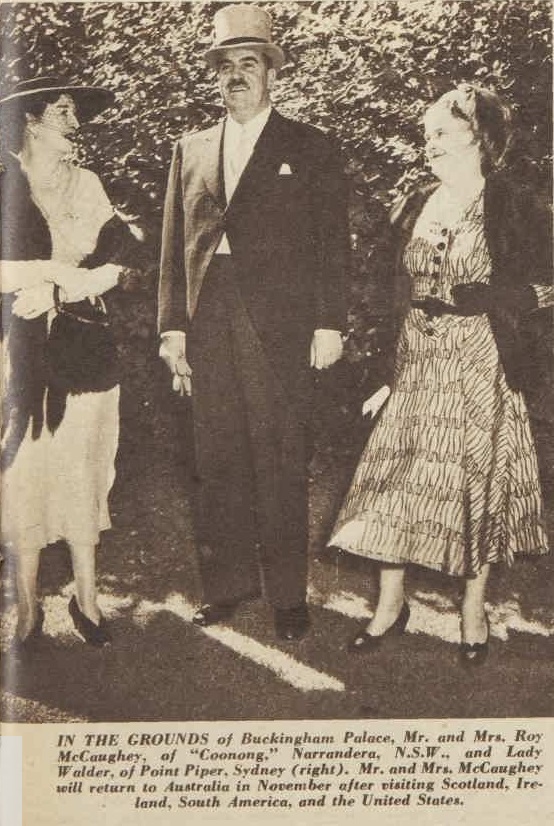
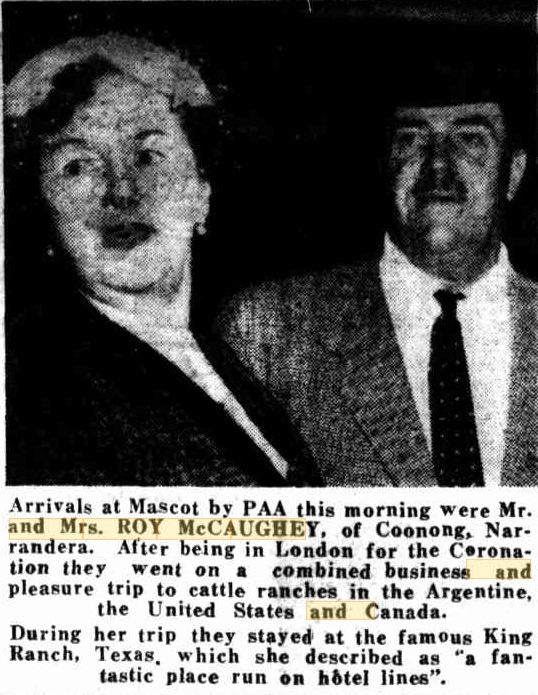
WELL-KNOWN Australian pastoralist, Mr. Roy McCaughey, and his wife, of Coonong, Narrandera, NSW, photographed at Mascot on their return from a combined business and pleasure trip to London for the Coronation and to cattle ranches in the Argentine, the United States and Canada. No title (1953, November 30). Illawarra Daily Mercury (Wollongong, NSW : 1950 - 1954), p. 7. Retrieved from http://nla.gov.au/nla.news-article134002452 Photo to left: June 1953 - Australian Women's Weekly
In 1956, the Duke of Edinburgh opened the Olympic Games in Melbourne, and opened the 1962 British Empire and Commonwealth Games in Perth, while on a tour through Western Australia, New South Wales and the ACT. In 1965 he opened the Royal Australian Mint, and in 1968 went to Australia to open the Duke of Edinburgh Study Conference.
Queen Elizabeth Queen Mother visited in 1958 to attend the British Empire Service League Conference in Canberra.
One of her most memorable visits for Australians was opening the new parliament in 1927 prior to becoming Queen. Queen Elizabeth, not yet a year old, had been left at home.
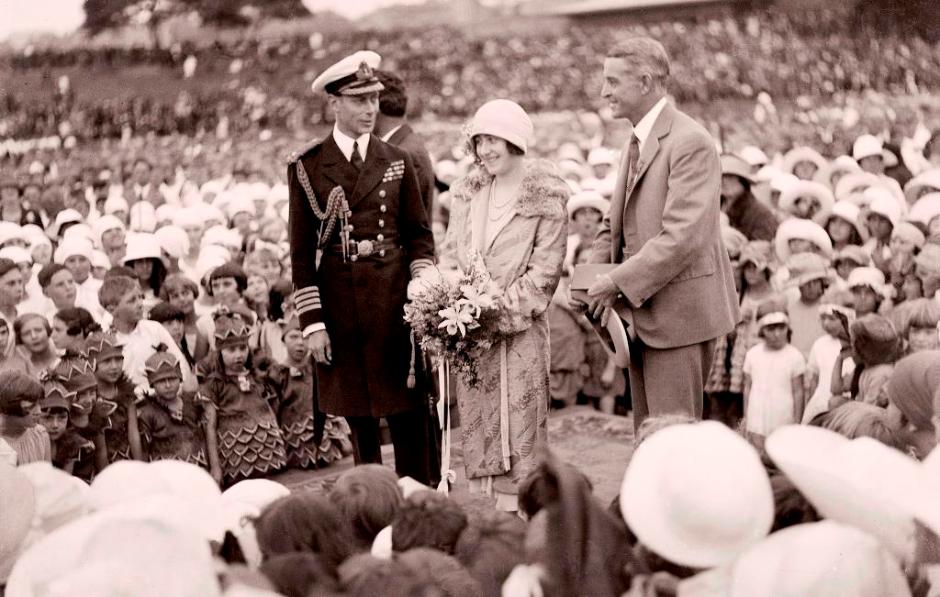
Duke and Duchess of York Addressing Crowds in Sydney during their Royal Tour, March 29th, 1927. Image: National Library of Australia
Queen Elizabeth was, in her own words, "very miserable at leaving the baby". Their journey by sea took them via Jamaica, the Panama Canal and the Pacific; Elizabeth fretted constantly over her baby back in Britain, but their journey was a public relations success. In New Zealand, the Yorks enjoyed the local fishing in the Bay of Islands accompanied by Australian sports fisherman Harry Andreas.
When they sailed into Sydney harbour on HMS Renown, they attracted Australia's first gathering of more than one million people. The principal duty of the Prince on this visit was to open the provisional Parliament House in Canberra, on May 9th 1927. They spent 12 days in New South Wales, seven in Queensland, four in Tasmania, eleven in Victoria, six in South Australia, six in Western Australia and three in the Australian Capital Territory, with the remaining 10 for travelling and recreation.
Their visit had been preceded by Edward, Prince of Wales, who arrived in Victoria on May 26th 1920, representing his father, George V (previously Prince George, Duke of Cornwall and York), to thank Australians for their participation in the First World War. He was accompanied by Lord Louis Mountbatten.
During the tour, his railway carriage overturned near Bridgetown, Western Australia. However, the Prince remained unharmed and made light of the situation, emerging from the wreck with some important papers and a cocktail shaker, an act which endeared him to Australians and caused them to give him the nickname the "Digger Prince".
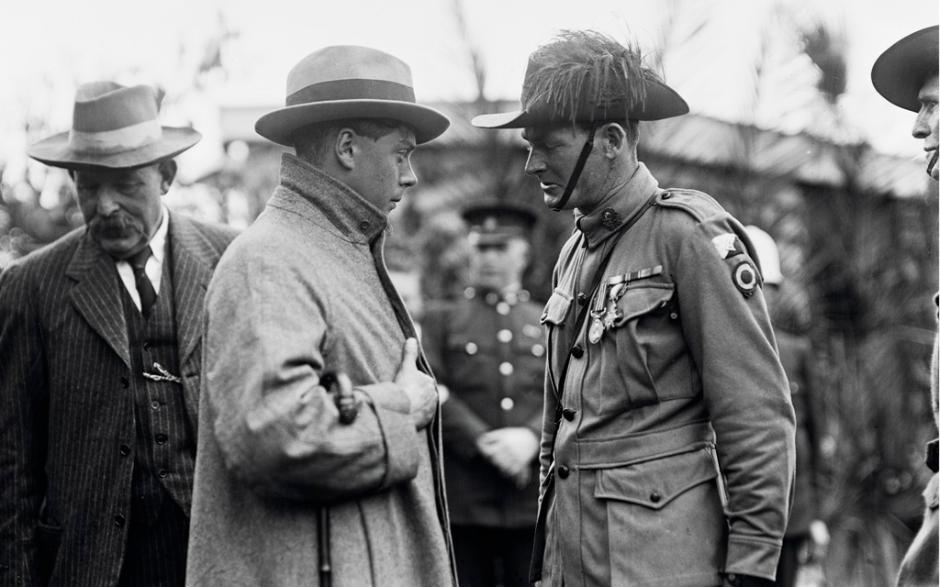
Edward, the Prince of Wales, speaks to a Soldier in Queensland during his Visit to Australia in 1920. Photo: National Library of Australia
THE PRINCE OF WALES - A MILITARY PARADE.
Sydney, June 22.
This afternoon the Prince was present at a military parade at the Centennial Park. The Prince, who had been cheered all the way from town, received a tumultuous welcome from the thousands present. As he came on to the parade his glance wandered to the two stands containing wounded men and relatives of the fallen. When he surveyed the dense mass of khaki he was visibly moved. After passing down the lines the Prince took his stand at the saluting base, and the assembled troops, forming into columns, continued towards the Oxford-street gate of the park, and reaching them halted, and divided on either side of the roadway, to form a long cheering double rank through which the Prince passed.
On his way back to town the Prince spoke in a number of officers and men, many of whom he had seen in France or Belgium, and some of whom he readily recognised. The whole ceremonial was impressive. There were representatives of every unit that left Sydney for the war, besides many other formations, such as Imperial troops, South African, and Soudan contingents.
The Prince was welcomed in Sydney today by representatives of 200 branches throughout the State of the Returned Soldiers' Association at a luncheon at the Town Hall. The president (Lieutenant E. F. McDonald) read an address, to which the Prince replied. In an adjoining room, 56 blinded soldiers and their escorts also sat down to lunch. His Highness shook hands with every one of them. The Prince said, "I may claim to say that this is only, au revoir and not good-bye. I am coming back in August, and I have arranged with the president of your association that the returned men shall have a day to visit the Renown and go all over the ship.'(Loud cheers.) THE PRINCE OF WALES. (1920, June 23). The Advertiser(Adelaide, SA : 1889 - 1931), p. 7. Retrieved from http://nla.gov.au/nla.news-article37521969
Queen Elizabeth The Queen Mother visited in 1958 to attend the British Empire Service League Conference in Canberra. She travelled to the Australian Capital Territory, Brisbane, Sydney, Melbourne, Tasmania, Adelaide and Perth, as well as many provincial and country areas during the time of her visit of February 14th to March 7th.
HER MAJESTY QUEEN ELIZABETH, THE QUEEN MOTHER
The Queen Mother, Queen Elizabeth, arrived in Australia on February 14 after visiting New Zealand. Her Majesty. who last came to Australia 31 years ago with her late husband, King George VI (then Duke of York) arrived in Sydney on Friday, February 21, and was received with great acclamation by the population. Departing from Sydney on Tuesday last to continue her tour of Australia, the Queen Mother will leave for England on March 7 by air, travelling via Cocos Islands, Mauritius, Nairobi and Malta. The above portrait is taken from a Cecil Beaton photograph. HER MAJESTY QUEEN ELIZABETH, THE QUEEN MOTHER (1958, February 28 Friday). Le Courrier Australien (Sydney, NSW : 1892 - 2011), p. 4. Retrieved from http://nla.gov.au/nla.news-article225602736
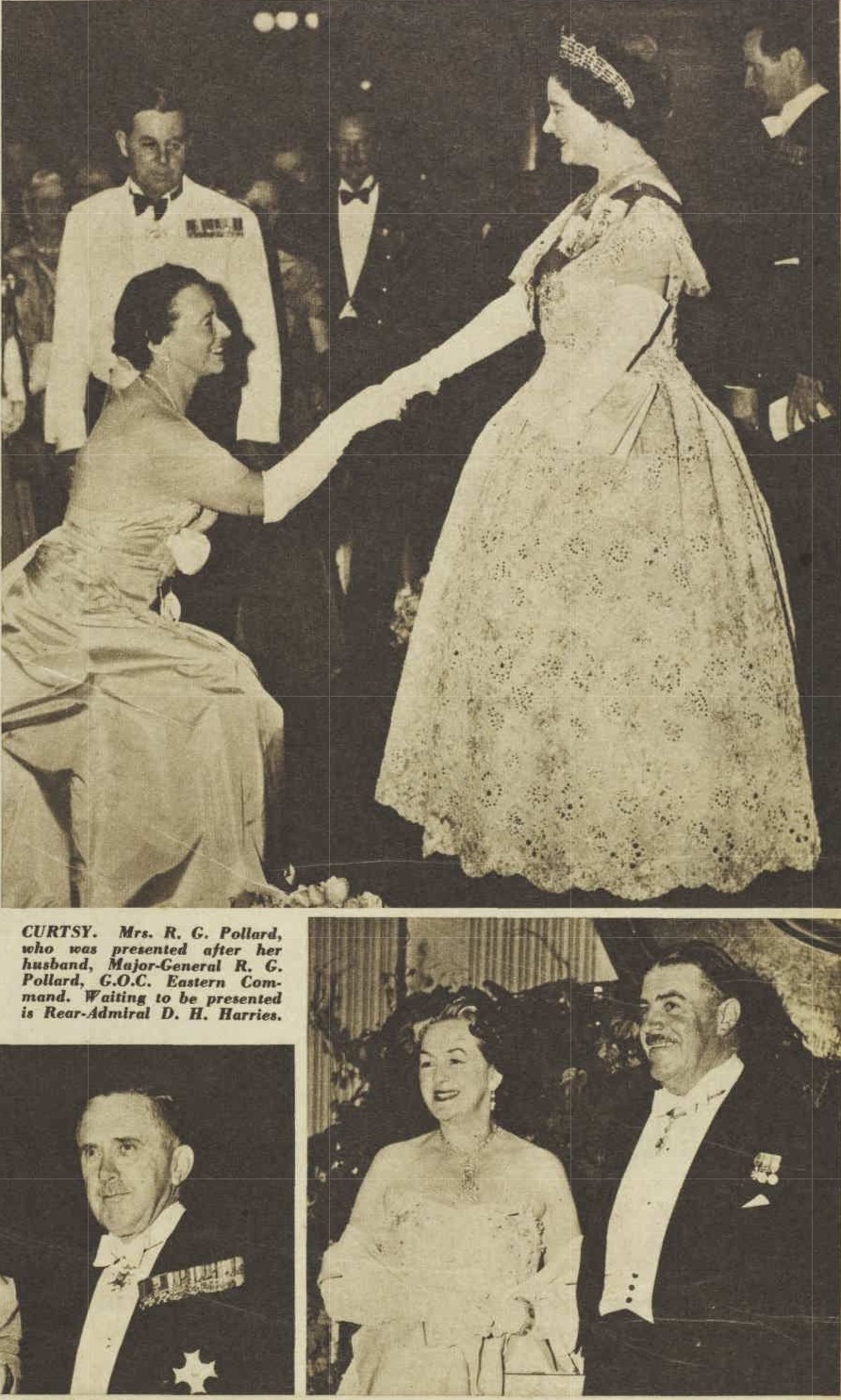
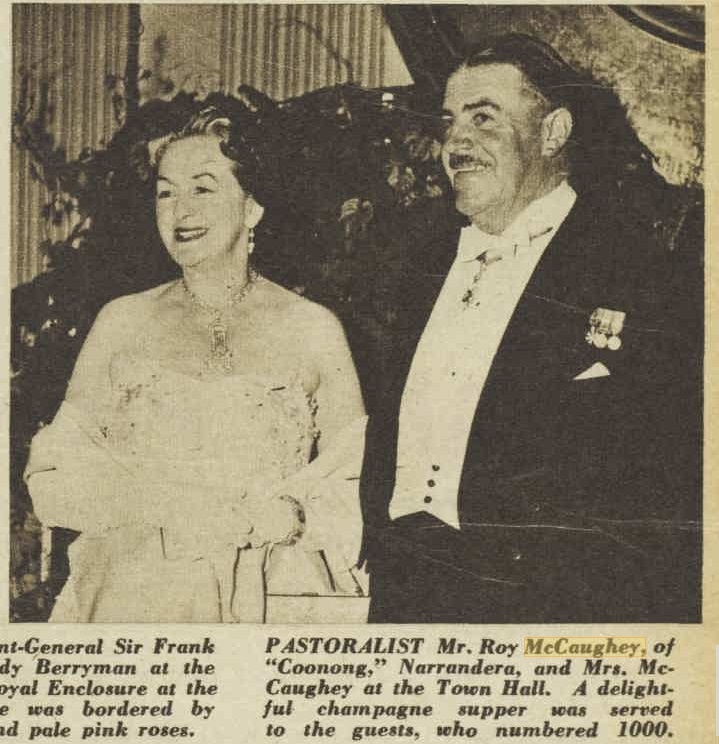
QUEEN MOTHER AT STATE RECEPTION (1958, March 5). The Australian Women's Weekly (1933 - 1982), p. 15. Retrieved from http://nla.gov.au/nla.news-article51598993
The Queen Mother attended a February 22nd 1958 Life Saving Carnival for her benefit at Manly, with Judge Curlewis once again acting as host:
THE QUEEN MOTHER MET SURFMEN .... AND SAILORS

OBVIOUS INTEREST was shown by the Queen Mother when she stopped to talk to this tall, bronzed lifesaver during the North Steyne surf carnival. With her is Judge Curlewis, who presented the men.
.jpg?timestamp=1662698334276)
.jpg?timestamp=1662698356966)
ABOVE: One of the most spectacular events of the Queen Mother's tour was the surf carnival at North Steyne, Manly. Here breakers provide a striking backdrop as she waves to the line-up of lifesavers. With her in the land-rover is Judge Curlewis, president of the Surf Life Saving Association of Australia. One thousand men paraded.
.jpg?timestamp=1662698389045)
BELOW: From the surf carnival, the Queen Mother returned to Sydney aboard the frigate H.M.A.S. Quiberon. From the ship's bridge, 34-year-old Commander Lealand Ponton, the only bachelor skipper of a seagoing R.A.S. ship, pointed out Harbor attractions. Earlier she visited Balmoral Naval Depot, where she had luncheon. SURFMEN... (1958, March 5). The Australian Women's Weekly (1933 - 1982), p. 5. Retrieved from http://nla.gov.au/nla.news-article51599021
Of course, when Queen Elizabeth II wasn't coming to Australia we would go to her. A Girl Guides company, the 1st Buckingham Palace Company, was formed specifically so she could socialise with girls her own age. Later, she was enrolled as a Sea Ranger.
At the 15th World Conference of the World Association of Girl Guides and Girl Scouts it was decided to mark the centenary of the birth of Lord Baden-Powell, the founder of Guiding, by holding a World Camp in four locations. These were the Philippines, Switzerland, the United Kingdom and Canada.
The Windsor World Camp was held at The Windsor Great Park, England was held from July 26th to August 8th, which this year was the 65th anniversary of this event.
This was the first time Australia sent a contingent of Girl Guides to Europe to attend a World Camp. These Australian girls would also visit Switzerland when the 3rd World Ranger Week was in session and this too was a first for Australia, being the inaugural time our country had been represented at a World Ranger Week. The 8 Sea Rangers that were part of the Australian girls group were in Switzerland from the 15th to the 26th of September along with all members of the Contingent who relished the opportunity of visiting and staying at "Our Chalet', in Switzerland.
Worth Reporting
AUSTRALIA'S first contingent of Girl Guides to visit Europe left Melbourne aboard the liner Fairsea last weekend. The 46 girls, taking gifts and souvenirs for Guides and friends overseas, will attend a world Guide camp in England's Windsor Great Park.
The camp opens on July 29 and lasts until August 7. It is one of four world meetings being held this year, and commemorates the birth of Lord Baden-Powell, founder of the Scout and Guide movement.
Four thousand Guides will attend the Windsor camp, which the Queen will visit.
The Australian girls are in the charge of Guider Miss Joy Stacy, of Sydney, Miss Peg Barr, of Melbourne, and Miss J. Tucker, of Adelaide.
They will tour England and Scotland and spend a fortnight at an International Guide House in Switzerland.
The first world camp this year was held in the Philippines. Australia sent 30 Guides. The other two camps will be held in Canada and Switzerland next August. Worth Reporting (1957, May 22). The Australian Women's Weekly (1933 - 1982), p. 30. Retrieved from http://nla.gov.au/nla.news-article47248132
Miss M Barr was actually the Victorian Leader and assistant of Joy Stacy, Contingent Leader. The 46 girls were aged between 15 and 17, with 14 Queens Guides and 32 1st Class Guides - 8 girls were Sea Rangers by the time they travelled.
Mary, Princess Royal and Countess of Harewood (Victoria Alexandra Alice Mary; 25 April 1897 – 28 March 1965), was the only daughter of King George V and Queen Mary. She was the sister of Kings Edward VIII and George VI, and aunt of the current British monarch, Queen Elizabeth II. Princess Mary's public duties reflected her concerns with nursing, the Girl Guide movement, and the Women's Services. In the period leading up to her marriage, girls and women in the British Empire called Mary and its variants (including Marie, May and Miriam) banded together to form "The Marys of the Empire," and donated money toward a wedding present. She presented this fund to the Girl Guides Association for the purchase of the estate of Foxlease, and following the exhibition of her wedding presents, also contributed half the proceeds to the same cause, for upkeep, a total of £10,000, which enabled the project to go ahead. Mary, Princess Royal became honorary president of the British Girl Guide Association in 1920, a position held until she passed away.
Dame Anstice Gibbs, DCVO, CBE (b. Hertfordshire, 2 January 1905, d. Hampshire, 7th February 1978) was the Chief Commissioner of the Girl Guides Association in the UK for ten years, and vice-chair of the World Association of Girl Guides and Girl Scouts (WAGGGS) from 1957 to 1960. She visited Girl Guides in Sri Lanka, Pakistan and Australia in 1956 and returned in 1964. Her final role in Guiding was as Chair of the UK's Planning Committee for WAGGGS’ 22nd World Conference held in Sussex in 1975. Dame Gibbs spent more than 70 years as part of the Girl Guide movement.
Photos courtesy Helen Guesdon, nee Ross.
Planned as a less formal tour than the one in 1954, the Queen and Prince Philip returned in 1963, touring all the states and territories, with the primary purpose being to lead the Canberra jubilee celebrations commemorating the 50th anniversary of the naming of the capital. During this trip she also toured the Royal Flying Doctor Service of Australia base in Alice Springs. In preparation for this tour, Sir Roy Dowling, the Queen's Australian Secretary for the visit, was warned about Northern Territory mosquitoes. Dowling was warned, "You could be placed in an extremely embarrassing situation if the Queen's skin was marked and if the press published pictures and stories about those marks''. Cities and towns visited included Sydney, Canberra, Darwin, Kununurra, Perth, Adelaide, Brisbane, Coolangatta, and Koolan Island.
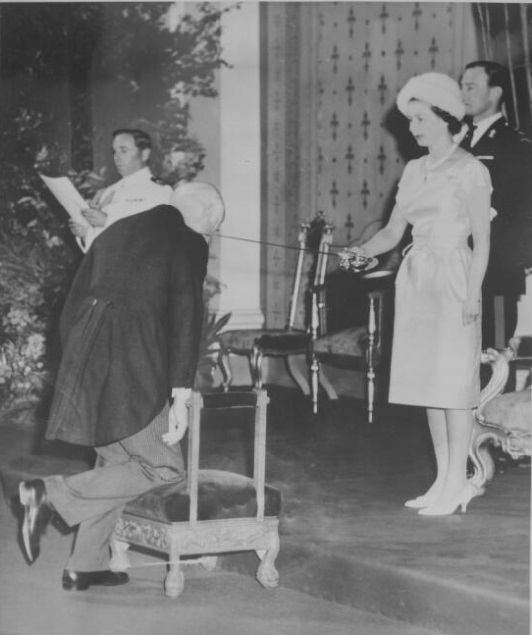
1963;Queen Elizabeth II investing Roy McCaughey at the Investiture ceremony at Government House, Sydney, New South Wales, 4 March 1963 – was a Monday. State Records of NSW
Another local who actually went to Queen Elizabeth II was Avalon Beach gentleman John Seaton MBE (April 27 1927 - March 13 2020). John Seaton served in Korea in the Royal Australian Air Force. He was involved in establishing airstrips in the Pacific and wintered in the Antarctic at Mawson Station in 1956 with the first RAAF crew to do so. Flying inland from Mawson, he discovered what was then thought to be the world’s biggest glacier, the Lambert Glacier. Seaton Glacier is named after him.
The 1956 wintering party accomplished a lot. They built the first hanger in Antarctica and flew throughout the year. The two pilots, Doug Leckie and John Seaton, clocked up a total of 1200 flying hours. During the year they transported 11 tons of food, fuel and equipment; they transported 150 passengers; flew 27 mapping sorties taking a total of 12,000 aerial photographs. Director Phillip Law was delighted with the success of the scientific program, made possible by the use of aircraft. For his exploration in the Antarctic John was awarded the Polar Medal.
Afterwards John spent six years flying for QANTAS, and later became general Manager of Solomon Islands Airways, where he established 21 airfields and a profitable little airline. For his work in the Solomon’s he was awarded an MBE by Queen Elizabeth.
He also flew part-time with Aquatic Airways at Palm Beach until June 1985.
During his interview for his Profile he and wife Barbara explained their first and second meetings of Her Majesty:
I was with Qantas for about six years but it wasn't quite my cup of tea, and I got back into commercial aviation, and ultimately I became general manager and chief pilot of Solomon Island Airways Limited, based on Honiara in the Solomon Islands.We formed an airline called Solomon Islands Airways Limited, SolAir and it was pretty hard work in the early days. We had to open up lots of airstrips, get better aircraft and get the maintenance schedule working well. This too was still littered with refuse from WWII, there were empty shell cases everywhere, it was still a mess.Ultimately we ended up with 21 airfields and it became a very fine little airline and in profit. We were there for 8 years. I was flying some of the old wartime Catalina’s up there – amazing long range planes – flew them up on the Fly river too, in New Guinea, for Qantas.You had to know your tides when stationed in New Guinea. We had a mooring up there. You had to know your tides as when the river’s full it’s time to land and then it starts to run out again. Qantas then got three Otters, which we’d fly out of Moresby. An Otter was more or less a large Beaver, a ten or eleven passenger single engine aircraft still. It was quite pleasant flying up there around the coast and the delta and up and down the rivers, I enjoyed that. They were amphibians too.I used to like flying up to the three large, freshwater lakes Paniai, Tigi, and Tage. They are located in the Paniai Regency in the central highlands of West New Guinea – a beautiful place.All the time I was up in the Solomons I enjoyed it immensely. I was awarded the MBE [Member of the British Empire] while I was up there, for services to the Solomon Islands, and the people of the Solomons. I went to an investiture at Buckingham Palace for that, which was very interesting.What did you wear Barbara?Well, I had to go to England to buy the gear because all I had was tropical stuff. Fortunately we were there early enough to do that. I had a very plain tailored black dress with roses on it and a very stylish black hat with a pink felt band, the same colour as the roses and a grey overcoat with a fur collar. I bought the handbag and gloves in Scotland and it was a good outfit, suitable. It was November 1975, so it was cool, bit not old.Sounds spiffy – what was perspective of the experience John?Well, we’d already met the Queen when the Britannia came to the Solomons on the Royal Tour of 1974 after the Queen had attended the closing ceremony of the New Zealand Commonwealth Games. We had a very lovely dinner aboard the ship, Lord Mountbatten was there, a fine man.What did the Queen say to you when she gave it to you?She asked me where I was from, because she had forgotten that she’d met me before. I said I was from the Solomon Islands. “Oh, Honiara, yes I remember being there last year and it rained all the time.” She thanked me very much for my services to the Solomon Islands and pinned the aforementioned medal on my chest.The Most Excellent Order of the British Empire is a British order of chivalry; rewarding contributions to the arts and sciences, work with charitable and welfare organisations, and public service outside the Civil Service. It was established on 4 June 1917 by King George V, and comprises five classes, in civil and military divisions, the most senior two of which make the recipient either a knight if male, or dame if female.The five classes of appointment to the Order are, in descending order of precedence:Knight Grand Cross or Dame Grand Cross of the Most Excellent Order of the British Empire (GBE)[a]Knight Commander or Dame Commander of the Most Excellent Order of the British Empire (KBE or DBE)Commander of the Most Excellent Order of the British Empire (CBE)Officer of the Most Excellent Order of the British Empire (OBE)Member of the Most Excellent Order of the British Empire (MBE)What did you do after the Solomons?After the Solomons I stayed in Sydney most of the time. I kept going back to the Solomons for a time, to relieve and do flying training for the fellas up there, and endorsements and ferry and that sort of thing aircraft out of Australia to the Solomons.When did you move to Avalon?In 1976. I semi-retired out of flying then and did a bit of part time flying on floats out of Palm Beach with Vic Walton for two and a half years. I really enjoyed that, loved it, even though I was only flying part-time.I even did one right around Australia for a television program called Pelican’s Progress, which was done by Bob Raymond. We had three aircraft and were looking at all the coastlines. It was Reg Morrison a great photographer – you’ve probably heard of Reg – who did that. Ultimately I didn’t fly much more after that because my eyes were really bad then, and I had to give it away.I spent most of my time involved in a bit of charity work and a little bit of involvement with air force association work. Until now, I’m aged seventy seven and I’ve got a life that’s pretty comfortable still, and I reside here with my wife, and the family are all grown up. I’m a grandfather of five, and here we are talking to you.
Another local who went to Her Majesty was Palm Beach - Avalon Beach gentleman Ray Henman ACS. Ray went to England for work as a cameraman and secured a job with the BBC during the 1960's. During the interview for his Profile he shared:
How long were you with the BBC?
Ten years in UK and the world and 30 years based in Sydney.
Could you share a few insights from then ?
As part of what I did there I filmed the Queen’s Christmas Broadcast for six years.
How that came about was one of the very first shows I worked on was an Earls Court Billy Graham presentation. The Head of that was a man who worked in documentaries called Richard Cawston, who June worked for. He gave me a camera and I was busy just putting in magazine after magazine recording the whole ten minute runs. They needed some shots so they handed me a Bolex camera and said ‘can you go and get some cutaways.’ So I went around everywhere and shot about 200 to 300 foot of undercut rolls. He later came to me and said he’d used every inch of film footage I’d shot.
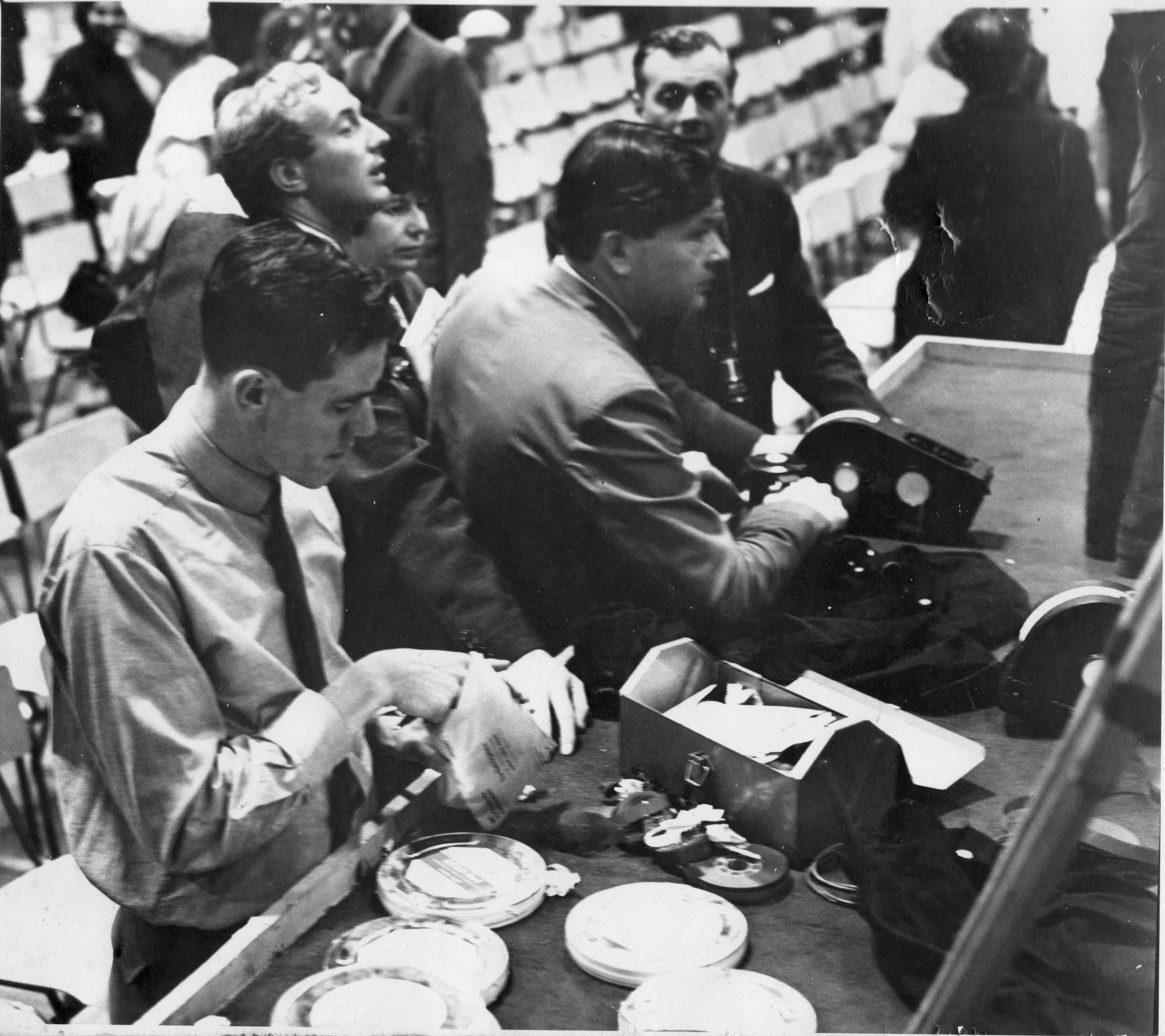
Ray - Earls Court work; Ray is closest to camera
In 1968 Richard Cawston directed ROYAL FAMILY, he was the head of documentaries and it was a year in the making, Peter Bartlett (R.I.P.) was the main cameraman and I was brought in as 2nd camera. I was fitted for a Saville Rowe suit and given a gold crown pass which opened many doors on Royal occasions. After the documentary Peter then moved into the drama department. It was then that Cawston promoted me together with my assistant Philip Bonham-Carter to film the Christmas message for six years also the Prime Ministers conferences. One meeting was in Ottawa when Gough Whitlam was in office. He asked myself and another Australian cameraman why we weren’t back in Australia supporting the film industry.
I also filmed in Rio when the Queen travelled on board the Britannia for part of the ROYAL FAMILY shoot.
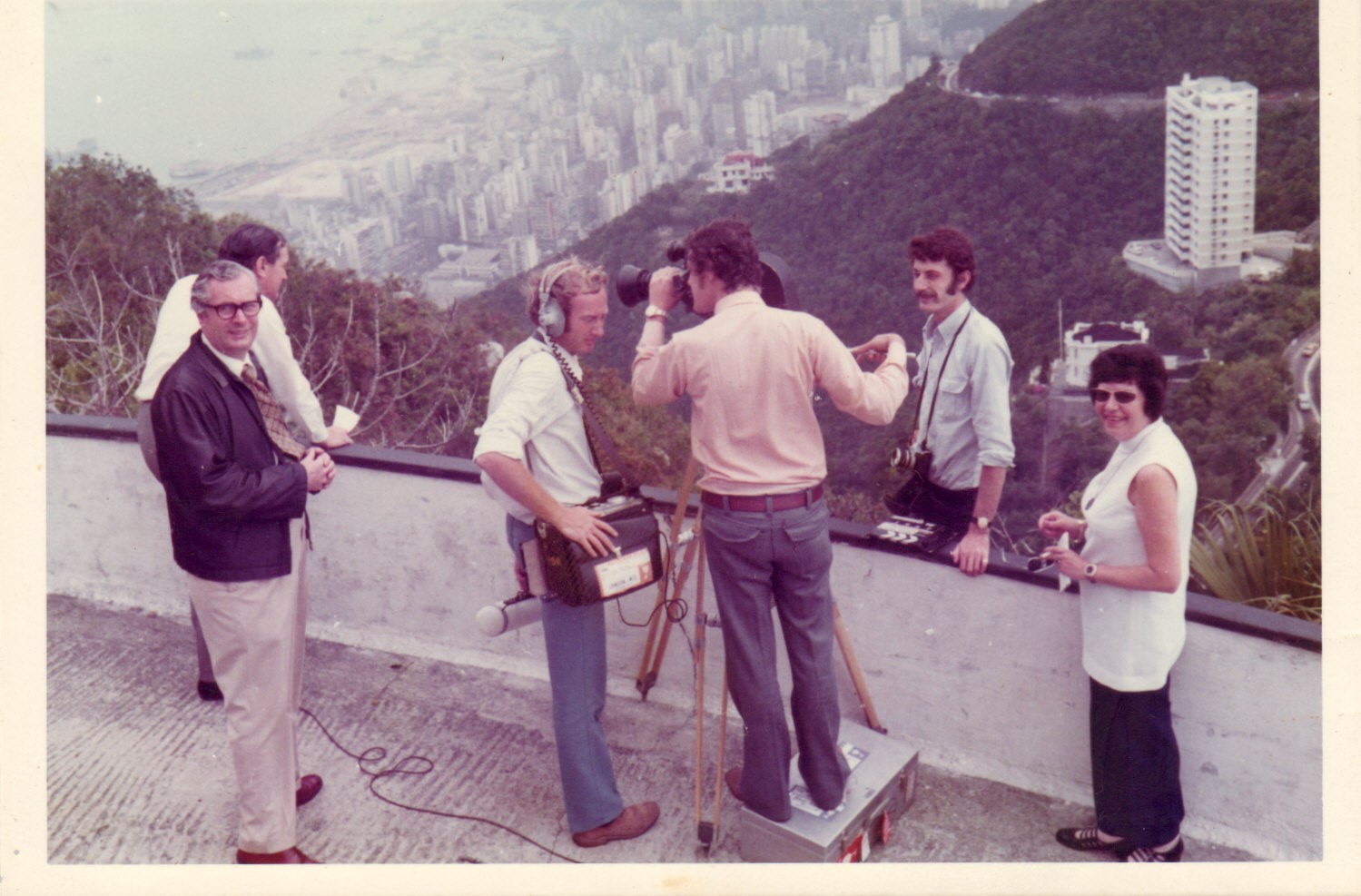
"Royal" crew in Hong Kong
In the early 70’s one Christmas broadcast became a bit of a challenge. PM Edward Heath had taken on the coal miner’s union, the miners wanted clarification on mine closures and blackouts were occurring particularly in the north of England they were slowly creeping south. Heath nicknamed ’The Grocer’ dug in his heels.
I remember three days before the actual recording was scheduled, the gaffer and myself went to the Palace to do a rece and check out where we were going to film the message. I looked at the blackout situation and said to Dave ‘do you think these blackouts will reach London’ …’ ‘na bruva, they wouldn’t dare black out Westminster and the Palace.’ ‘has the Palace got a main generator ?’ ‘I asked ‘must ‘ave’ was the cautious reply. I asked him to check. It turned out, they didn’t, they just had little portables but no main generator. I said we should order a 15 kilowatt gene just to be sure, and park it outside the Regency Room – “think yer overtrainin’ but I’ll order one just to be on the safe side. ‘
On shoot day we were due to film at 5 o’clock, the blackouts had reached North London, we set up for filming cabling up the gene at the same time.
At 5pm the Queen arrived and began making adjustments to Autocue. At 5.30 we began filming but after 5 minutes the Palace went to black …… The Queen said ‘it must be a local fuse’ no ‘Ma’am, it’s the whole Palace, our gene had come to life and the lights faded up. Panic in the rest of the Palace, household staff were running around lighting candles, corgis were barking and Princess Anne came in to see how we were doing.
An hour later we had finished the recording, the Queen said she had some letters to write so we left the generator running and left one of the sparkies to refuel it till the mains came on again ….. that didn’t happen till 2 am the next morning!
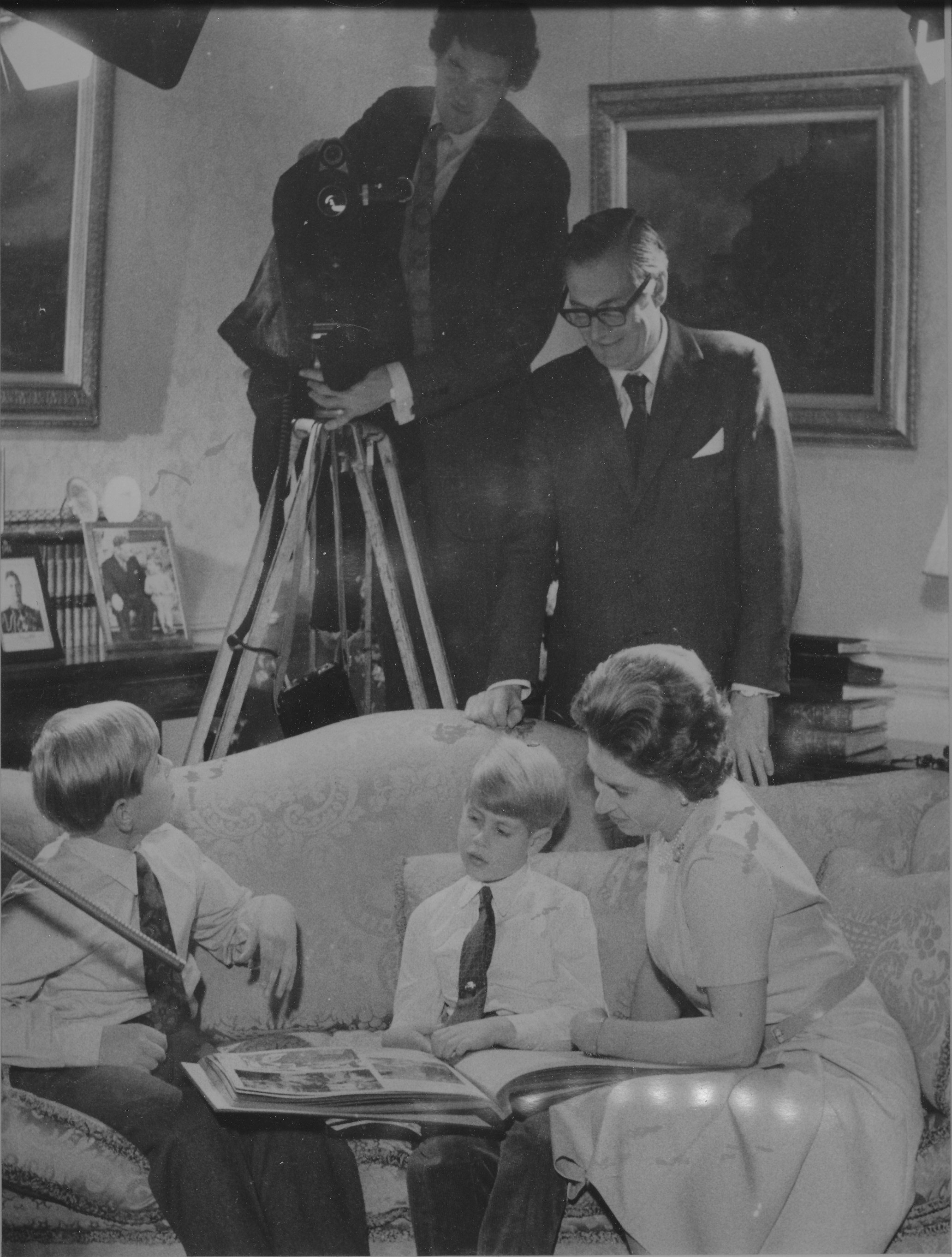
Ray and director, with Her Majesty Queen Elizabeth II with Prince Andrew and his brother Edward 1971. This Christmas Message is available in the YouTube video:
Many still remember Her Majesty’s later visit to Allambie Heights and then to Manly, to the Royal Far West Children’s home in 1970.
Her Majesty Queen Elizabeth II and her daughter Princess Anne visited the Far West Children’s Health Scheme, Manly, on Saturday May 2nd, 1970. Following the visit the prefix “Royal” was granted in recognition of the unique, long-standing services the Far West provide. Following this visit, the prefix ‘Royal’ was granted in recognition of the unique, long-standing services Royal Far West provide for children. Her Programme for that visit may be read at: Australia. Department of the Prime Minister and Cabinet. (). ROYAL VISIT TO AUSTRALIA 30 MARCH to 3 MAY 1970 Retrieved from http://nla.gov.au/nla.obj-3066095486

Her Majesty Queen Elizabeth II at Manly. Image courtesy Royal Far West

In total Her Majesty Queen Elizabeth II made 16 visits to Australia during her reign. One memorable occasion was her opening of the Sydney Opera House in October 1973. Indigenous actor Ben Blakeney, one of Bennelong’s descendants, gave the official welcome during the opening of the Sydney Opera House, and the then unknown actor David Gulpilil was among those performing a ceremonial dance.
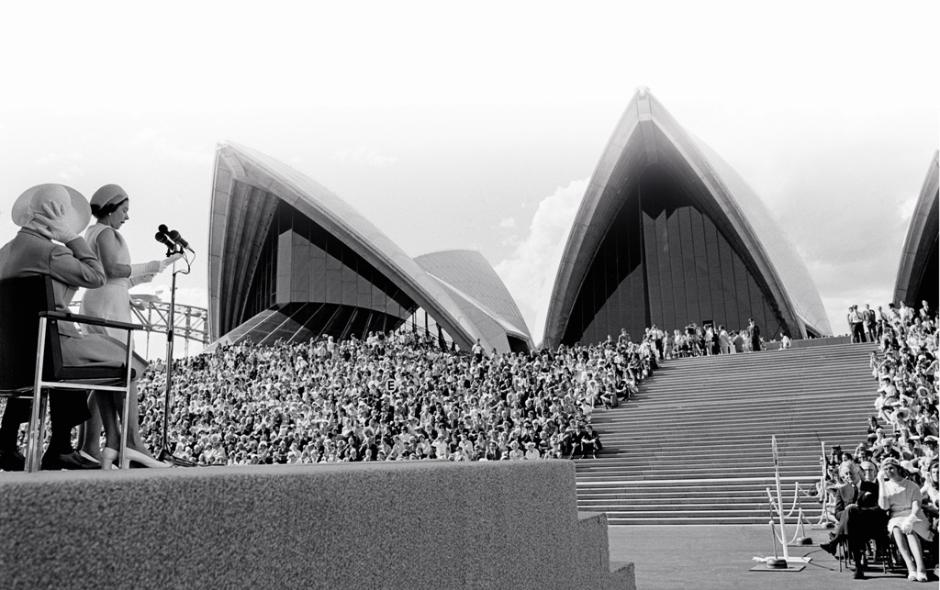
Australian Information Service - Royalty - Queen and Royal Family - The Queen in Sydney for an Opening at the Opera House, New South Wales, New South Wales, 1973. b&w photograph - National Archives of Australia NAA A61801/11/73/49 Courtesy National Archives of Australia.
Her eldest son, Prince Charles, now King Charles III, made his 16th trip to Australia in 2012 with Camilla, Queen Consort to mark the Queens Diamond Jubilee, taking in Tasmania, Victoria, New South Wales and the Australian Capital Territory.
He returned in 2015 and again in 2018, this time Royal Tour to open the Gold Coast Commonwealth Games. HM also visited Bundaberg to celebrate Prince’s Trust Australia’s Low Glow campaign with Greenfleet and Disney ANZ, and convened His Trust’s Great Barrier Reef roundtable on Lady Elliot Island with the Great Barrier Reef Foundation.
His first visit here was to attend school. Peter Bodman sent this email and images in during our 2020 Issues:
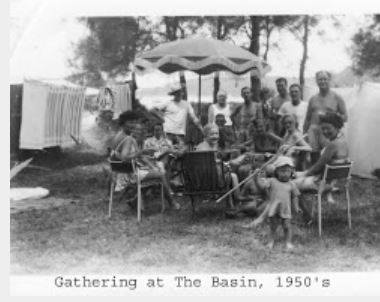
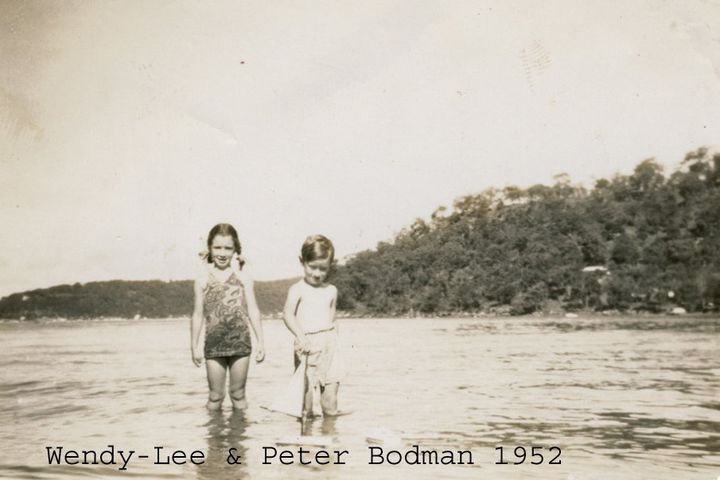
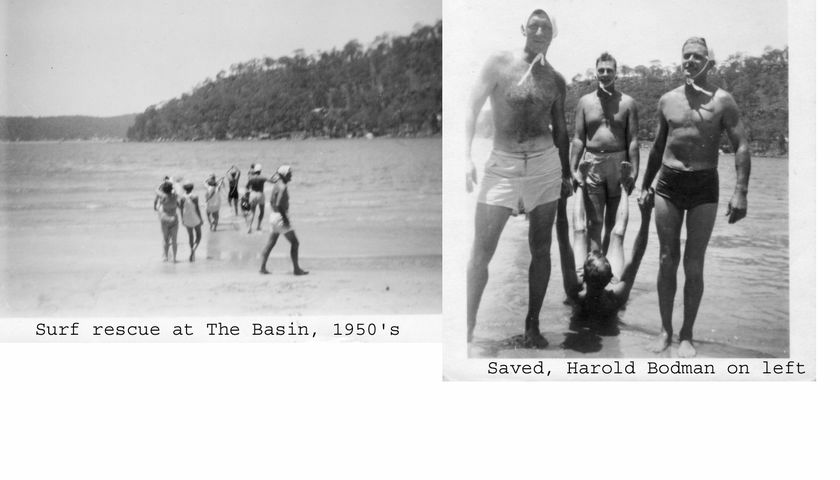
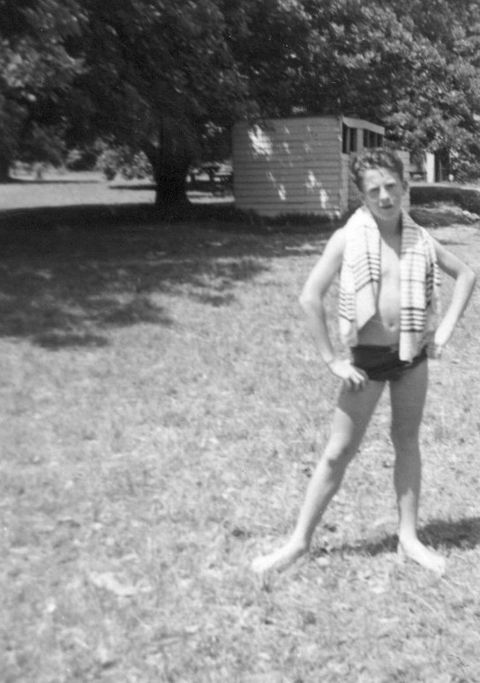
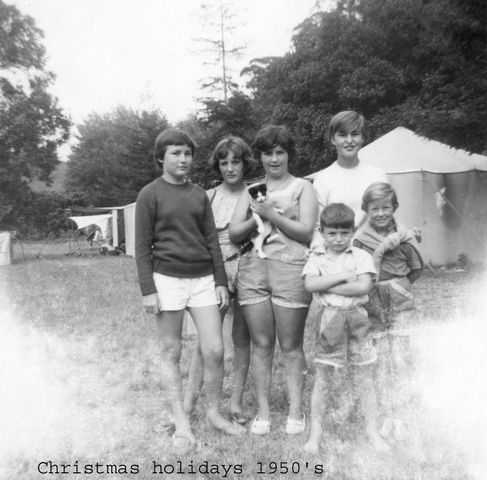

Topham - "Beechwood" also sometimes as 'Beachwood' Mr. F. W. Jackson's Cottage at The Basin [From NSW Government Printer series: Kuring-gai Chase No 52] Date: 01-01-1900 to 31-01-1900, courtesy NSW State Records and Archives.
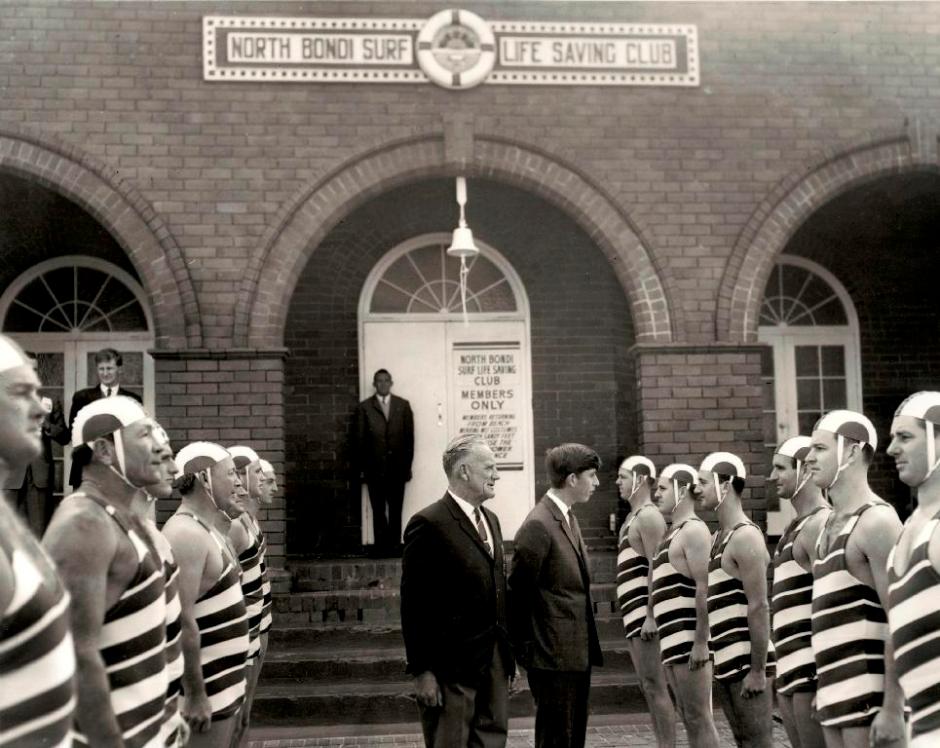
Page 165 of Royal Visits to Australia: Ern McQuallan (b. 1926) Prince Charles at the North Bondi Surf Club, with Club President Charlies Christenson (and Life Savers), May 25th 1966. B7w photograph. Pictures Collection -nla.gov.au/nla.pic-vn3562116
His 1967 visit was to represent The Queen at the memorial service for Prime Minister Harold Holt who disappeared off Cheviot Beach in Victoria.
In the 1980s the Queen made short tours to open the new High Court of Australia building in 1980 as well the City Square in Melbourne, then again to open the new National Gallery of Australia in 1982 and the Parramatta Stadium in 1986. During the 1986 visit, at a ceremony held in Government House, Canberra, she signed a proclamation that brought into effect the Australia Act 1986, which severed the final constitutional link between Australia and the United Kingdom.
Lady Diana Spencer, later Princess of Wales, made a short private visit to Australia with her mother and step-father to their sheep station at Yass, north of Canberra, in early February 1981. Prince Charles had proposed to her less than a week before.
The Prince of Wales visited Australia shortly after the announcement of his engagement and prior to his July wedding in 1981.
The Queen attended the 1981 Commonwealth Heads of Government Meeting (CHOGM), held in Melbourne in September.
On 20 March 1983, the Prince of Wales, this time with the Princess of Wales, and their son Prince William, landed in Alice Springs for an official visit. 26 October – 8 November 1985 visited Victoria for 150th anniversary of the state. This tour included visits to Brisbane and Canberra. The Prince and Princess of Wales also made a visit during the bicentenary celebrations in 1988.
On this visit the Prince and Princess of Wales had an afternoon on Pittwater.
Brian Friend OAM, then part of the Water Police, shared during an interview for his Profile:
We drove Di’ and Charles from Bayview up to Gosford on a 60 footer.
What were Charles and Diana like ?
Oh, wonderful people. She had the most beautiful skin I’ve ever seen on a person, and he’s an absolute champion, one of those who’d get in amongst it and talk with all the people.
Diana greeting crowds at Bayview after attending St. Andrew's Cathedral with Prince Charles on January 31st, 1988.
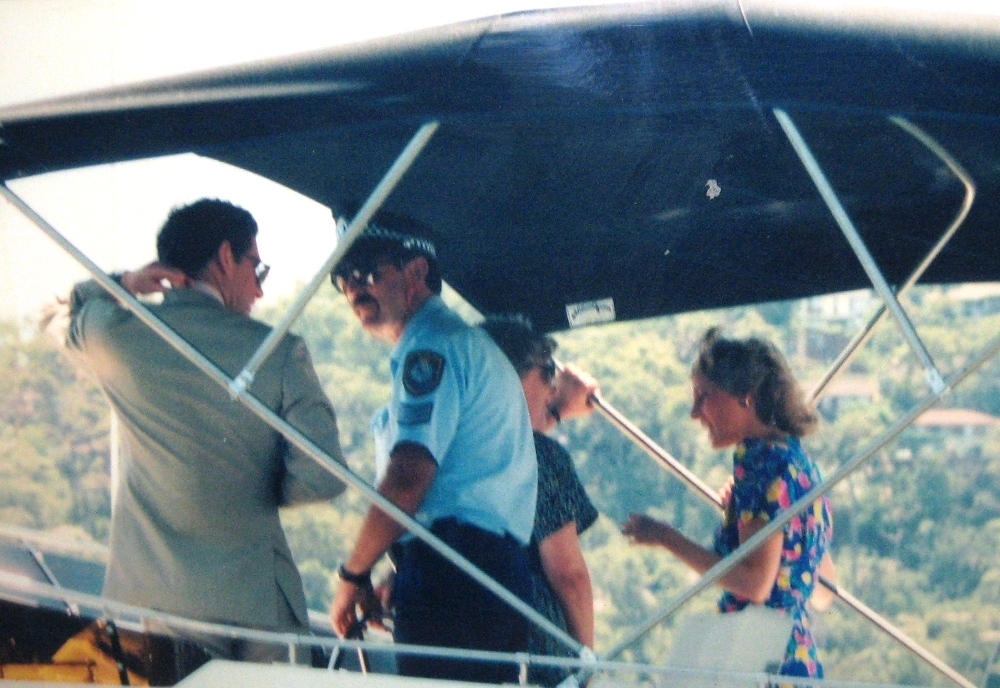
King Charles III founded the youth charity The Prince's Trust in 1976, sponsors The Prince's Charities, and is a patron, president, or a member of over 400 other charities and organisations. He has advocated for the conservation of historic buildings and the importance of architecture in society. A critic of modernist architecture, Charles has worked on the creation of Poundbury, an experimental new town based on his architectural tastes. He is also an author or co-author of a number of books.
An environmentalist, he has supported organic farming and action to prevent climate change as the manager of the Duchy of Cornwall estates, which has earned him awards and recognition from environmental groups.
The Queen's Commonwealth Canopy, established in 2014, bears testament not only to her ability to address current and historic concerns and her eldest son's own work in this field. The Queen's Commonwealth Canopy (QCC), was launched at the Commonwealth Heads of Government Meeting in Malta in 2015. It presents a unique opportunity to unite the whole Commonwealth family and save one of the world's most important natural habitats - our forests. By creating a pan-Commonwealth network of forest conservation projects across all 56 Commonwealth countries, the QCC will mark Her Majesty The Queen's service to the Commonwealth while conserving indigenous forests for future generations.
The QCC is the first environmental initiative in The Queen’s name and involves all but two Commonwealth nations, Togo and Gabon, who joined in the Commonwealth at the Rwanda CHOGM in June 2022, as announced then by King Charles III.
King Charles III sets a tone for the future that while it carries forward the best of the past, does so in a manner and way that embraces a universal consciousness that now articulates looking after all else here better than we have done so, as well as being kinder to each other.

President Joe Biden greets Britian’s Prince Charles, Tuesday, November 2, 2021, during the COP26 U.N. Climate Change Conference at the Scottish Event Campus in Glasgow, Scotland. (Official White House Photo by Adam Schultz)
Her Majesty's last visit to Australia occurred in October 2011, Prince William had preceded her earlier that same year to visit flood damaged areas of Queensland and Victoria.
The Queen visited Canberra, Brisbane, Melbourne and Perth during the tour. In Perth she attended the Commonwealth Heads of Government Meeting.
At a reception in her honour held at Parliament House in Canberra on 21 October 2011, the Prime Minister, Julia Gillard, described the Queen as "a vital constitutional part of Australian democracy". The Queen in her speech at the same reception stated that,
"It has been a difficult year for this country in many ways despite the successes. The world witnessed the anguish of Australians as they lived through a summer of national disasters. We were all inspired by the courage and resolution shown by those affected in the face of crippling desolation. Ever since I first came here in 1954 I have watched Australia grow and develop at an extraordinary rate. This country has made dramatic progress economically in social scientific and industrial endeavours and above all in self-confidence."
February 6th 2022, marked 70 years since The Queen acceded to the throne on the death of her father King George VI. Her Majesty went on to reign longer than any other British Monarch in history, and to become a beloved figure around the world.
On the eve of the 70th anniversary of her Accession to the throne, The Queen had written a message thanking the public and her family for their support, and looking forward to Platinum Jubilee celebrations over the coming year.

And now we have all lost her.
In an article written for The Conversation on Her Majesty's passing, Sean Lang, Senior Lecturer in History, Anglia Ruskin University, states:
The Queen’s most regular contact with her subjects was in her annual Christmas message on television and radio. This not only reflected her work and engagements over the previous year, but it reaffirmed, with greater frankness and clarity than many of her ministers seemed able to summon, her deeply held Christian faith.
As head of the Church of England she was herself a Christian leader and she never forgot it. The Christmas message adapted over the years to new technology, but it was unchanging in style and content, reflecting the monarchy as she shaped it.
Under Elizabeth II, the British monarchy survived by changing its outward appearance without changing its public role. Republican critics of monarchy had long given up demanding its immediate abolition and accepted that the Queen’s personal popularity rendered their aim impracticable while she was still alive.
Elizabeth II, whose 70-year reign makes her the longest reigning monarch in British history, leaves her successor with a sort of British monarchical republic, in which the proportions of its ingredients of mystique, ceremony, populism and openness have been constantly changed in order to keep it essentially the same. It has long been acknowledged by political leaders and commentators all over the world that the Queen handled her often difficult and delicate constitutional role with grace and remarkable, even formidable, political skill.
Her wisdom and unceasing sense of duty meant she was widely viewed with a combination of respect, esteem, awe and affection, which transcended nations, classes and generations. She was immensely proud of Britain and its people, yet in the end she belonged to the world, and the world will mourn her passing.
One of the Tributes shared across the globe that came in on Friday morning, Thursday evening U.K. time, and shared on Pittwater Online News social media platforms, also strikes a chord. Penned by an as yet unidentified poet, it reads:
Phillip came to me today,
and said it was time to go.
I looked at him and smiled,
as I whispered that "I know"
I then turned and looked behind me,
and saw I was asleep.
All my family were around me,
and I could hear them weep.
I gently touched each shoulder,
with Phillip by my side.
Then I turned away and walked,
with My Angel guide.
Phillip held my hand,
as he lead the way,
to a world where King's and Queens,
are Monarch's every day.
I was given a crown to wear
or a Halo known by some.
The difference is up here,
they are worn by everyone.
I felt a sense of peace,
my reign had seen its end.
70 years I had served my Country,
as the peoples friend.
Thank you for the years,
for all your time and love.
Now I am one of two again,
in our Palace up above.
Author unknown, September 8, 2022 UK time
Of course, in reality it is we who say to Her Majesty, Queen Elizabeth II - Thank you for your Service
The Queen and the Duke of Edinburgh’s enduring marriage saw them support each other through seven decades of Royal duties. They had four children, eight grandchildren and twelve great-grandchildren.

Her Majesty was known for her beautiful smile and great sense of humour and fun though, as shown in the 2012 'performance' with Daniel Craig as James Bond for the London Olympics. This is a pure delight, although you may see in her expression at the end Her Majesty is visibly moved at being so loved by so many for so long.
We love her still.
abridged References - extras
- Newport Wharf - History
- The First Royal Visitor To Australia: The Incident At Clontarf - March 12th, 1868
- Manly Children's Festival Federation Of A Commonwealth Medals Of 1901: Collecting Commemorative Medals - 1901 visit of the Duke and Duchess of Cornwall
- Legend Of The Racetrack Turns 100 by Steve Meacham
- Invictus Games Sydney 2018 Honours The Optimistic Generation
- Allan Collins - Profile
- Bruce Robertson OAM - Profile
- Gwyneth Sneesby - Profile
- Sir Adrian Herbert Frederic Curlewis - history page
- The Breakers at Beach Beyond 1901 – 2011 by Philippa Poole, daughter of Adrian Curlewis - history page
- Camping At Narrabeen – A Trickle Then A Flood
- Barrenjoey Artists' Commune In The Lighthouse Cottages: Post WWII Social Infrastructure Investment Enriched Australia's Cultural Evolution
- Pittwater Summer Houses: Waiwera - Hopton Lodge, Bayview
- Royal Visits to Australia - Jane Connors Celebration
- The 1957 Girl Guides Centenary World Camp At Windsor: A 65th Anniversary Celebration
- John Seaton MBE - Profile
- Ray Henman ACS
- Brian Friend OAM
- International Fleet Review 2013
The Queen's grandfather, George V (George Frederick Ernest Albert; June 3rd 1865 – January 20th 1936) was King of the United Kingdom and the British Dominions, and Emperor of India, from 6 May 1910 until his death in 1936.
This was the future king who came to Newport and 'Victoria' wharf on August 1st, 1881.
Born during the reign of his grandmother Queen Victoria, George was the second son of Albert Edward, Prince of Wales, and was third in the line of succession to the British throne behind his father and elder brother, Prince Albert Victor. From 1877 to 1892, George served in the Royal Navy, until the unexpected death of his elder brother in early 1892 put him directly in line for the throne. On Victoria's death in 1901, George's father ascended the throne as Edward VII, and George was created Prince of Wales. He became king-emperor on his father's death in 1910.
George's reign saw the rise of socialism, communism, fascism, Irish republicanism, and the Indian independence movement, all of which radically changed the political landscape of the British Empire, which itself reached its territorial peak. The Parliament Act 1911 established the supremacy of the elected British House of Commons over the unelected House of Lords. As a result of the First World War (1914–1918), the empires of his first cousins Nicholas II of Russia and Wilhelm II of Germany fell, while the British Empire expanded to its greatest effective extent. In 1917, he became the first monarch of the House of Windsor, which he renamed from the House of Saxe-Coburg and Gotha as a result of anti-German public sentiment. In 1924, George appointed the first Labour ministry and the 1931 Statute of Westminster recognised the Empire's dominions as separate, independent states within the British Commonwealth of Nations.
George suffered from smoking-related health problems throughout much of his later reign. At his death he was succeeded by his eldest son, Edward VIII, who subsequently abdicated and Queen Elizabeth's father became King George VI.
In 1932, George agreed to deliver a Royal Christmas speech on the radio, an event that became annual thereafter. He was not in favour of the innovation originally but was persuaded by the argument that it was what his people wanted. By the Silver Jubilee of his reign in 1935, he had become a well-loved king, saying in response to the crowd's adulation, "I cannot understand it, after all I am only a very ordinary sort of fellow."
.jpg?timestamp=1662846179655)
The King's Christmas broadcast, 1934. Scan from Foreword by E. Royston Pike (1938) Our Generation, London: Waverley Book Company
George's relationship with his eldest son and heir, Edward, deteriorated in these later years. George was disappointed in Edward's failure to settle down in life and appalled by his many affairs with married women. In contrast, he was fond of his second son, Prince Albert (later George VI), and doted on his eldest granddaughter, Princess Elizabeth; he nicknamed her "Lilibet", and she affectionately called him "Grandpa England".
In 1935, George said of his son Edward: "After I am dead, the boy will ruin himself within 12 months", and of Albert and Elizabeth: "I pray to God my eldest son will never marry and have children, and that nothing will come between Bertie and Lilibet and the throne."
George established a standard of conduct for British royalty that reflected the values and virtues of the upper middle-class rather than upper-class lifestyles or vices.
Those who were close to him found him:
A VERY HUMAN KING
Some New Sidelights Upon Royalty
By Our Special Representative
 THE approach of the jubilee celebrations has directed attention to many sides of the King's life. Lady Cynthia Asquith, in her new book, has concentrated rather upon the King as a family man and a very "human" person; and here is a selection of some of her stories'. —
THE approach of the jubilee celebrations has directed attention to many sides of the King's life. Lady Cynthia Asquith, in her new book, has concentrated rather upon the King as a family man and a very "human" person; and here is a selection of some of her stories'. —
LONDON, April 13.
IT is a human, but not less kingly figure for that, who looks out of the pages of "God Save the King," Lady Cynthia Asquith's new book on George the Fifth, which has just been published. For in a great variety of connections Lady Cynthia reveals deep humanity which has given the King n permanent place in the hearts of the British people. But perhaps none will appeal more than that delightful incident, when the royal grandfather, summoned back by Princess Elizabeth, was admonished by her thus: "Uncle England, you forgot to shut the door."
The very name, "Uncle England," oddly reminiscent of some Shakespearian jester familiarly addressing his liege lord, is as appropriate as any name could be. The other story of the King and the Princess found flat on the floor, searching under a sofa for something, and the King's explanation:
"We are looking for Elizabeth's hairslide," is already well known.
Not a few of Lady Cynthia's pages arc devoted to the King as a family man, very much a family man — "I shall soon have a regiment, not a family," he said, when the birth of his fourth son, now the Duke of Kent, was announced. To his Indulgence as a father once came an unexpected tribute from one of the young Princes who, asked, very tactlessly, whether he loved his father or his mother most, replied: "Well, you see, Dad spoils me most"
NO less happy are the incidents which reveal the real affection which exists between the King and his royal consort. Of his devotion to the Queen this story is told. Once, when she was ill and in pain, he was sitting beside her bed, holding her hand. The Queen fell asleep and the King, afraid lie might disturb her if he moved, remained motionless in a. cramped position for hours, until his own hand was quite rigid from the long vigil. Talking to a friend, he said once, with deep feeling:
"If anything were to happen to the Queen I should die..''
The Queen herself— "Mrs Queen." "Mrs England' and "Mrs Majesty," as she has been addressed on countless occasions by the humbler subjects of her husband— Is also seen in these pages in the garb of that rich humanity which she wears on intimate occasions, as convincingly as the robes die dons for great occasions of State. If she is not the simple housewife of popular legend— and that role would be impossible amid the multitude of tasks, public and semi-public which she is called on to do— she does exercise a real control over her household, and knows every servant in Buckingham Palace by sight and name. There is one very pleasant story of her which Lady Cynthia tells when the Prince of Wales, a very small boy, looking as bored as he really was during some interminable function, was gently admonished by his mother. "David dear, PLEASE smile," she whispered to him! »
THE King's affection for the Navy is very real. His regret at having to relinquish a naval career when he became Heir Apparent to his father on the death of his brother was intense. Lady Cynthia illustrates this by telling how, when a midshipman, the future King was asked if he had enjoyed his leave. "Yes, I was as happy as one can be off the sea," was his reply.
Once, in a letter home, he quoted Ruskin's words: "Take it all in all, a ship of the line is the most honorable thing that man as a gregarious animal has ever produced."
To this quotation he added his own words: "Certainly the sight of England's oaken and iron walls combined, tearing through the black water, fills one with a strength and joy such as nothing else can give." He was fifteen at the time. Lady Cynthia once heard an admiral say: "If ever I saw a young man with a vocation for the sea it was the King."
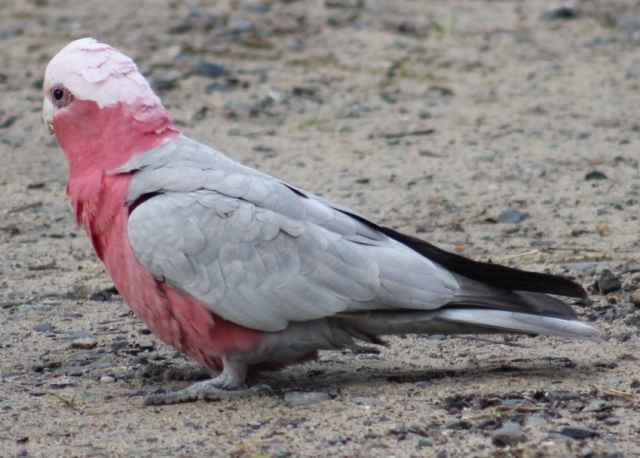 One of the King's pets, a grey and pink parrot, is a relic of his naval days. Charlotte was bought in Port Said when he was a young naval officer. She has a great command of nautical language and objects strongly to the wireless! In fact, when it is turned on, she has to be covered up. She likes to perch on the King's shoulder while he is working and more than one visitor has been startled by a raucous voice inquiring: "Well, what about it, what about it?"
One of the King's pets, a grey and pink parrot, is a relic of his naval days. Charlotte was bought in Port Said when he was a young naval officer. She has a great command of nautical language and objects strongly to the wireless! In fact, when it is turned on, she has to be covered up. She likes to perch on the King's shoulder while he is working and more than one visitor has been startled by a raucous voice inquiring: "Well, what about it, what about it?"
While the King was ill she inquired frequently for "Georgie," as she often calls him, croaking out: "Where's the captain?"
OF the King's tact with his humbler subjects many stories have been told. Lady Cynthia tells of his visit to a hospital during the war. Noticing a wounded man of venerable appearance, he asked him his age. Glancing quickly at the chart above his bed, the man said,
"I'm forty-five. Your Majesty."
"Yes, I know," said the King smiling, "I CAN read. But how old are you really?"
"I'm sixty-two, sir," was the reply.
There is another very human story of the King and Queen and an old bed-ridden woman of 95, who wrote asking that the Royal carriage should drive slowly past her window during one of the Royal progresses, her house being on the route. The King instructed the chauffeur to draw up as he reached the house, and he and the Queen talked to the invalid through the window.
In his constitutional role the King has excited the admiration of all political parties. Of the difficulties of that role he himself has never had illusions. "Knowing the difficulties of a limited monarch, I thank Heaven I am spared being an absolute monarch," he once said to the American Ambassador.
Writing of the King, another United States representative (Mr Walter H. Page) remarked: "The exact importance of the King in this Government I could not explain in three hours —if I could at all. But it is much more important than most men think. His real power grows out of his personality."
Lady Cynthia tells a good story of the King and President Wilson during the latter's State visit after the war. The President, after being greeted by the King at the station, asked where the police guard was.
"I fancy. Mr President," the King replied with quiet dignity, "that if you will keep with me, you will find yourself quite safe anywhere in my capital."
It will be a kingly figure, clad in all the dignity appropriate to his great office, which London will see when the King drives to St. Paul's for the Jubilee service on May 6, but one in which all Englishmen will plainly discern the lineaments of the man who has endeared himself to their hearts. (God Save the King, by Lady Cynthia Asquith, Chapman & Hall Ltd.)
.jpg?timestamp=1662845823040)
The King enjoys, the side shows at the Wembley Exhibition.
The King as Captain H.M.S. Crescent in the Royal Navy, 1898. A VERY HUMAN KING (1935, April 30). The Herald (Melbourne, Vic. : 1861 - 1954), p. 6. Retrieved from http://nla.gov.au/nla.news-article244973100
